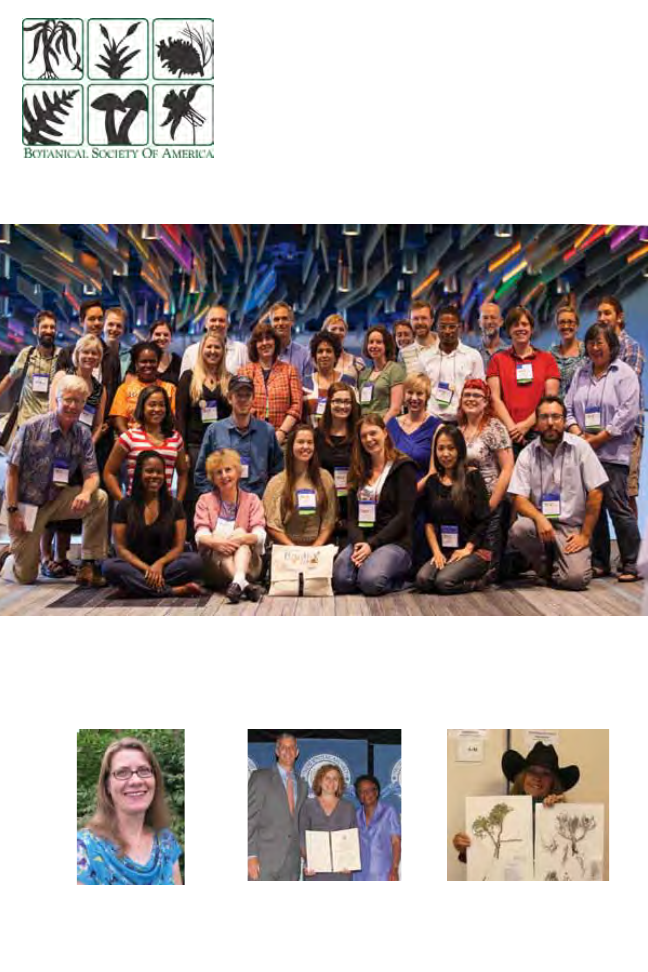
P
LANT
S
CIENCE
Bulletin
Fall 2012 Volume 58 Number 3
In This Issue..............
A labor of love......................p. 98
BSA Legacy Society Celebrates !...pg ??
2012 Merit Award Winners......page 38
Botanical Society of America’s PLANTs Grant Recipients and Mentors
Congratulations to Naomi Volain....p. 95
Introducing APPS......p. 81
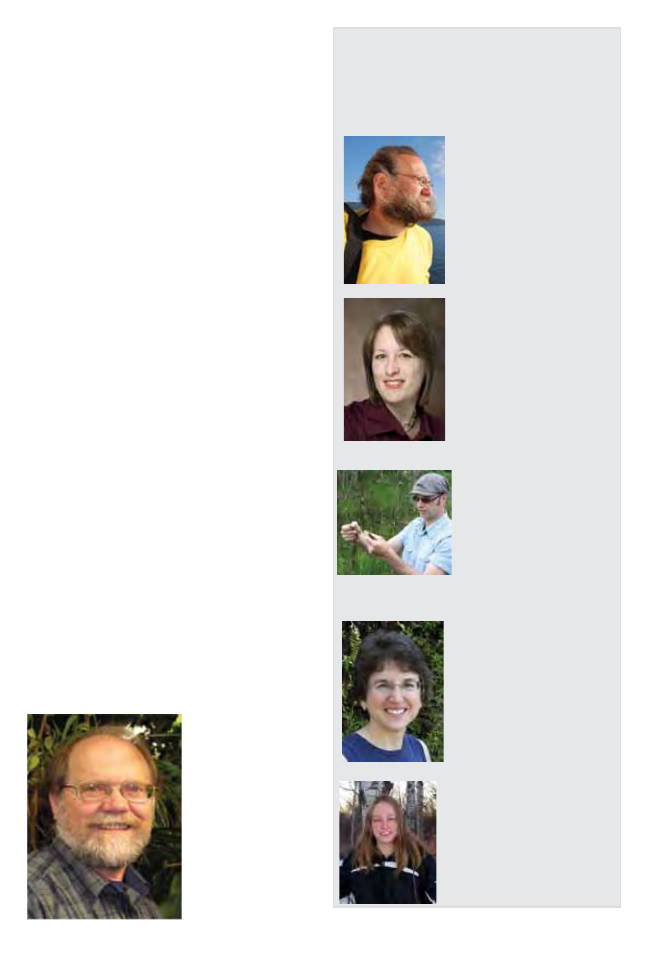
From the Editor
Fall 2012 Volume 58 Number 3
PLANT SCIENCE
BULLETIN
Editorial Committee
Volume 58
Root Gorelick
(2012)
Department of Biology &
School of Mathematics &
Statistics
Carleton University
Ottawa, Ontario
Canada, K1H 5N1
Root_Gorelick@carleton.ca
Elizabeth Schussler
(2013)
Department of Ecology &
Evolutionary Biology
University of Tennessee
Knoxville, TN 37996-1610
eschussl@utk.edu
Christopher Martine
(2014)
Department of Biology
Bucknell University
Lewisburg, PA 17837
c
hris.martine@bucknell.edu
Carolyn M. Wetzel
(2015)
Department of Biological Sci-
ences & Biochemistry Program
Smith College
Northampton, MA 01063
Tel. 413/585-3687
-Marsh
Lindsey K. Tuominen
(2016)
Warnell School of Forestry &
Natural Resources
The University of Georgia
Athens, GA 30605
lktuomin@uga.edu
“Even those of the younger generation realize
that within their time the feeling of the people
toward botany as a science and botany applied has
changed greatly for the good of the work. I believe
this is due to the fact that the utilitarian side of
botany has been kept largely in the foreground, and
the people have come to know and understand that
a substantial encouragement of the work means a
direct benefit to many important interests….I may
be preaching an heretical doctrine and be criticized
on the ground that science has nothing to do with
such material things and will take care of itself if
kept pure and undefiled. This may be true, but I have
long since reached the opinion that the doctrine of
science for science’s sake may be beautiful in theory,
but faulty in practice. Some one [sic] has said that
pure science and science applied are like abstract
and practical Christianity, both beautiful, but one is
for gods and the other for men.” These words were
spoken in 1903 by Beverly T. Galloway, outgoing
President of the Botanical Society of America, in
his Presidential Address (Science 19:11-18).
Galloway’s viewpoint was not shared by the
Society as it basked in the glory days of the early
20th century. But now, nearly 110 years later, we
live in a society that has little understanding of our
discipline and even less appreciation for its role in
society. It is timely to reconsider our connection to
applied plant science, especially in the agricultural
fields, and this is the challenge brought to us by
current President Elizabeth (Toby) Kellogg. We are
happy to be able to share her Presidential Address
from the annual meeting and hope that you will
seriously consider her suggestion to make the
connection between basic and applied plant science
“more explicit more often.”

77
Table of Contents
www.botanyconference.org
Society News
Erratum .............................................................................................................................78
Botany 2012 Presidential Address–Dr. Elizabeth A. Kellogg ..........................................78
New Journal Joins the BSA Family of Publications .........................................................81
A Behind-the-Secnes Look at the Botany Conference: Planning through
Execution and Future Challenges .....................................................................................85
Awards from the Annual Meeting.....................................................................................91
BSA Science Education News and Notes
PlantingScience ................................................................................................................94
Education Bits and Bobs ..................................................................................................95
Editors Choice Reviews ................................................................................
97
Announcements
Jacob Hoover Cowen Herbarium .....................................................................................98
Missouri Botanical Garden Receives $25,000 Grant For Development Of Advanced
Plant Data Collection System ...........................................................................................99
American Philosophical Society Grants .........................................................................100
Harvard University Bullard Fellowships In Forest Research .........................................100
Reports and Reviews
Botanical education in the United States: Part 2, The nineteenth century—
Botany for the masses vs. the professionalization of botany .........................................101
Book Reviews
..............................................................................................
132
Books Received
...........................................................................................
143
Botany 2013
Celebrating Diversity!
Hilton Riverside, New Orleans, LA July 26-31, 2013

78
Society News
Erratum
In Volume 58, Issue 2 of the Plant Science Bulletin,
Codi Yeager should have been listed as a graduate
of West Virginia University, not Cornell University.
We regret the error.
Botany 2012 Presidential Address
Dr. Elizabeth A. Kellogg
“Speaking of Food”
(Note: The video and slides from this lecture can
be found at http://www.youtube.com/watch?v=j1F
m0oEbW54&feature=plcp.)
Since this talk is right after a reception and right
before dinner, it seemed like a good time to talk
about food. This may seem like an odd topic for a
President’s address; after all, most people choose to
stick with the theme chosen for the meeting. But
I’ve been mulling over a question in my mind for
several months and decided to put it to you here
today. The question is this: Why do we, in this
particular scientific society [BSA], with its long
and distinguished tradition of research on plants,
so rarely connect what we do to agriculture? I’m
not planning on answering this question. Rather I
will explore it and conclude the talk with the same
Let me start with a bit of personal observation.
My first course in any sort of plant biology was a
plant ecology course, which I took my senior year
in college. I took it because it met after 9 AM,
had an early exam, and didn’t have a lab. In other
words, I was looking for an easy elective. After I
graduated, I worked in a biochemistry lab for a
while, realized that I didn’t really like killing rats
and started thinking about what else I could do.
I thought back to that plant course and ended up
working for the Forest Service for a while and then
went back to grad school. There were many things
from that first plant course that stuck with me, but
one of them is the following quote from Gulliver’s
Travels by Jonathan Swift. “And he gave it for his
opinion, that whoever could make two ears of
corn, or two blades of grass, to grow upon a spot of
ground where only one grew before, would deserve
better of mankind, and do more essential service to
his country, than the whole race of politicians put
together.” Obviously I did not go into plant breeding
or agronomy, but rather have had a career in basic
research. But I believe firmly in the continuum of
basic to applied research. I’m not out there growing
crops, but I hope that the folks who are might read
and be informed by the work that I do. And I’d like
to suggest that the work going on in BSA should be
relevant as well.
So let me repeat the question: Why don’t we
make more of a connection between the work
presented at this meeting or published in our
journals and the area of food for the planet? At
this point I should clarify what I mean by the word
“connect.” I’m speaking of those brief sentences
or paragraphs at the beginning or end of a talk or
article that place the work in its broadest possible
context, the sentences that link the work to issues
that the general public or at least the general
scientist might understand. These are sentences
that might get picked up in press releases or might
find their way into the Broader Impacts section of
a grant proposal.
As an example, while procrastinating on writing
this talk, I ran across an article that appeared in the
BBC Science and Environment section earlier this
week: “Antarctic moss lives on ancient penguin
poo.” The article, written by science writer Victoria
Gill, described the work of Prof. Sharon Robinson
“of the University of Wollongong in Australia,
[who] has been studying Antarctica’s plants for 16
years.” Dr. Robinson is not a member of BSA—I
checked. Her study had to do with nutrient capture
and frost tolerance in Antarctic mosses, and could
easily have been written by a member of the BSA.
The “connector” was written by Ms. Gill: “Learning
the molecular mechanisms behind plants’ abilities
to dry out but remain viable could help researchers
to develop ways to store food or even medicines for
long periods.” Just a very simple question taking
this basic research and putting it in a broad and
agricultural context.
So back to my question: Why is it rare to find
such references to food or agriculture in the talks at
this meeting and the articles in our journals?
This is particularly perplexing because
everybody eats plants. Therefore, knowing more
about plants is essential for everyone because they
have such an immediate impact on our lives, at
breakfast, lunch, dinner, snack time, and banquets
at conferences. When we introduce students or
the general public to plants, we immediately talk

79
Plant Science Bulletin 58(3) 2012
about the food we eat. We tell them that grapes are
fruits and onions are bulbs and celery is a petiole,
that bread is endosperm, that blueberries are
Vaccinium and cassava is Manihot. We point out
that cabbage is the same species as Brussels sprouts
and broccoli, even though the Supreme Court says
that the government can’t make you eat the stuff. A
recent article in Plant Science Bulletin by Geoffrey
Burrows and John Harper describes the value of
supermarket botany in teaching [www.botany.
org/plantsciencebulletin/psb-2009-55-2.pdf].
A search of all issues of PSB finds 12 references to
supermarket botany, the earliest in 1958. In other
words, there is an obvious and direct connection
between the study of plants and the practice of
agriculture and we mention it all the time.
So why do we not make the connection in
our research, at this meeting, in our journals?
I’m sure that some of you are thinking
immediately of the mission statement of the
BSA. We do basic research, not applied. We
are botanists, not breeders or agronomists. The
mission of the BSA is “to promote botany, the field
of basic science dealing with the study and inquiry
into the form, function, development, diversity,
reproduction, evolution, and uses of plants and their
interactions within the biosphere. To accomplish
this mission, the objectives of the Society are to:
sustain and provide improved formal and informal
education about plants; encourage basic plant
research; provide expertise, direction, and position
statements concerning plants and ecosystems;
and foster communication within the professional
botanical community, and between botanists and the
rest of humankind through publications, meetings,
and committees.” I’ve added italics here to the word
“basic.”
But we do not eschew applied research on
conservation. As an exercise, I chose two random
issues from the American Journal of Botany in
2011 and in about 10 minutes found the following
two random quotes. Random quote #1: “Climate
change and shifts in land use are two major threats
to biodiversity and are likely to disproportionately
impact narrow endemics. Understanding how
such species originated and the extent of their
genetic diversity will enable land managers to
better conserve these unique, highly localized
gene pools.” (Marcussen et al. (2011), Establishing
the phylogenetic origin, history, and age of the
narrow endemic Viola guadalupensis (Violaceae).
Am. J. Bot. 98: 1978-1988. http://www.amjbot.org/
content/98/12/1978.full.pdf+html?sid=7dc0972a-
7aca-4e9d-a297-2835f1f85756). Note in this case
that research on a narrow endemic in a family with
modest economic importance was justified in part
by the direct application to land management. Yes,
it’s basic science. But it also has implications for a
thoroughly applied discipline.
Random quote #2: “The effects of climate warming
on tree growth become more significant at northern
latitudes and high elevations, and the effects vary
across species…. Therefore, an investigation
on intra-annual growth over a large latitudinal
gradient may be able to detect a systematic change
in the start and end dates of xylem formation
during a growing season, thus assisting predictions
of forest productivity.” (Huang et al. (2011),
Variation in intra-annual radial growth (xylem
formation) of Picea mariana (Pinaceae) along a
latitudinal gradient in western Quebec, Canada.
Am. J. Bot. 98: 792-800. http://www.amjbot.org/
content/98/12/1978.full.pdf+html?sid=7dc0972a-
7aca-4e9d-a297-2835f1f85756). Once again the
article is basic research—developmental anatomy
to be precise, but the authors provide a connection
to forestry.
To summarize this point: we have no trouble
seeing a continuum from basic to applied research
in conservation and forestry. Studies that are
designed to help conservation managers make
practical decisions are surely just as applied as
studies that provide basic information that could
be translated to agriculture. So it can’t be just that
connection to agriculture is applied and we don’t
do applied stuff.
Are we concerned about working with the private
sector and/or worried about issues of intellectual
property? Much agricultural research and the vast
majority of plant breeding in the U.S. takes place in
the private sector and this brings with it concerns
about ownership of germplasm and research results.
And much agricultural research in the U.S. serves
the needs of large-scale conventional “industrial”
agriculture. But the fact that much biomedical
research takes place in the private sector doesn’t
block public sector research; obviously the public-
“Why is it rare to find such references to food
or agriculture in the talks at this meeting and
the articles in our journals?”

80
Plant Science Bulletin 58(3) 2012
private interface has to be negotiated and that will
happen in different ways by different people, but it
isn’t an intrinsically intractable problem. And there
are many potential jobs in the private sector for our
students.
There is plenty of agricultural research that goes
on in the public sector, especially outside the U.S.
And certainly industrial agriculture is only one
component of world food production. Smallholder
agriculture is common, whether it’s this CSA
[climate smart agriculture] farm in Missouri or
this sorghum field in Africa. Surely basic research
needs to be connected explicitly to efforts in this
sector.
Let me take a few minutes to remind you why
this problem is urgent, and argue that the BSA
needs to help address it. You already know about
projections of global population growth as shown
in this projection from the UN. Barring major
catastrophe, the decreasing projection will not
occur, and most people focus on the middle or
upper projections. This year the human population
of the world hit 7 billion. Projections of future
growth vary, but the median projection indicates
that we will add another 2 billion people by
2050. The good news about this projection is that
population may not grow a great deal higher than
that; the growth rate might (emphasize “might”) be
leveling off. But 2 billion more people in less than
40 years is a lot. Crop yield is increasing but not
as rapidly as the population. The FAO estimates
that world food production will have to rise 70%
to meet the demand. Food shortages have already
provoked instability in other parts of the world,
most recently the riots in Algeria that triggered the
so-called Arab Spring. And the challenge is made
more acute by climate change.
Let me also remind you of the speed of plant
breeding. It is generally slow; time to development
of a new crop is several years. Imagine an elite
line of wheat that is vigorous, high yielding, but
is susceptible to a fungus. Now suppose that you
find a small, low-yielding plant that is fungus-
resistant. How do you get the resistance gene
into the crop? Of course, you cross them and then
select for resistance; this takes about six months.
But in the first generation, the resulting plant is not
especially vigorous and has low yield; because it has
only half the DNA from the elite line and half from
the wild relative, the valuable, high-yield linkage
groups are broken up. The solution is to backcross
the first generation hybrid to the elite line; this
takes another six months to get seed. After six
backcrosses (about 2.5 years), you have mostly
restored the genetic make-up of your high yielding
line and have introgressed the resistance gene. It
is a process that works very well, but it is not fast.
By this point you are probably thinking, yes, this
is all very worrisome, but we aren’t crop scientists.
So let me cite a few areas that to me seem to connect
to agriculture.
First I should note the special issue of AJB on
Next-Generation Sequencing (http://www.
amjbot.org/content/99/2). Many of the articles
in this issue addressed evolution or genomic
structure of crop plants, or population structure
of weeds, or tools for crop improvement. Is it the
technology itself, the particular editors, or just
random chance that this issue connected work
of BSA members to agriculture in way that many
other issues do not? I don’t know the answer.
Another area where a connection could be made:
drought tolerance. Anyone living in the middle part
of the country this summer knows the importance
of identifying genes and developing crops that
tolerate drought. A lot of us work on plants that
are tolerant of drought. Their diversity, phylogeny,
biogeography, and phenology all provide examples
of how plants cope with water stress and could help
identify novel genetic or physiological pathways
that would be of value to agriculture.
Gene flow: There is certainly the direct
application of the study of gene flow to determine
the likely spread of transgenes from crops. I can
cite the work of one of our merit award winners,
Allison Snow, on this direct application. But the
applied work occurs within a theoretical and
empirical framework of population genetics and
population structure.
Pollination biology: There is ongoing concern
for the maintenance of honeybee populations
and a worry that without them, fruit crops will
not be pollinated. But there are many examples
in evolutionary history of pollinators changing
preferences. Do those examples provide any hints
about how the plant-pollinator relationship might
be modified to mitigate the problem? Or do all
the examples from evolutionary history really say
“The FAO estimates that world food production
will have to rise 70% to meet the demand.”

81
Plant Science Bulletin 58(3) 2012
that plants who lose a major pollinator go extinct?
I.e., does the phylogenetic history of pollination
biology tell us that the almond crop is inevitably
doomed if the honeybee population crashes? Or is
there something instructive that we can learn from
evolutionary history?
Model systems: As genetic and genomic tools
become cheaper and easier to produce, botanists
become less preoccupied with Arabidopsis or rice
and more willing to develop systems that offer
insights into particular biological problems. I’ve
been involved in the development of green millet
(Setaria viridis), which is being pursued for several
reasons, in part as a handy species in which to
study the regulation of C
4
photosynthesis, with the
ultimate goal of making a C
4
strain of rice. Why
was I involved? Because my lab has used S. viridis
as a system in which to study the regulation of
plant architecture (basic research). We’ve studied
developmental morphology, quantitative genetics,
molecular phylogeny of the genus Setaria, and
written a monograph. Currently we are working
on population genetics, collecting S. viridis from
its native habitats. And yes, others led the effort to
sequence the genome and develop a transformation
system, but it took a lot of basic—BSA-type—
research to make the model that is being used to
improve crops.
I mention this because it is my own experience,
but I could also cite the Planetary Biodiversity
Inventory project on Solanaceae, and many
equivalent projects in Brassicaceae.
I could keep going with examples, and in fact I
cut about six more out of this talk. But you get the
point: understanding plant evolution, systematics,
diversity, ecology, development, and interactions
matters as much for agriculture—which we often
don’t mention—as it does for conservation—which
we mention a lot.
So as you proceed to the banquet, as you enjoy
that fermented grape or barley product, the plate
of Asteraceae leaves, the avian-processed grass, and
as you conclude with your rubiaceous beverage,
consider that it is really your work that helped put
that in front of you in that form. BSA research does
contribute to feeding the world. We all know the
connection is there. Why don’t we make it more
explicit more often?
New Journal Joins the BSA
Family of Publications
In January 2013, the BSA will launch a new peer-
reviewed journal, Applications in Plant Sciences
(APPS), designed for the rapid dissemination of
newly developed tools and protocols in all areas
of the plant sciences that are represented within
the Society. This is an exciting opportunity for
the BSA to take advantage of the Society’s wide
breadth of expertise represented by the different
societal sections, and especially to address growing
technological advances in many of these areas. Today
our world is much different than just a decade ago
as techniques, such as next-generation sequencing,
GIS (Geographical Information Systems), gene
and genome manipulation, and cell/tissue labeling,
are dramatically propelling fields forward and
becoming the standard in many laboratories. These
advancements are also enabling scientists to delve
into rarely studied areas; for example, researchers
can now more effectively examine belowground
soil dynamics and soil communities, as well as
nutrient uptake and exchange within the complex
root networks of forest ecosystems. The availability
of social media and smartphone technology today
also presents unfettered opportunities for botanical
applications, such as computerized recognition of
leaf and flower shapes to identify taxa. In addition,
certain fields are beginning to intersect, leading
to the formation of new areas (e.g., landscape
genetics), and creating opportunities to combine
both traditional and novel methods from different
areas. APPS is the new source for reporting such
advancements, consistent with its purpose to foster
communication within the botanical community
to advance research in the plant sciences. As such,
APPS will complement and support AJB because
the new journal will serve as the publication outlet
of methodological information and techniques
that can then be used in more extensive studies
published in AJB.
As an online-only journal, APPS will be part of
BioOne’s Open Access Collection (www.BioOne.
org/) so that articles will be freely accessible
to readers worldwide. BioOne was specifically
selected because the mission and priorities of this
not-for-profit organization align closely with those
of the BSA, as well as for its emphasis on serving
independent society publishers within the greater
community

82
Plant Science Bulletin 58(3) 2012
researchers in the years and decades to come. For
example, as an online-only journal, authors will be
able to incorporate multimedia files (e.g., videos
demonstrating the application of a new method
or animations portraying a new process) into
their articles. There is also the opportunity to link
data within an article directly with an appropriate
online source using hyperlinks for instant access.
This could consist, for example, of DNA sequence
information deposited in GenBank (http://www.
ncbi.nlm.nih.gov/genbank/), media housed on
Figshare (http://figshare.com/), or ecological data
uploaded to Dryad (http://datadryad.org/), an
international repository that accepts data of all
formats, including software scripts.
Submitting to
APPS
All authors are invited to consider APPS as a
publication outlet and the Editors are currently
recruiting submissions for the introductory
issues. Authors wishing to contribute papers to
APPS should submit their manuscripts online
through AJB’s Editorial Manager page (http://
www.editorialmanager.com/ajb), using the article
type “Applications in Plant Sciences.” Online
submission through the AJB site will continue until
the official APPS submission site is available, which
is expected in early September. While primer notes
will continue to be accepted for consideration, the
History
Although debuting in 2013, APPS has been in
the making for several years. The journal originated
as the American Journal of Botany’s online-only
section, AJB Primer Notes & Protocols in the Plant
Sciences (AJB PNP), which was begun in 2009
to serve as a publication outlet for researchers
in genetic and molecular areas. The section was
created by Editors Kent Holsinger, Pamela Soltis,
and Theresa Culley with AJB Managing Editor Amy
McPherson and Production Editor Richard Hund
and with the approval of AJB Editor-in-Chief, Judy
Jernstedt. At the time, authors had very few options
for where to submit primer notes papers, especially
those containing a limited number of loci or limited
sampling (as in the case of rare or endangered
species). BSA recognized the value of these articles,
especially in terms of their importance for new
researchers seeking publication or scientists
wishing to publish markers as the foundation for a
new study. Consequently, AJB PNP was created in
part to address these needs.
This online section of AJB was highly successful,
with annual submissions reaching over 200
manuscripts in 2012. To handle this increased
volume, Beth Parada was recruited as Online
Publication Editor to oversee the AJB PNP section,
and several other editors were subsequently invited
to join the editorial board, including Lisa Wallace
and Mitch Cruzan, among others. In 2011, a
revolving panel of reviewing editors (typically
post-doctoral researchers and junior faculty)
with two-year appointments were recruited to
assist in the editorial process. The majority of the
early submissions were primer notes, with most
reporting microsatellite or similar PCR-based
markers developed in different plant species.
Although some protocol papers were published,
these addressed genetic or molecular methods.
In early 2012, the BSA Board of Directors, in
conjunction with the Publications Committee, AJB
PNP editors, and BSA staff, decided to graduate
the online section of AJB to its own journal, now
titled APPS. In doing so, the BSA wanted to expand
the breadth of the new journal to focus on new
protocols and techniques in all areas represented
by the BSA (including, but not limited to, genetics
and molecular biology). APPS will still continue to
publish primer notes for genetic markers such as
microsatellites and SNPs (see below).
The new journal has been designed to be flexible
in responding quickly to the demands and needs of
Theresa Culley, Editor-in-Chief, APPS

83
Plant Science Bulletin 58(3) 2012
editorial board especially encourages submissions
of protocols that improve investigations in any
area of plant biology, including methods on
genetic markers, and morphological, physiological,
biochemical, anatomical, and ecological data
collection.
Publications will include both invited papers
and those submitted through the usual review
process. For submission guidelines, please consult
the Instructions for Authors (http://www.botany.
org/ajb/APPS_Online_Instructions.html). Papers
will be accepted for publication in the following
categories:
• Protocol Notes: These papers will report new
protocols and technical advancements in any
area of the plant sciences. Authors must explain
the rationale for the new protocol, provide a
complete description, and demonstrate that
the new method is advantageous over current
techniques. A printable protocol sheet for the
laboratory bench as well as a supply list are also
encouraged as appendices.
• Application Notes: Longer articles
incorporating and emphasizing a new protocol
or method in a larger study (i.e., with more
extensive sampling than that in a Protocol
Note) will be published under this category.
Submissions could involve any area within the
plant sciences.
• Review Articles: In this category, available
techniques and/or protocols within a given
area of the plant sciences will be reviewed,
emphasizing the relative advantages and
disadvantages of each. Articles must describe
and compare currently available techniques
or protocols, as well as identify any potential
new areas for development of technological
advancements. These articles will usually be by
invitation, although any author is welcome to
discuss a review article concept with the editorial
staff prior to submission.
• Primer Notes: These articles must report a
large number of novel, polymorphic markers
with evidence of wide applicability (e.g., cross-
amplification with related taxa) for species of
scientific, economic, or horticultural importance.
These could include, but are not limited to,
microsatellite markers, SNPs, or other types of
markers. If primers have previously been published
for a species, authors must justify the development
and usefulness of additional primers. Markers
developed using novel techniques are especially
welcome.
As with any new journal, APPS currently does
not have an impact factor, but will be evaluated for
inclusion in the Science Citation Index (SCI) in
March 2013. If the evaluation is positive, indexing
will be retroactive to the first issue of the journal,
and APPS will receive an immediacy index after
one year of publication. Two years of publication
are required for calculation of an impact factor;
this is expected to be available in June 2015. Any
questions regarding submissions may be directed
to Beth Parada (bparada@botany.org), Online
Publication Editor for APPS.
Vision for the Future
The development and launch of APPS this
coming year is an example of the BSA’s strategic plan
to promote botany by pursuing new opportunities
as they arise. Consistent with the BSA’s objectives
to encourage basic plant research and to foster
communication within the professional botanical
community, the new journal will serve as a
conduit for information based directly on the
expertise offered by the Society and the sharing of
which information will directly benefit members
of the Society. As the centennial year for AJB
approaches and the BSA reflects on its critical role
in promoting decades of high-quality botanical
research, it is fitting that the next century brings
new opportunities such as APPS to broaden further
the role and impact of the BSA over the years and
decades to come.

84
Plant Science Bulletin 58(3) 2012
Call for Applications:
APPS 2013–2015 Reviewing Editor Board
The Botanical Society of America is seeking interested applicants to serve on the Reviewing
Editor Board for Applications in Plant Sciences, BSA’s new online-only, open access journal that is
launching from the AJB Primer Notes & Protocols section in 2013. The Reviewing Editor Board
will be comprised of a select number of post-doctoral researchers and graduate students who have
advanced to candidacy; Reviewing Editors will evaluate original submissions according to criteria
established for the journal and provide feedback to the Associate Editor. Reviewing Editors will also
assess revised manuscripts for adherence to comments and suggestions. Members of the Reviewing
Editor Board will be expected to handle up to two manuscripts per month and to agree to a 2-year
commitment. Members of this board will be mentored by the APPS Editorial Board members and
receive experience in the editorial and peer-review processes. Successful editors will also receive
reduced registration rates to the annual conference of the BSA.
Applications must include a cover letter from the applicant, CV, and a letter of recommendation
from the applicant’s supervisor or major professor. Successful applicants will demonstrate an
attention to detail and an interest in gaining experience in this important aspect of academic service;
information on scheduled time in the field during the commitment period, if known, should also be
provided.
Applications should be sent to apps@botany.org by September 21, 2012.
Applications in Plant Sciences Editorial Board
Theresa Culley, Editor-in-Chief, University of Cincinnati, Cincinnati, Ohio
Richard Cronn, Associate Editor, USDA Forest Service, Corvallis, Oregon
Mitchell Cruzan, Associate Editor, Portland State University, Portland, Oregon
Kent Holsinger, Associate Editor, University of Connecticut, Storrs, Connecticut
Jeff Maughan, Associate Editor, Brigham Young University, Provo, Utah
Mike Moore, Associate Editor, Oberlin College, Oberlin, Ohio
Pamela Soltis, Associate Editor, University of Florida, Gainesville, Florida
Lisa Wallace, Associate Editor, Mississippi State University, Starkville, Mississippi
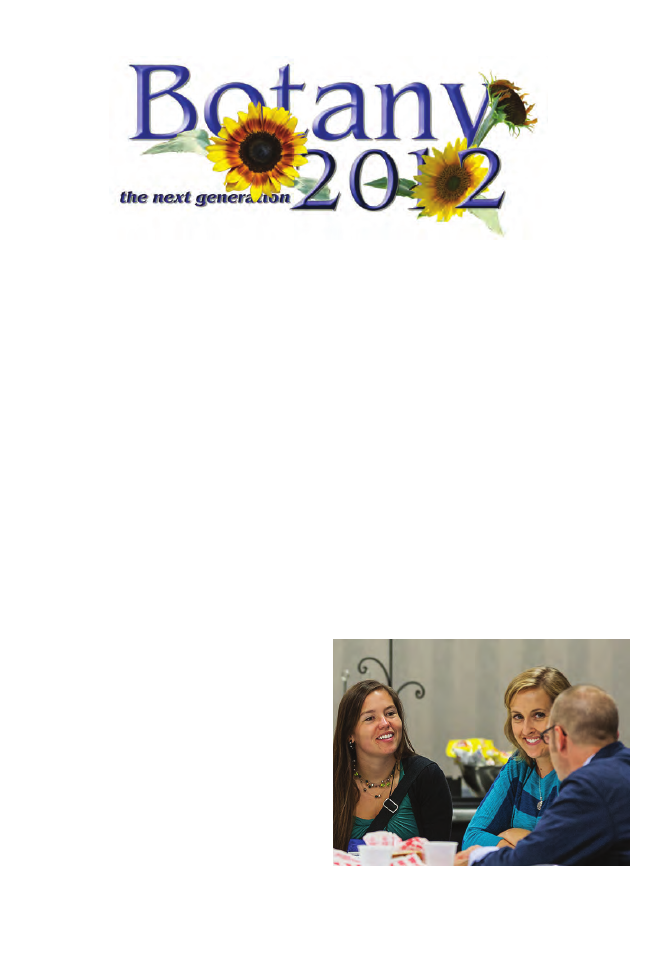
85
Plant Science Bulletin 58(3) 2012
meeting space, which keeps the conference cost
down—making attending the Botany conference as
affordable as possible for you. You can see that it
is crucial that we meet our hotel room blocks. We
try to negotiate fair hotel room rates in each city so
that it’s a win for both sides. Amenities including
free internet, free breakfast, and free snacks make
your stay more enjoyable and hopefully encourage
your decision to choose one of our hotels and help
us keep conference costs down.
The real planning for Botany 2012 started last fall,
with detailed site visits. At this time we identified the
Program Committee who determined the scientific
content of the conference, and began working
with volunteers to determine field trip locations,
guides, and costs. BSA staff builds the Botany 2012
website and more plans are finalized. Symposia
are submitted and funding is determined, Special
Lecture speakers are identified and planning begins
for workshops and other events.
Networking remains one of the most important
reasons for attending the Botany conferences.
A Behind-the-Scenes Look
at the Botany Conference:
Planning Through Execution
and Future Challenges
The Botany 2012 conference is just a memory,
and based on the recent attendees’ survey, it looks
like it was a very good memory. Here are a few
of the statistics that resulted from the over 222
attendees who responded to our questions: 87% of
respondents rated this meeting as one of the best
Botany conferences they have attended, 92% stated
that registration was easy, 80% felt that the abstract
submission site was user-friendly, 71% purchased
or are considering purchasing a product from one
of our exhibitors, and 61% stated they are unwilling
to pay an extra conference fee for WiFi at the
meetings.
Do you ever wonder how the Botany conference
really operates? We are about to give you an insider’s
look into the planning of a Botany conference as
well as a discussion of some of the most recent and
pressing challenges for planning future meetings.
Botany 2012 planning actually began about
three years ago with a decision not only to bring
the conference to Columbus, but also with an
estimate that 800 of you would attend. With that
estimate, we negotiate and guarantee a certain
volume of business to the conference location and
surrounding hotels. We have to provide a guarantee
to the hotels and conference center for a specific
number of hotel room nights and session rooms. In
addition, we had to guarantee that we would spend a
minimum of $100,000 on food and beverage. All of
this information goes into the contract to establish
the base conference cost. If we reach the guaranteed
hotel room nights and food and beverage estimates,
the session rooms are free, but if we come up short
from the estimates made 3 years in advance, we
could incur tens of thousands in additional rental
fees and penalties. It is our intent to never pay for
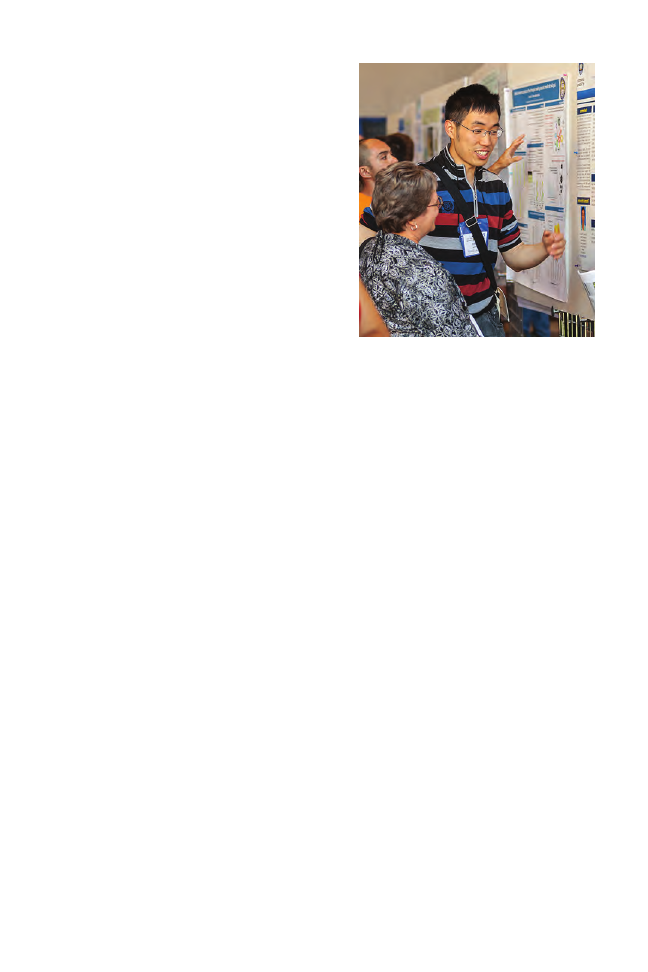
86
Plant Science Bulletin 58(3) 2012
Turning the poster session into more of a social
event has been very well received.
Then there are the variables. Each year is a
different location, with a different local team. Every
year, we must establish expectations. For example,
some of you have been with us to Snowbird, both
times. Many people said the second time was better.
That’s because everyone knew what was expected,
and worked to do their part. Our goal is always to
make it right the first time, and there are always
challenges. One of this year’s major challenges was
that we actually met in 2 separate facilities. The
session rooms, the banquets, the registration desk,
and the Sunday evening Plenary Address were part
of the Hyatt complex. The exhibit hall, the Sunday
night mixer, coffee breaks, lunch in the mezzanine
in the exhibit hall, and the poster sessions were in
the Columbus Convention Center. Two different
facilities, two different conference contracts, two
different staffs to interface with, and two different
sets of BEOs! If you never realized that, then we
were successful.
Every year, we deal with potential cost impacts.
In some conference centers, coffee has been
upwards of $100/gallon, and we drink a lot of
coffee! This year we had about 36 “no shows” for
poster sessions. That means we ordered 9 more
poster boards at $50.00 plus labor and services
charges each. That’s money we didn’t have to spend.
If someone needs internet service in a session room
at the last minute, that equals more dollars. And the
Starting in the spring, we begin to firm up our
program with the abstract submission process.
April 1st is the normal abstract submission deadline.
This is also a big day for the conference, as it will
help validate our estimate from three years earlier
of how large the conference will be. We can now
determine how many sessions and programs
we will have based on the number of abstracts
submitted. Now the program committee goes to
work—forming the sessions, their length, how
many abstracts will be presented, estimated session
attendance, audio-visual needs, etc. Based on these
details, a schedule is created and session rooms are
assigned based on what the conference center has
allocated to us. At this point, we are assigning room
sizes for sessions, and still guessing how many
attendees will really show up!
May and June arrive, and conference registrations
are rolling in. June is always the scramble month.
During this time, the program and abstract books
are finalized and sent to the printer. T-shirts,
conference bags, and water bottles are designed
and ordered, field trip buses are determined, and
the biggest and most important part of running
the conference begins to shape up. Banquet Events
Orders, or BEOs, are submitted. BEOs are the
event orders that the conference organizers request
that the hotel or conference center perform for us.
If an event requires food or beverage, then there
is a cost that needs to be paid. BEOs include every
detail of every session and event. Botany 2012 had
293 different BEOs. How many tables and chairs
are needed, and how are they arranged? How many
cups of coffee, cookies, scrambled eggs, sandwiches,
or, most importantly, even more cookies, are
needed? If it’s not on a BEO, it won’t happen.
The Botany conference organizers also work with
many third-party suppliers and vendors. We have a
number of “legacy partners” that follow us around
the country and support us each year. All of our
shirts, bags, and water bottles come from an Austin,
Texas, partner; our printing (books and signs)
is always done by the same printing broker; and
our field-trip buses are arranged by the same bus
broker. Among the most valuable of our partners is
our AV team of Jake and Eric who make sure your
presentations appear as you wish them to. Each of
these partners has been part of the team for several
years; they know how the conference works, and
how they support the conference and you.

87
Plant Science Bulletin 58(3) 2012
also hear: “We need more chairs here, it’s too cold
in there, can we have 5 more for this lunch, I lost
my banquet ticket, I didn’t know I had to pre-order
audio speakers for my session, the projector is not
showing the correct reds in this session room, the
coffee is out and there is 5 minutes left in the coffee
break session, can I print 50 copies from your
computer, someone told me to come to the office
and pick up my check.” The list of items goes on
for the next 5 days. Hopefully, we keep everything
running smoothly and everyone is as happy as
possible. Next time—come on in and say “hi!”
The conference has evolved over the past few
years to be more than just a scientific
meeting. We have added new events,
more networking opportunities, and
more fun! We have been working to
expand and enhance the exhibit hall. We
have made the poster session more of an
event and social time. We have included
more students in the planning process to
be sure they have a voice and presence
at the conference. And this year, we
expanded the opportunity for the BSA
incoming president to reach more people
by hosting the talk before the banquet on
Wednesday evening. If you would like
to watch the presentation by Dr. Toby
Kellogg, “Speaking of Food,” it is at the
BSA’s YouTube channel (http://www.
youtube.com/watch?v=j1Fm0oEbW54&feature=plcp).
Another exciting event in the past two
conferences has been the “Botany in Action”
Program. This opportunity started as a way to give
back to the communities that we visit. This year,
about 30 eager botanists went to a local community
garden, in the massive heat of July, and harvested,
weeded, planted, gardened and helped with this
local project (see the following page). This event
will continue at Botany 2013 as we will look for
another local New Orleans organization that might
benefit from eager volunteer time.
Currently, the most challenging and potentially
costly part of conferences is WiFi. Hotels and
conference centers have farmed those services out
to third-party internet suppliers, and they all know
that with the explosion of personal devices, WiFi has
grown to be a profit center for them and a huge cost
and item to negotiate for us. You may get your home
internet service for something like $39/month. For
the Botany 2012 conference, the initial price quoted
was in excess of $28,000. We negotiated downward
biggest cost variables: we don’t hit our guaranteed
hotel room nights for the conference, or we spend
less than the minimum on food and beverage. That
can cost us tens of thousands of dollars, and we only
find that out after the conference.
Panic mode, 2 weeks before the conference! That’s
when we realize we planned for 800 attendees, and
now 1,100 have registered online. So we scramble
and double-check everything—making sure we have
enough bags and program books, making sure the
session rooms are big enough. Did we order enough
coffee for the continental breakfast? We may need to
relocate a session room, but the program book and
Hands-on learning activities in the exhibit hall were a hit.
schedule are already being printed. We are
constantly revising and changing BEOs, to make
sure everything is perfect and runs seamlessly.
Friday afternoon before the conference starts, we sit
down at the hotel/conference center with the head
of each department and walk though the BEOs.
It’s like the conductor going through the music
right before a concert. Everything is set, and then
we open the doors. And then someone comes up
to me and says that the room for speaker Dr. X is
just not big enough….so now we have to move a
session. That’s ok—we can do it! It’s only 2 more
signs to make on top of the 275 we already planned
to place around the conference. On Friday evening,
registration opens and the real magic begins.
Botany 2012 is alive and takes on a life of its own!
The real hub of the conference is the office….
We are always there to answer questions, make
snap decisions, or offer you a leftover cookie. We

88
Plant Science Bulletin 58(3) 2012
In the future, we are looking for more ways to
keep the conference “alive” throughout the year.
Many of you have participated in having your
poster videotaped for our virtual poster session
on the web. Many of you have expressed interest
in viewing video clips from special addresses and
invited speakers, as well as reviewing talks online
through PowerPoint slides that are linked to the
audio presentation. We hope to have some of the
special addresses and talks from 2012 on the web
soon, so that you can review them, share them with
colleagues or in your lecture halls, or see them if
you missed it the first time.
It is our hope that you continue to enjoy the
Botany conferences. We certainly enjoy organizing
them and working to keep it a worthwhile,
economically feasible, scientifically relevant, and a
fun week for you! If you have thoughts and ideas
that you would like to see at YOUR conference, feel
free to email me at Johanne@botany.org We will
consider anything. As Bill Dahl, BSA Executive
Director says, “We’re Botanical—we can do
anything”.
-Johanne Stogran, Director of Conferences, BSA,
with help from Kevin Stogran, Conference Chief
Minion and Heather Cacanindin, Membership
Director, BSA
from there. Sure, their initial offer is a great WiFi
package, with internet access everywhere in the
conference center. To provide that we would have
to increase registration fees $25 per person. Not
willing to raise your rates, we negotiated, argued,
and complained. After a number of weeks, we
were able to reduce the cost significantly to less
than one third of their initial offer, but we had to
reduce the coverage area. Knowing that we had
negotiated for free internet in your hotel rooms,
we hoped that access would be sufficient. This
might be sufficient for some. However, we realize
that connectivity is important to many of you for
tweeting, sharing conference knowledge with those
in your labs/home institutions not in attendance,
and connecting with people during the conference.
Don’t be offended when someone opens their laptop
or iPad during your talk—they just might be taking
notes on the wisdom you are sharing or tweeting to
their colleagues and friends with a quote from your
presentation. We will look at ways to be able to
provide more internet access while keeping it cost
effective. Along these same lines, we are planning to
release a mobile conference app which can be used
on personal devices to create your own personal
schedule, view it, and make adjustments to it while
on site.
Our exhibitors are a very important addition to the meeting, and 71% of Botany
2012 attendees purchased or are considering purchasing a product from one of our
exhibitors.
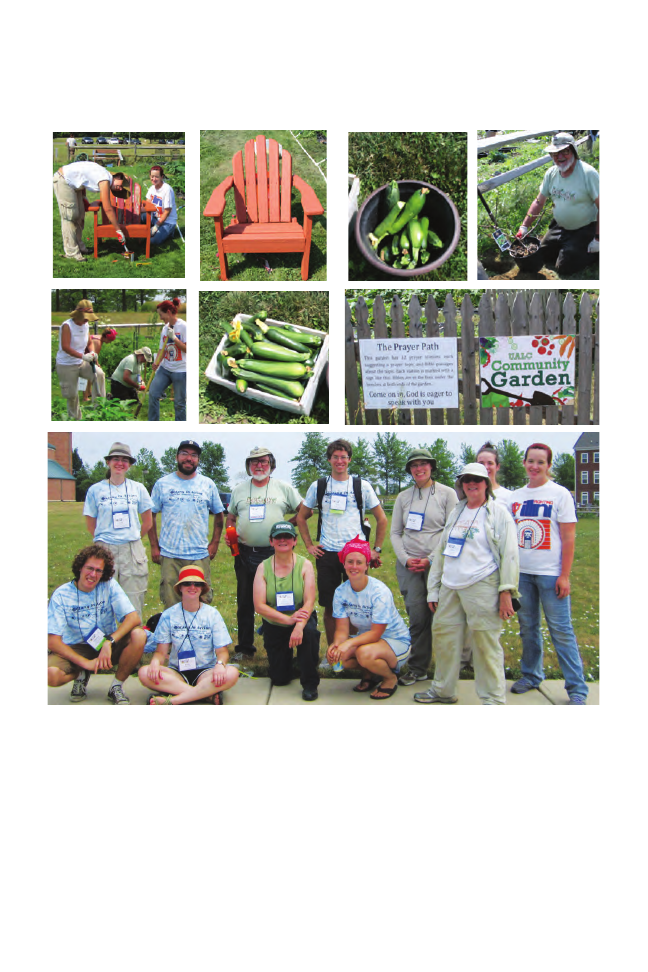
89
Plant Science Bulletin 58(3) 2012
The Botany in Action team braved the brutal heat to help the Upper Arlington Community Garden—weeding, clear-
ing, harvesting, painting and gardening in the annual project. Watch for ways you can participate in New Orleans.
(Thanks to Janice Coons and Gianinne Loerch for the pictures)
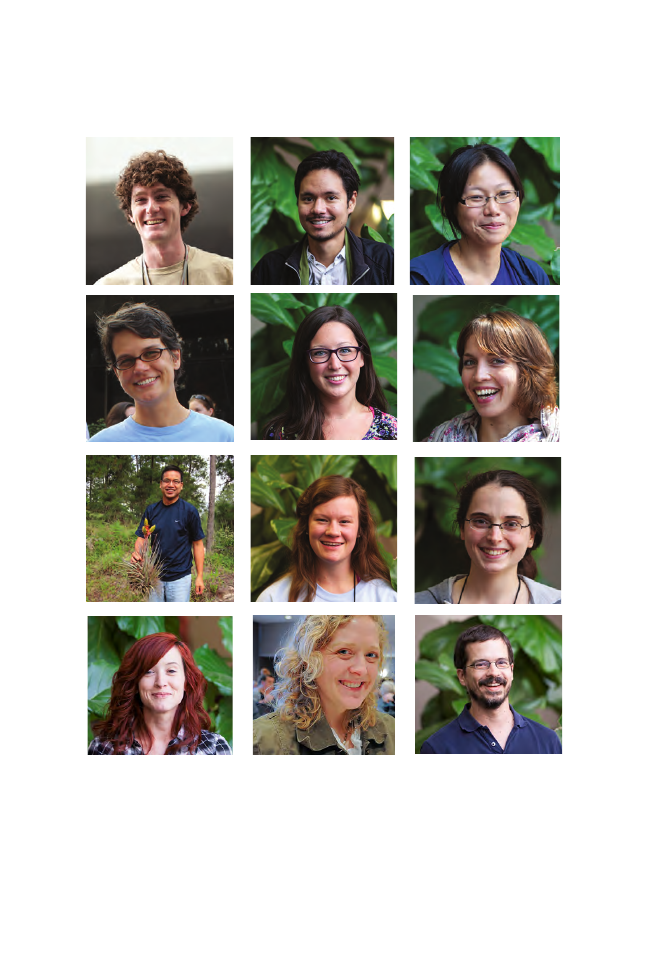
90
Plant Science Bulletin 58(3) 2012
The Faces of Botany 2012 Award Winners
Congratulations to these and all the winners. For a complete listing of all awards, see:
http://botany.org/awards_grants/2012Awardrecipients.php.

91
Plant Science Bulletin 58(3) 2012
Awards from the Annual
Meeting
Charles Edwin Bessey Award
(BSA in association with the Teaching Section
and Education Committee)
Dr. Paul Williams, Professor Emeritus,
University of Wisconsin–Madison, Fast Plants
Program. Dr. Williams developed a rapid cycling
Brassica. This simple act changed the way science
is taught in the United States and around the world.
Today, over 10 million students use Fast Plants,
as they are also known, every year. Fast Plants
complete their life cycle in as quickly as 35 days,
allowing students to develop an understanding of
the plant life cycle and track the results of genetic
experiments. Dr. Williams is a familiar figure at
conferences, leading workshops that introduce
teachers to inquiry-based, innovative, and
inexpensive ways to use Fast Plants with large
lecture hall classes or small groups in classrooms.
He was also a contributor to educational manuals
such as “Exploring with Wisconsin Fast Plants,”
“Spiraling Through Life with Fast Plants,” and
“Bottle Biology.” He has received many awards and
honors, including being recognized as a Fellow of
the National Academy of Sciences and a recipient
of the Eriksson Medal from the Royal Swedish
Academy of Sciences.
Drs. Les Hickock and Thomas R. Warne,
University of Tennessee. Drs. Hickock and Warne
collaborated on the development and genetics of the
tropical fern Ceratopteris. They realized that this
plant would make a powerful educational resource
because of the rapid life cycle, the dynamics of sperm
motility, and the potential of investigating density-
dependent changes in gametophyte development.
They produced instructional materials to support
inquiry education, such as an intriguing exploration
of sperm chemotaxis. Today, Ceratopteris is
distributed worldwide in K–16 classrooms through
the C-Fern program.
Special Awards
Dr. Judy Skog, Outgoing BSA Past-President,
George Mason University.
The BSA presented a special award to Dr.
Skog expressing gratitude and appreciation for
outstanding contributions and support for the
Society. Judy has provided exemplary contributions
to the Society in terms of leadership, time, and
effort.
Dr. Pamela Diggle, Outgoing Secretary,
University of Colorado.
The BSA presented a special award to Dr.
Diggle expressing gratitude and appreciation for
outstanding contributions and support for the
Society. Pam has provided exemplary contributions
to the Society in terms of leadership, time, and
effort.
Dr. Chris Haufler, Outgoing Director-at-large
for Education, University of Kansas.
The BSA presented a special award to Dr.
Haufler expressing gratitude and appreciation
for outstanding contributions and support
for the Society. Chris has provided exemplary
contributions to the Society in terms of leadership,
time, and effort.
Marian Chau, BSA Student Representative to
the Board, University of Hawai’i at Manoa.
The BSA presented a special award to Marian
expressing gratitude and appreciation for
outstanding contributions and support for the
Society.
Isabel Cookson Award
(Paleobotanical Section)
Established in 1976, the Isabel Cookson Award
recognizes the best student paper presented in the
Paleobotanical Section.
Ashley Klymiuk, University of Kansas. Advisor:
Dr. Thomas Taylor. 2012 award recipient for the
paper, “Anamorphic fungi from the Princeton
Chert: New insights into paleomicrobial diversity.”
Co-authors: Thomas Taylor and Michael Krings.
George R. Cooley Award
(Systematics Section and the American Society
of Plant Taxonomists)
The ASPT’s George R. Cooley Award is given for
the best paper in systematics given at the annual
meeting by a botanist in the early stages of his/
her career. Awards are made to members of ASPT
who are graduate students or within five years of
their postdoctoral careers. The Cooley Award is
given for work judged to be substantially complete,
synthetic, and original. First authorship is required,
and graduate students or those within five years of
finishing their Ph.D. are eligible. He/She must be
a member of ASPT at time of abstract submission,
and only one paper per candidate can be judged.

92
Plant Science Bulletin 58(3) 2012
Emanuel D. Rudolph Award
(Historical Section)
The Emanuel D. Rudolph Award is given by the
Historical Section of the BSA for the best student
presentation/poster of a historical nature at the
annual meetings.
Kathryn LeCroy, Birmingham Southern
College. Advisor: Clare Emily Clifford. 2012 award
recipient for her presentation, “Botanical literature
in 19th-century United States: Gift books and
annuals.”
THE 2011 GRADY L. WEBSTER
AWARD
This award was established in 2006 by Dr.
Barbara D. Webster, Grady’s wife, and Dr.
Susan V. Webster, his daughter, to honor the
life and work of Dr. Grady L. Webster. The
American Society of Plant Taxonomists and
the Botanical Society of America are pleased
to join together in honoring Grady Webster.
Drs. Elizabeth Zacharias and Bruce Baldwin
“A molecular phylogeny of North American
Atripliceae (Chenopodiaceae), with implications
for floral and photosynthetic pathway evolution.”
Systematic Botany, 2010
Edgar T. Wherry Award
(Pteridological Section and the American Fern
Society)
The Edgar T. Wherry Award is given for the best
paper presented during the contributed papers
session of the Pteridological Section. This award is
in honor of Dr. Wherry’s many contributions to the
floristics and patterns of evolution in ferns.
Weston Testo, Colgate University. Advisor and
co-author: James Watkins. 2012 award recipient
for his paper, “Comparative gametophyte ecology
of the American hart’s-tongue fern and associated
fern taxa: Evidence for recent population declines
in New York State.”
This year’s award was given to Mauricio
Diazgranados of Saint Louis University and
Missouri Botanical Garden for the talk, “Geography
shapes the phylogeny of frailejones (Espeletiinae
Cuatrec., Asteraceae): A remarkable example of
recent rapid radiation in sky islands.” Co-author:
Janet Barber.
Katherine Esau Award
(Developmental and Structural Section)
This award was established in 1985 with a
gift from Dr. Esau and is augmented by ongoing
contributions from Section members. It is given to
the graduate student who presents the outstanding
paper in developmental and structural botany at
the annual meeting.
Christina Lord, Dalhousie University. Advisor:
Arunika Gunawardena. 2012 award recipient for
the paper, “Actin microfilaments: Key regulators
of programmed cell death (PCD) in the lace plant.”
Co-authors: Adrian Dauphinee and Arunika
Gunawardena.
Maynard F. Moseley Award
(Paleobotanical and Developmental and
Structural Sections)
The Maynard F. Moseley Award was established
in 1995 to honor a career of dedicated teaching,
scholarship, and service to the furtherance of the
botanical sciences. Dr. Moseley, known to his
students as “Dr. Mo,” died January 16, 2003, in
Santa Barbara, California, where he had been a
professor since 1949. He was widely recognized for
his enthusiasm for and dedication to teaching and
his students, as well as for his research using floral
and wood anatomy to understand the systematics
and evolution of angiosperm taxa, especially
waterlilies (PSB, Spring, 2003). The award is given
to the best student paper, presented in either the
Paleobotanical or Developmental and Structural
sessions, that advances our understanding of plant
structure in an evolutionary context.
Alexander Bippus, Humboldt State University.
Advisor: Alexandru Tomescu. 2012 Moseley Award
recipient for the paper, “Thalloid fossils comparable
to bryophyte and fern gametophytes from the Lower
Cretaceous (Valanginian-Hauterivian) of Vancouver
Island, British Columbia.” Co-authors: Maria
Friedman, Ruth Stockey, and Alexandru Tomescu.

93
Plant Science Bulletin 58(3) 2012
Developmental & Structural
Section Best Student Poster
Award
Meng-Ying Tsai, National Taiwan University, for
the paper “A histological study of microsporogenesis
and pollen development of Oxalis corymbosa and
Oxalis corniculata in Taiwan.” Co-authors: Su-Hwa
Chen and Wen-Yuan Kao.
Rebecca Povilus, Harvard University, for the
paper “Auxin biosynthesis and female reproductive
development in Aquilegia.” Co-author: William
Friedman.
Ecology Section
Undergraduate Student
Presentation Award, Sponsored
by LI-COR
Megan Ward, SUNY Plattsburgh. Advisor: Dr.
Chris Martine. For the paper, “Establishment of
new regional herbarium leads to more than 100
new flora atlas records for New York State.” Co-
author: Chris Martine.
Jenna Annis and Jennifer O’Brien, Eastern
Illinois University. Advisor: Dr. Janice Coons. For
the paper, “Breaking seed dormancy of Penstemon
tubiflorus.” Co-authors: Janice Coons and Nancy
Coutant.
Ecology Section Graduate
Student Presentation Award,
Sponsored by LI-COR
Roxanneh Khorsand Rosa, Florida International
University. Advisor: Dr. Suzanne Koptur. For
the paper, “Floral biology and pollination of an
agroforestry palm, Mauritia flexuosa: Why field
observations are not enough!” Co-authors: Suzanne
Koptur and Reinaldo Imbrozio Barbosa.
Daniel Park, University of California, Davis.
Advisor: Dr. Daniel Potter. For the paper, “Weed
profiling: A molecular phylogenetic approach to
Darwin’s naturalization hypothesis.” Co-author:
Daniel Potter.
Ecology Section Award,
Best Graduate Student Poster
Award, Sponsored by LI-COR
Jennifer Murphy, John Carroll University.
Advisor: Dr. Rebecca Drenovsky. For the paper,
“Early life history traits in globally invasive and
non-invasive Rosa congeners.” Co-authors: Lindsay
Bernhard, Maria Loya, Rachael Glover, and
Rebecca Drenovsky.
Genetics Section Student
Poster Award
Chrissy McAllister, St. Louis University. Advisor:
Dr. Allison Miller. For the paper, “Environmental
determinants of cytotype diversity in Big bluestem
(Andropogon gerardii).” Co-authors: Paul Kron,
Russell Blaine, and Allison Miller.
Genetics Section Student
Research Awards
Genetics Section Student Research Awards
provide $500 for research funding and an additional
$500 for attendance at a future BSA meeting.
Ursula King, University of Connecticut,
Graduate Student Award. Advisor: Dr. Donald Les.
For the proposal, “Provision of genome resources for
Najas marina and Najas minor, Hydrocharitaceae”
Physiological Section
LI-COR Prize (Best Paper)
Matthew Ogburn, Brown University. Advisor:
Dr. Erica Edwards. For the paper, “Anatomy
of leaf succulence in the clade Portulacineae +
Molluginaceae: Evolutionary jumps into novel
phenotypic space.” Co-author: Erica Edwards.
Physiological Section
LI-COR Prize (Best Poster)
Robert “Berto” Griffin-Nolan, Ithaca College.
Advisor: Dr. Peter Melcher. For the paper, “The
role of green light in photosynthesis in bryophytes
and higher plants.” Co-authors: Peter Melcher and
Benjamin Rosen.
Physiological Section Best
Poster Award
Albina Khasanova, John Carroll University.
Advisor: Dr. Rebecca Drenovsky. For the poster,
“Impacts of drought on nitrogen resorption of
grasses in the Intermountain West.” Co-authors:
Megan Thornhill and Rebecca Drenovsky.

94
PlantingScience
Master Plant Science Team
Thanks and Call
Thanks to 2011-2012 Master Plant Science
Team! We extend our gratitude to the 2010-2011
Master Plant Science Team (MPST), a special
cohort of PlantingScience mentors who commit to
mentor approximately four teams in both the fall
and spring session and connect with a classroom
teacher.
The Botanical Society of America sponsored:
Courtney Angelo, Wesley Beaulieu, Alan
Bowsher, Katie Clark, Daniel Carter, Matthew
Christians, Kate Cummings, Ben Gahagen,
Katherine Geist, Kayla Griffith, Morgan Gostel,
Billie Gould, Eric Jones, Caitlin Lee, Chase
Mason, Allison Mastalerz, Kelly O’Donnell,
Amber Paasch, Taina Price, Jeremy Rentsch,
Janna Rose, Emily Sessa, Kate Sidlar, Emily
Stewart, and Kevin Weitemier.
The American Society of Plant Biologists
sponsored: Veria Alvaredo, Shajahan Anver,
Elena Batista, Nathan Butler, Erica Fishel, Emily
Merewitz, Mona Monfared, Christos Noutsos,
Shayani Pieris, Marites Sales, Scott Schaeffer, and
Mon-Ray Shao.
Thank you for your valuable mentoring
contributions. Thanks also for serving as a key
link between the teachers and group of mentors
working with teams in that class. Your extra efforts
are a big boost to the PlantingScience community!
Call for 2012-2013 Applications
The MPST is designed to provide compensation
for a cohort of graduate students and post-doctoral
researchers who make a substantial contribution
as an online mentor during an academic year. To
support your extra efforts, there are extra benefits
and support systems. MPST members receive free
membership to the BSA for the year commitment
and 50% off meeting registration fees.
BSA Science Education
News and Notes
BSA Science Education News and Notes is a quarterly update about the BSA’s education efforts and the
broader education scene. We invite you to submit news items or ideas for future features. Contact: Claire
Hemingway, BSA Education Director, at chemingway@botany.org or Marshall Sundberg, PSB Editor, at
psb@botany.org.
Joining the 2012-2013 team involves:
• participating in online mentorship training
• mentoring ~4 student teams via the web
during BOTH fall and spring sessions (each
session lasts about 2 months)
• posting to student teams about three times
per week
• providing extra support and facilitating
communication for one classroom teacher
and his/her class
Applications are due September 3, 2012. An
application is available online at http://www.
plantingscience.org/MPSTApplication.html.
If you served as an MPST member previously
and would like to be considered for the 2012-2013
year, please submit a new application for this year.
If you’d like to spark scientific curiosity and
understanding in today’s youth, but the MPST isn’t
a good fit for you, consider joining as a regular
PlantingScience mentor:
http://PlantingScience.org/NewMentor/.
News about the PlantingScience
community
Congratulations to
Naomi Volain, PlantingScience
teacher since 2008, for being awarded in
Massachusetts for the 2011 Presidential Awards for
Excellence in Mathematics and Science Teaching
(https://recognition.paemst.org/awardees). It is a
well-deserved honor!
For the second year in a row at the Botany 2012
conference, Kara Butterworth, PlantingScience
teacher since 2010, shared her high school students’
posters about their research projects supported by
PlantingScience mentors. Her students at Clear
Creek High School in Colorado greatly enjoyed the
open inquiry opportunities with C-Fern.
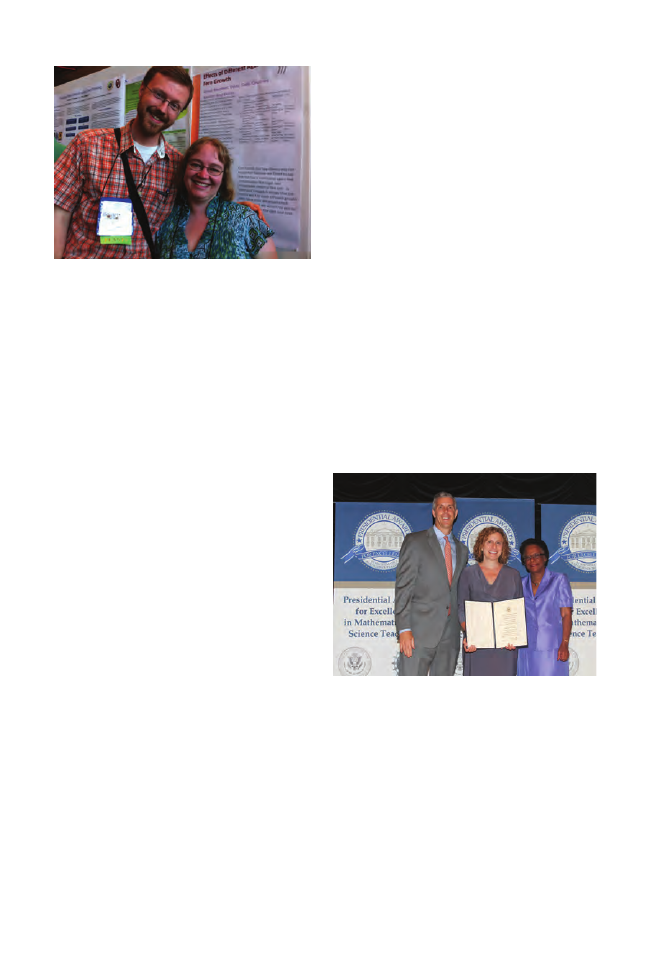
95
Plant Science Bulletin 58(3) 2012
Kara Butterworth and Gabriel Johnson, who has
mentored some of her teams, share a laugh and
some C-Fern growth tips.
Many thanks to the teachers and mentors
taking part in the July focus group meeting: Kara
Butterworth, Martha Cook, Ben Gahagen, Sean
Hoban, Betty Indriolo, Monica Lewandowski,
Kim Parfitt, Eric Ribbens, Andrew Schnabel,
Naomi Volain, and Dick Willis. How fortunate
the program is to have such high-quality teachers
and mentors. The chance to bring you together was
incredibly fun and valuable. Your input about future
program directions and website redesign will help
ensure that the program serves the community’s
needs. We’ll have more to report following the next
stakeholder meeting this November.
Another new development for the community
this summer is the formation of an Inquiry Task
Force to review proposals for new inquiry module
development. This group includes members of
several of the society partners: BSA, American Society
of Plant Biologists, American Phytopathological
Society, and Ecological Society of America.
We are excited about beginning this collaboration to
broaden and deepen the plant inquiry topics available
to middle and high schools. View the aims and call
for proposals at http://www.plantingscience.org/file.
php?file=SiteAssets/Call_InquiryModuleProposals.pdf.
Education Bits and Bobs
Improving Undergraduate
Education with Discipline-Based
Education Research
Research on undergraduate teaching and
learning in physics, chemistry, engineering,
and biology represents a collection of related
research fields. While there is much to investigate
about how students learn concepts in specific
science fields and transfer their understandings,
a recent report has findings that hold across the
disciplines. Undergraduate students hold incorrect
understandings about fundamental concepts,
particularly when large or small scales of time and
space prevent direct observation of phenomena.
Students also tend to focus on superficial aspects
of a problem and struggle with graphs and other
domain-specific representations. Student-centered
approaches can enhance learning more than
traditional lectures. Considering instructional
approaches by faculty across the nation, science
and engineering faculty are the least likely to use
student-centered and the most likely to lecture in
their classrooms. The National Research Council
report, “Discipline-Based Education Research:
Understanding and Improving Learning in
Undergraduate Science and Engineering,” chaired
by BSA At-Large Education Director Susan Singer,
includes recommendations to increase the use and
recognition of discipline-based education research:
http://www.nap.edu/catalog.php?record_id=13362.
Naomi Volain with U.S. Secretary of Education
Arne Duncan and Deputy Director of the National
Science Foundation Cora Marrett.
Science Scores Edge Up Slightly,
but Grasp of Science Still Shallow
Eighth graders scored two points higher in 2011
than 2009 according to The Nation’s Report Card:
Science 2011. Additional good news included a
narrowed gap in scores between some racial groups
and a higher percentage of students who indicated
they liked science. A statistic unchanged across
years is the disappointing finding that some 27%

96
Plant Science Bulletin 58(3) 2012
of 8th graders reported doing hands-on science
activities once/twice a month or never. A related
study looking more closely into how students
assessed in 2009 perform hands-on and interactive
computer science activities showed shallow
understanding and applying concepts. Students are
particularly challenged by investigations containing
multiple variables to manipulate and requiring
decision making to collect appropriate data and
explain their results.
http://nationsreportcard.gov/science_2011/
http://nationsreportcard.gov/science_2009/ict_
summary.asp
Implementing Vision and
Change at the Introductory
Biology Level
This was the title of a conference, held June
28th-July 1st, in Washington D.C. as part of an
NSF-sponsored program for “Using scientific
societies as change agents for the introductory
biology experience.” The BSA was well represented,
beginning with former Education Committee
chairman, Gordon Uno, who is PI on the
Introductory Biology Project grant. Gordon
opened the meeting with an overview of the project
and left us with a challenging question, “Why hasn’t
this been fixed before?” Most of the sessions for the
next three days focused on the various components
that must be integrated to actually accomplish a
“fix.” Susan Singer, the BSA’s At-large Director for
Education, led off the first afternoon with a report
from the National Research Council on “Discipline-
based education research: Understanding and
improving learning in undergraduate science and
engineering.” Marsh Sundberg represented the
Society in the breakout session on “The role of
scientific societies in transforming the introductory
biology experience” and later presented a break-out
session paper: “The wheel of biological instruction
in the United States: 200 years of reinvention!”
Vision and Change in Undergraduate Biology
Education is an initiative sponsored by the
American Association for the Advancement of
Science and supported by the National Science
Foundation. Its vision is to transform patterns of
biology instruction in colleges and universities to
take advantage of new understanding about how
students learn and to implement many of the best
practices demonstrated to be effective in some of
the other natural science disciplines. This will
require that we change how we teach by focusing
more on student learning, and less on the content
we are teaching. For 200 years biologists have
been concerned with being more effective teachers,
but in the last 20 years science educators have
finally begun to accumulate data supporting their
convictions. We are finally heeding the advice of
one of the BSA’s early leaders, William Ganong,
who in his 1909 address as retiring President of the
Society suggested: “In a word, the first great need of
our science teaching is to make it scientific.”
During the past month you received an
invitation to respond to a document identifying
“Core Concepts in Plant Biology.” This is part of
the BSA’s contribution as a scientific society to
transforming undergraduate biology. But Vision
and Change involves more than just outlining the
core competencies of the curriculum. It involves
using some of the pedagogies inspired by Amos
Eaton (see PSB 57 (4)) and Charles Bessey (p. 114
this issue) that are considered “best practices” today.
It follows Ganong’s advice to make teaching more
scientific by assessing student learning in a rigorous
way. It involves professional development for faculty
members to hone their teaching skills and learn new
ones and it requires that faculty be rewarded for
their efforts, both in home institutions and in their
professional society. The BSA is already among
the leading societies in promoting and recognizing
student research (both undergraduate and
graduate), encouraging participation of community
college faculty, and providing recognition for
educational excellence. Do your part to help make
“this fix” work!
-Marsh Sundberg, BSA representative to the
conference.

97
Editors Choice Reviews
Investigating the Influence of
Karrikins on Seed Germination. De
Beer, Josef. 2012. American Biology
Teacher 74(5): 324-329.
Karrikins are a cellulose derivative produced by
burning and found in smoke. They have recently
been shown to stimulate germination of some
seeds. The author has his students do a brief
literature review of karrikins and then, using
stimulating questions, challenges students to
design appropriate investigations to answer their
questions.
Recognising Differences in Weed
and Crop Species. Recognition
Skills of Agriculture Students. Bur-
rows, Geoffry, E. 2012. Bioscience
Education. 19-9.
Burrows, Geoffrey E. 2012. Bioscience Education
19. Available online at http://www.bioscience.
heacademy.ac.uk/journal/vol19/beej-19-9.pdf.
Burrows has provided another example of using
high-quality digital images to help students learn
plant identification, in this case about two dozen
crop and weed species. More importantly, this
study is longitudinal with (mostly rural) students
tested before instruction, after instruction in a class
emphasizing plant identification, and four months
after completion of that class. Some surprises: 1)
there was not a big difference between urban and
rural students—all did poorly on the pre-test; 2)
the greatest gains were subsequent to the course
for students enrolled in other applied courses that
made use of the ability to identify plants.
Red Onions, Elodea, or Decalci-
fied Chicken Eggs? Selecting and
Sequencing Representations for
Teaching Diffusion and Osmo-
sis. Lankford, Deanna and Patricia
Friedrichsen. 2012. American Biology
Teacher 74(6): 392-399.
We all have some favorite examples for
demonstrating diffusion and osmosis. Lankford
and Friedrichsen have summarized many of these,
macroscopic, microscopic, and virtual, with a
summary of pros and cons of each. You’ve probably
tried most of these, but perhaps not all—so here is
a chance to look for a new example or two. You
might want to especially consider one of the several
virtual activities in the public domain that are listed.
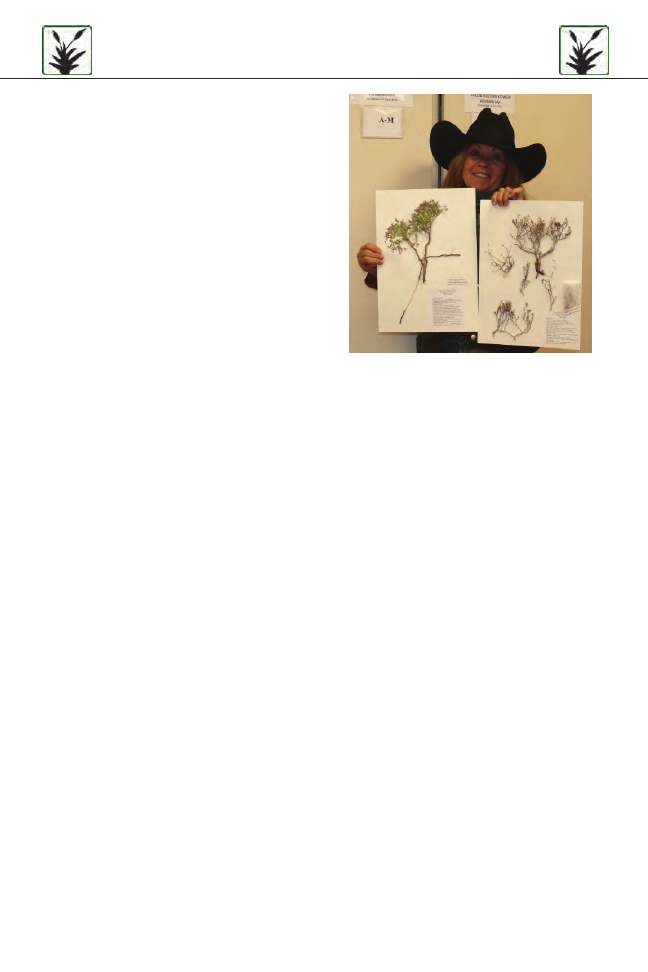
98
young son lived the next 6 years near her parents’
home in Aspen Park, near Conifer, Colorado.
On October 23, 1877, Elizabeth McIntyre Cowen
married Enos Throop Hotchkiss in Denver. Enos
was a close friend of Elizabeth’s husband, Jacob,
and from 1864 to 1871 owned property in the same
location where the senior Jacob Cowen resided.
Elizabeth and 6-year-old Jacob (Jake) then moved
to Enos Hotchkiss’ log cabin near Powderhorn,
Colorado, where Enos owned a ranch and a toll
road to Lake City.
In 1882 young Jake moved with his family to
the North Fork Valley, again into a small cabin.
He attended high school in Delta, and with Ada
McMurry was the first to graduate from that school.
He attended Colorado Agricultural College (CAC),
now Colorado State University, in Fort Collins. He
helped form the Columbian Literary Society and a
competitive oratorical group. He achieved the rank
of major in the Reserve Officer’s Training, and was
captain of the CAC football team. Jake graduated at
the head of his class of seven students in 1894 with
a degree in botany.
Jacob took a post-graduate course in 1894-1895,
after which he accepted the position of instructor
of botany and horticulture at CAC. He was one
of three men who began the herbarium at CAC.
His large collection of Colorado plants became
the foundation of one of the first floras for the
state. One species was named in honor of Jacob,
The Jacob Hoover Cowen
Herbarium
On June 23, 2012, Mrs. Carolyn Sue Savage Hall
opened the Jacob Hoover Cowen Herbarium in
Hotchkiss, Colorado. The Herbarium is located at
the corner of 2nd Street and Hotchkiss Avenue in
Hotchkiss in the VFW room of the building (13111
Wolf Park Road, Hotchkiss, CO; 970-872-7777.
Soon there will be a website for the Herbarium.
The goal of the Jacob Hoover Cowen Herbarium
is to make the extraordinarily diverse world of
Delta County wild plants, as well as from
adjoining
counties/watersheds (including Black Mesa, Grand
Mesa, Black Canyon, parts of the Muddy Creek
Drainage, and the Uncompahgre),
available to the
widest range of people possible from scientists with
PhDs to the youngest plant enthusiast, encouraging
both to explore plants from the rare and endangered
to the common and plentiful.
Carolyn Sue started officially collecting and
mounting specimens in 2006. She has been
interested in plants and their identification most
of her life. While she is mostly self taught, she
has taken various identification classes and was
awarded Certificate of Master Naturalist from
Gore Range Natural Science Center (now Walking
Mountain Science Center) in Avon, Colorado. She
also took an online course in Botany from Santa
Barbara Community College with Prof. Robert
Cummings. She continues to study online and
from books she acquires.
The Herbarium presently has almost 300
different species, including rare and endangered
ones. Plants in the Herbarium have been verified or
identified by curator Jennifer Ackerfield, Colorado
State University (CSU) at Ft. Collins, or Ron
Harmon, curator of Rocky Mountain Herbarium at
the University of Wyoming. A specimen of record
is kept and housed in the herbarium at CSU
as well
as herbaria in the Paonia and Colbran districts of
the U.S. Forest Service.
Naming the Herbarium was easy after she
learned from her friend Mary Hotchkiss Farmer
about Mary’s ancestor, Jacob Hoover Cowen, and
the profound impact he had on the botany of
Colorado.
Jacob Hoover Cowen was born to Elizabeth
McIntyre and Jacob Hoover Cowen on March 10,
1872, probably on their property in what is now the
Ken Caryl Ranch, near Littleton, Colorado. Young
Jacob’s father died on August 1, 1871, in a horse
accident before his son was born. Elizabeth and her
Carolyn Sue Savage Hall holding plant specimens
from the Jacob Hoover Cowen Herbarium: Polygala
subspinosa S. Watson spiny milkwort (left) and Eriogonum
pelinophilum Reveal.
ANNOUNCEMENTS

99
Plant Science Bulletin 58(3) 2012
Geranium atropurpureum var. cowenii (Rydb.) Dorn
(this is now a synonym for Geranium caespitosum
E. James).
From 1898 to 1900 Jacob attended Cornell
University in Ithaca, New York, where he graduated
with an advanced degree in botany. In 1899 Jake
was one of the Cornell students who organized
Gamma Alpha, a graduate scientific fraternity. Also
that year he published the book, The Geography
of the Apple in North America. He graduated
from Cornell with honors and was elected to
a fellowship in horticulture and agriculture in
Cornell University for the next year. The fellowship
would pay $500 and tuition, and required him to
teach classes 5 hours a week. Jake decided instead
to accept the chair of horticulture and botany at his
alma mater in Fort Collins, Colorado. Jacob’s thesis
is on microfiche in the Cornell University archives.
In July 1900, before he left Ithaca for Colorado,
he became critically ill. He died on July 12 at age
28 of peritonitis, the result of a ruptured appendix.
One article about Jake stated: “…cut short a career
that promised to illumine the world with the light of
as rare a genius as was ever given to mortal man…
He attained a personal knowledge of the flora of
Colorado and the Rocky Mountains by work in the
field which no other man possessed…”
Missouri Botanical Garden
Receives
$25,000 Grant for
Development of Advanced
Plant Data Collection System
National Park Service’s
National Center for Preservation
Technology and Training
Administers Funding to Preserve
Historic Resources
(ST. LOUIS): The Missouri Botanical Garden
has been selected to receive $25,000 from
the National Park Service’s National Center
for Preservation Technology and Training
to develop, test and disseminate a system to
modernize and streamline the collection of data
on living collections in its historic landscapes.
Missouri Botanical Garden’s living collections, in
addition to providing stunning displays, serve as
a “living library” for specimen-based research,
education and conservation and are utilized by
an extensive network of researchers in the United
States and around the world. With over 15,000
documented taxa, the living collection is ideal for
studies in several disciplines including biodiversity,
ecology and horticulture. The Garden’s Horticulture
Division develops and cares for these collections
to ensure their well being, creates propagation
protocols, conducts testing to determine cultural
requirements and ensures these plant collections
are adequately labeled, interpreted and curated. A
collections management database facilitates these
efforts so that the living collection can provide the
highest possible value for research, conservation
and education.
Data are typically recorded on paper forms
and later entered into the database back in the
office, which is time consuming and prone to
error. The Garden’s plan is to create new web-
based data collection forms for mobile devices
(like the iPad), enabling staff to record various
management tasks, such as tree assessment, plant
maintenance, or garden inventories, directly into
the Garden’s collections management database.
Additional functionality enabled with this grant
will allow staff to take photos of plants using
embedded cameras, and the resulting images will
be linked to corresponding records in the database.
Funding will also allow quick response (QR) codes
to be integrated into the collections management
database, and these codes will be utilized on plant
labels for inventory management and outreach
purposes. These features will increase output by
approximately fifty percent, resulting in more
comprehensive and accurate information by which
to manage the living collections.
“This grant will allow the Missouri Botanical
Garden to develop, test and disseminate a modern
data collection system utilizing mobile tablet
computers and QR code technology, which will
interface directly with the collections management
database,” explained Rebecca Sucher, Living
Collections Manager. “The system will aid in
preserving historic plants and landscape features at
the Garden.
The National Park Service’s National Center for
Preservation Technology and Training supports
projects that develop new technologies or adapt
existing technologies to preserve cultural resources.
For more information about the grants, visit www.
nps.gov.
The Missouri Botanical Garden is located at
4344 Shaw Blvd. in south St. Louis. For general
information, visit www.mobot.org or call
(314) 577-5100 (toll-free, 1-800-642-8842).

100
Plant Science Bulletin 58(3) 2012
Award
Grants will depend on travel costs but will
ordinarily be in the range of several hundred dollars
to about $5,000.
Deadline
February 1; notification in May.
Harvard University
Bullard Fellowships In Forest
Research
Each year Harvard University awards a limited
number of Bullard Fellowships to individuals in
biological, social, physical and political sciences to
promote advanced study, research or integration
of subjects pertaining to forested ecosystems. The
fellowships, which include stipends up to $40,000,
are intended to provide individuals in mid-career
with an opportunity to utilize the resources and to
interact with personnel in any department within
Harvard University in order to develop their own
scientific and professional growth. In recent
years Bullard Fellows have been associated with
the Harvard Forest, Department of Organismic
and Evolutionary Biology and the J. F. Kennedy
School of Government and have worked in
areas of ecology, forest management, policy and
conservation. Fellowships are available for periods
ranging from six months to one year after
September 1st. Applications from international
scientists, women and minorities are encouraged.
Fellowships are not intended for graduate students
or recent post-doctoral candidates. Information
and application instructions are available on the
Harvard Forest web site (http://harvardforest.fas.
harvard.edu). Annual deadline for applications is
February 1st.
Franklin Research Grants
Scope
This program of small grants to scholars is
intended to support the cost of research leading to
publication in all areas of knowledge. The Franklin
program is particularly designed to help meet the
cost of travel to libraries and archives for research
purposes; the purchase of microfilm, photocopies,
or equivalent research materials; the costs
associated with fieldwork; or laboratory research
expenses.
Eligibility
Applicants are expected to have a doctorate
or to have published work of doctoral character
and quality. Ph.D. candidates are not eligible to
apply, but the Society is especially interested in
supporting the work of young scholars who have
recently received the doctorate.
Award
From $1,000 to $6,000.
Deadlines
October 1, December 1 (December 3 in 2012);
notification in February and April.
Lewis and Clark Fund for
Exploration and Field Research
Scope
The Lewis and Clark Fund encourages
exploratory field studies for the collection of
specimens and data and to provide the imaginative
stimulus that accompanies direct observation.
Applications are invited from disciplines with
a large dependence on field studies, such as
archeology, anthropology, biology, ecology,
geography, geology, linguistics, and paleontology,
but grants will not be restricted to these fields.
Eligibility
Grants will be available to doctoral students
who wish to participate in field studies for their
dissertations or for other purposes. Master’s
candidates, undergraduates, and postdoctoral
fellows are not eligible.
American Philosophical
Society Grants

101
Botanical education in the United
States: Part 2, The nineteenth cen-
tury—Botany for the masses vs. the
professionalization of botany
Marshall D. Sundberg
Department of Biological Sciences
Emporia State University
Emporia, KS 66801
Key words: Bessey, botanical education,
Eaton, Gray, laboratory instruction, new
botany, Phelps, student-active learning,
Wood
Received for publication: 28 December,
2011.
Accepted for publication: 28 July, 2012.
doi: 10.3732/psb.1100003
Reports and Reviews
Abstract
The nineteenth century saw the maturation
of botany and botanical education, both in the
United States and abroad. Student-active pedagogy,
devised by Amos Eaton, was carried on by his
student Almira Hart Lincoln Phelps, who became
America’s first “best seller” botany textbook author.
Her major competitor, Alphonso Wood, soon
dominated the market by concentrating almost
exclusively on taxonomy and making it available
to all school levels. Asa Gray, America’s first
professional botanist, focused on professionalizing
the discipline through a profusion of content-
rich botanical textbooks marketed to students
from elementary grades through college. His
preeminence attracted money to construct a
dedicated botany building, including a laboratory,
and eventually attracted graduate students. The
“new botany,” championed by Charles Bessey and
others, began to move American botany toward
the forefront of botanical research while promoting
laboratory work and student-active learning at all
educational levels. This period culminated with the
founding of the Botanical Society of America.
Key words: Bessey, botanical education, Eaton,
Gray, laboratory instruction, new botany, Phelps,
student-active learning, Wood
As discussed in the initial paper of this series
(Sundberg, 2011), Amos Eaton was a pivotal
figure in the development of American botanical
education. According to Kuslan (1966), prior to
1839, when the first state normal school for the
preparation of teachers was founded at Bridgewater,
Massachusetts, Eaton’s program at Rensselaer was
the only one in the country specifically preparing
teachers of science; for botany and the other natural
sciences, the best school in the country was at
Rensselaer. The reason for his success was noted in
his obituary: “The Rensselaer School enabled Prof.
Eaton to prosecute his favorite plan of teaching
his classes, by making them experimenters and
lecturers to each other” (“D,” 1842). However, the
progress of botanical education, pivoting on Eaton,
would swing in two different directions.
In one direction, Eaton’s students and followers
would continue to write and teach botany for
students, common people, and practical botanists
working in small towns and rural areas across the
country. The Enabling Act of 1802 authorized each
new state to set aside two townships of federal land
for endowment of a university, thus beginning a
proliferation of colleges that continued through the
Jacksonian era. In 1800, 25 colleges existed in the
United States, and most had a science professor;
between 1800 and 1830, 44 new colleges were
founded, and respectable colleges had at least two
science professors (Rudolph, 1977). This was an age
of nationalism, both politically and scientifically,
and the classics-based college curriculum began
to come under attack. The country was growing
rapidly, and, particularly on the frontier, a
democratic sense of individualism and social
equality prevailed. There was widespread interest
in learning about the local plants—to stake a claim
on territory and understand something about
its agricultural potential (Pauly, 2000). Eaton’s
student-active approach to teaching would be
emulated by his disciples, and his classification of
local flora remained based on the Linnaean system.
This approach suited the new schools in rural areas
and on the expanding frontier of the country.
In the other direction was Asa Gray’s vigorous
reaction against Eaton and the Linnaean system
in his effort to professionalize botany and bring
it to the same level in the United States that his
contemporaries were achieving in England. Both
in Europe and America, there was beginning to
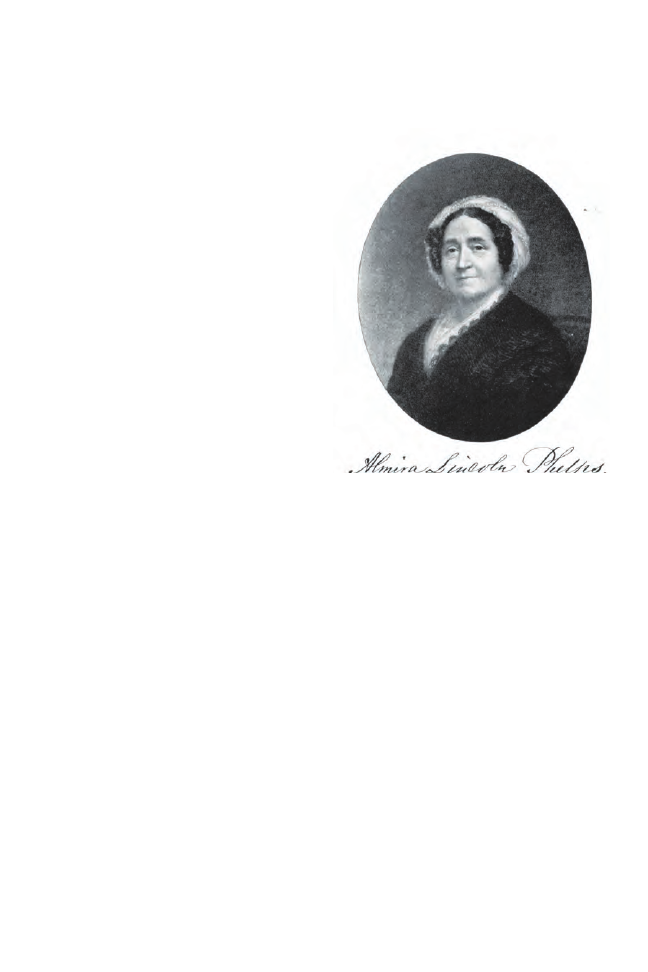
102
Plant Science Bulletin 58(3) 2012
be a distinction between botanists (scientists) and
botanophiles (enthusiasts). The former tended to
be men; the latter increasingly were women (Shteir,
1996). The dichotomy between botanists and
botanophiles is the focus of the initial sections of
this paper.
Near the middle of the century, the Morrill Act of
1862 stimulated another boom in college building.
From 1860 to 1870, 175 new colleges were founded,
and respectable colleges had at least four science
faculty members (Rudolph, 1977). This led to a new
focus on using science to solve problems in applied
areas. In the words of a professor from Greeley,
Colorado, “The beet root took precedence over
the Greek root as a subject for study” (Rudolph,
1977, p. 180). Traditional systematic botany began
to be replaced by a “new botany” focused on plant
structure and function, plant growth, and plant
disease. By the end of the century the new botany
began, unsuccessfully, to reconcile some of the
differences between the two earlier camps while it
modernized the study and practice of botany and
botanical education.
Almira Hart Lincoln Phelps
Puts Eaton’s Philosophy into
Practice
Early training as a teacher.
Eaton’s most famous protégé from Troy
Seminary was Almira Hart Lincoln Phelps (Figure
1), the subject of a major biography (Bolzau, 1936),
a book chapter (Arnold, 1984), and a special paper
in the American Journal of Botany (Rudolph, 1984).
Phelps was born Almira Hart on July 15, 1793,
on a farm near Berlin, Connecticut, about 12
miles southwest of Hartford. Her familiarity with
plants from an early age was reflected in her later
botanical textbooks. Her parents were committed
to education and independent thinking for all their
children, including the girls. This was a time of
expanding economic opportunity in the country,
and with it came time and inclination for education,
beginning in the home (Kohlstedt, 1990). As we saw
with Barton and Hosack, this also was a time when
science was beginning to be published in journals
and papers, and science, including the laboratory,
was being introduced into school and college
curricula (Sundberg, 2011). Even the general
public was interested in science and its applications;
lyceums and public lectures were becoming
fashionable. This interest in plants was not restricted
to the New World. Since the 1760s, botany was a
particularly fashionable pursuit, for both men and
women, as the European Enlightenment permeated
polite society and eventually the general culture.
Particularly in England, women were prolific
writers of botany books for home schooling and
Figure 1. Almira Lincoln Phelps. (Image in public domain.)
informal education. Rousseau’s Letters on the
Elements of Botany Addressed to a Lady (1787)
went through eight editions, several of which
were translated into English (Shtier, 1996). It was
a ripe time for the spread of botany in America.
The young Phelps was strongly influenced by her
older sister, Emma (Hart) Willard, who became
one of the foremost women’s education reformers
of the time. By the time she was 10 years old, Phelps
was attending summer school in Berlin under the
tutorage of Emma, “who, as was the custom of the
time, was conducting the summer school while a
man was master in the winter” (Bolzau, 1936, p. 25).
In 1810 Phelps moved to Middlebury, Vermont, to
again study with her sister, now Mrs. Willard, and
to be tutored in math by Mr. Willard’s nephew,
John Willard, a student at Middlebury College. Two
years later she moved to Pittsfield, Massachusetts, to
study in Nancy Hinsdale’s (one of Phelps’ cousins)
Academy for Women, and in February 1816, she
accepted an offer to “take charge” of an academy
in Sandy Hill, New York. Like many teachers, she
was accustomed to taking notes from the books
she read to prepare lessons. Her pedagogical
innovation was to require students to make written

103
Plant Science Bulletin 58(3) 2012
offered me the assistance of some manuscripts
formerly prepared by himself for a similar purpose.
With so able an advisor as Professor Eaton, the
encouragement of my sister, the principal of
this institution, and with no ordinary degree of
enthusiasm for the science, I commenced preparing
these lectures for the press” (Lincoln, 1829, p. v).
Phelps had no pretentions of being a scientist—
she was a teacher. She made no claim to making
any botanical discoveries or innovations but took
full responsibility for presenting accepted botanical
facts in the most effective way for students to
comprehend and learn. But unlike her future
literary competitors, Alphonso Wood and to
some degree even Asa Gray, she was familiar with
and drew on contemporary French and German
work, even more extensively than on British texts,
and gave credit to them when due. Bolzau (1936)
suggested that the general outline of Familiar
Lectures in Botany (Table 1) was very similar to,
and probably influenced by, Rousseau’s Elements of
Botany (available in English translation since 1785).
Although Rousseau emphasized that students
should have real material in their hands when
studying and be guided to observe the necessary
structures, rather than be taught simply by lecture,
his syllabus was more like Phelps’ later elementary
works, with each lesson following an individual
plant example. Instead, Phelps’ model for Familiar
Lectures, covering basic anatomy and physiology
extensively at the beginning of the text, followed the
abstracts of their textbooks (Bolzau, 1836). Less
than 2 years later, on October 4, 1817, she married
Simeon Lincoln, and her teaching career was put
on hold for motherhood and domestic life until her
husband’s death in 1823.
After her husband’s death, she moved with her 2
young daughters to her sister’s new school, the Troy
Female Seminary, to become a teacher and vice
principal. More importantly, it was here that she
came under the influence of Amos Eaton, and this
brought her to the forefront of botanical education.
Eaton’s disciple at Troy.
The Troy Seminary was a flourishing school at
the time of Phelps’ arrival, with nearly 140 students,
seven teachers, and three assistant teachers. It
offered the most extensive curriculum of any
similar academy in the country, and it included
lectures on natural philosophy, chemistry, botany,
and other branches of natural history. The tuition
fee was $3.00 per course (Bolzau, 1836).
Before 1830, fewer than 25% of female seminaries
offered botany in their curriculum, and the number
was even lower for boys’ or co-ed schools (Warner,
1978; Kohlstedt, 1990; Keeney, 1992). For several
years, Phelps both studied botany with Eaton and
taught botany at the seminary. Yet she “found want
of a suitable book for beginners.” She fleshed out the
outline of her notes for students and said that after
discussions with Eaton, “…he urged the necessity of
some suitable work for beginners, and generously
Date
Lincoln Phelps
Eaton
Wood
Gray
1835
73
27
1840
76
24
1845
85
14
1
1850
63
4
32
2
1855
1860
11
64
25
1865
3
58
39
1870
45
55
1875
37
63
1880
33
67
1885
15
85
Total Copies
375,000
18,000
800,000-
1,000,000
Table 1. Percent of botany textbooks used in New York secondary schools. Percentages based on Keeney
(1992, Table 7); number of copies from Ewan (1969).

104
Plant Science Bulletin 58(3) 2012
outline used by earlier American authors, Barton
and Waterhouse (Sundberg, 2011), who in turn
were influenced by Linnaeus (1751). Much of the
plant anatomy and the history of botany in her text
drew heavily on Mirbel (1815), while the Linnaean
systematics section followed Eaton. If fact, her plant
descriptions were taken verbatim from Eaton’s
manual (1829) with his permission (Lincoln, 1829,
p. 29). Nevertheless, even in the first edition, she
acknowledged the natural system of Jussieu (1789)
with a 13-page description and examples, which
she said was “highly valuable to those who wish to
pursue the study of Medicinal Botany” (Lincoln,
1829, p. 106). The frontispiece was an adaptation
of Humboldt’s profile of Mt. Chimborazo, showing
elevational zonation of plants, and she included
numerous detailed illustrations throughout the
book. In later editions, she acknowledged Goethe’s
Metamorphosis of Plants (Goethe, 1790; Lincoln,
1853).
The style of her book, and presumably her
teaching, reflected a synthesis of some aspects of
her mentor, Eaton, with a continental approach
to what Morton (1981) called a “unitary theory of
plants.” From Eaton she drew the conviction that
students should study nature directly, either in the
field, in the laboratory, or in demonstration. For
this, the study of plants was a distinct advantage
because “Animals, though affording the most
striking marks of designing wisdom, cannot be
dissected and examined without painful emotions.
But the vegetable world offers a boundless field of
inquiry, which may be explored with the most pure
and delightful emotions.” (Lincoln, 1836, p. 15). But
unlike Eaton, whose textbook was solely a manual,
Phelps saw the need to provide students with more
background about the structure and function
of plants. Furthermore, basic botany should be
integrated throughout instruction. She wrote: “It
has been customary among botanical writers, to
consider under separate heads, the physiology,
anatomy and classification of plants. This division,
although proper in minute investigations upon
physiology and anatomy, seems not well adapted
for a school book. I have not therefore attempted to
keep the departments separate.” It is interesting that
at the same time, John Lindley, at the University
of London, was writing a new textbook of botany
expressing the same philosophical approach and
the same basic organization (Lindley, 1831). It
is also interesting that while Lindley made no
mention of Phelps (although John Torrey wrote the
introduction to Lindley’s first American edition of
An Introduction to the Natural System of Botany…
(1831), and so Lindley was likely aware of her work),
Phelps identified Lindley as one of the few British
botanists whose works she regularly consulted.
This lack of acknowledgement might have been
an outcome of Lindley’s efforts to professionalize
botany. In his inaugural address to the University
of London, he said, “It has been very much the
fashion of late years, in this country, to undervalue
the importance of this science [botany], and to
consider it an amusement for ladies rather than
an occupation for the serious thoughts of man”
(Lindley, 1829, p. 17). It may also have been part of
an effort in England to segregate amateur collectors
and naturalists from aristocratic professionals
(Secord, 1994; Shtier, 1996).
Because she was writing a text to complement
her student-active teaching, Phelps also rejected
the popular style of textbook, written to be read
aloud and memorized for later recitation—the
normal method of instruction at the time (compare
with Asa Gray below).
…[F]rom experience in teaching others, and from
observation of the operations of my own mind, I
am led to believe that books most remarkable for a
concise style, are not the most favourable [sic] for the
development of the mind. If a book is to be committed
to memory, every word, member of a sentence, or
idea, not absolutely essential, should be excluded;
but this fact with regard to education seems now to
be generally understood, that the memory may be
burdened without improving the other intellectual
faculties, and that the best method of teaching is that
which tends most to develop, fertilize, and strengthen
the mind….It is desirable that school books should
be easy to teach, and easy to learn. (Lincoln Phelps,
1831, pp. v-vi)
Phelps believed that the ideal textbook had three
main attributes. First, the topics should be arranged
in a clear and logical fashion to develop student
understanding, not just factual memorization.
Major concepts should be covered in enough depth
and detail that students could follow the logic of
development. Second, the language used should
be clear and precise, again to facilitate conceptual
development. In this regard, it is interesting to
note that the Flesch-Kincaid reading level of her
textbook would be considered appropriate for
high school seniors and college freshman today
(Figure 2; Table 2). Any technical terms should be
explained as they were used. Finally, writing style
should be pleasing and easy to follow with the use
of interesting examples and illustrations. With
these guidelines in mind, Phelps produced the first
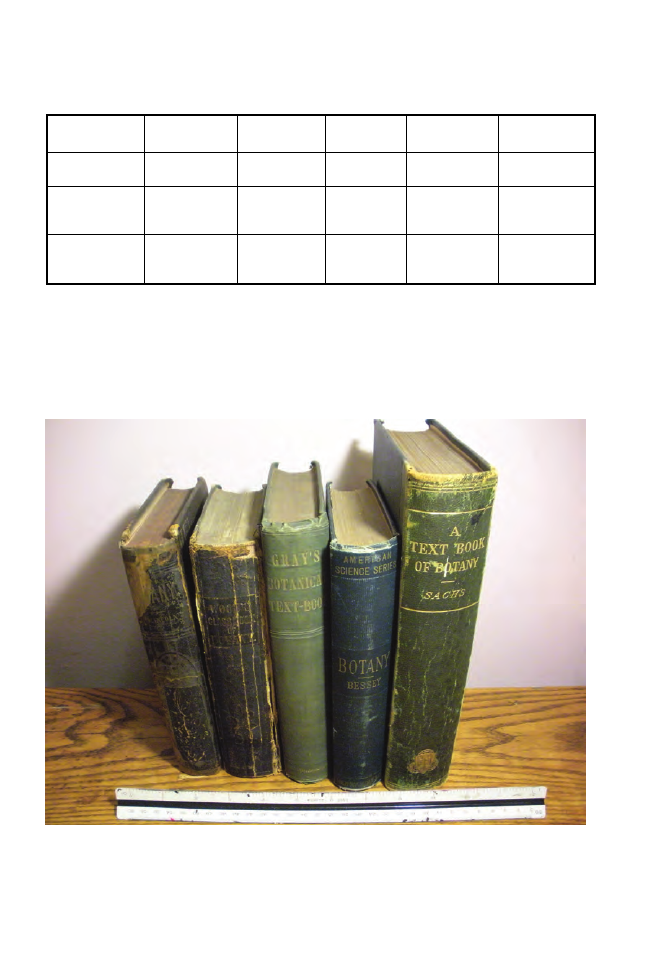
105
Plant Science Bulletin 58(3) 2012
Table 2. Comparison of mid to late nineteenth century U.S. botanical textbooks with Sachs’ German text-
book of botany.
Author
Lincoln
Wood
Gray
Bessey
Sachs
Dimensions
(inches)
5 x 8
4.75 x 7.35
5.25 x 8.25
5 x 8
6.5 x 9.5
Pages
537 + 15 pp.
plates and
explanations
645
528
611
858
Flesch-Kincaid
reading level
(grade level)
11.4
14.2
24.2
10.5
15.1
Lincoln. 1853. Familiar Lectures on Botany. New edition revised and enlarged.
Wood. 1853. Class-book of Botany. 29th edition.
Gray. 1853. The Botanical Text-Book. 4th edition.\
Bessey. 1883. Botany for High Schools and Colleges. 2nd edition.
Sachs. 1875. A Text Book of Botany. English translation of 3rd edition.
Figure 2. Contemporaneous textbooks examined for data in Table 2. Left to right: Lincoln, 1853, Familiar
Lectures on Botany, New edition revised and enlarged; Wood, 1853, Class-Book of Botany, 29th edition;
Gray, 1853, The Botanical Text-Book, 4th edition; Bessey, 1883, Botany for High Schools and Colleges, 2nd
edition; and Sachs, 1875, A Text Book of Botany, English translation of 3rd edition.

106
Plant Science Bulletin 58(3) 2012
edition of Familiar Lectures on Botany in 1829. This
book, originally written for use in girls’ seminaries
but later expanded for a co-educational audience in
both secondary schools and colleges, went through
at least 29 editions and 39 printings from 1829
through 1872. In total, more than 375,000 copies
were produced (Tables 1, 3).
An interesting pedagogical device Phelps
employed to aid teachers and students was
to number sequentially the concepts covered
throughout the book. It is probable she copied this
from Linnaeus himself, who used this technique
in his Philosophia Botanica (1751), and it was
employed by all her American competitors and
into the 20th century. Interestingly, it was also used
in German texts as early as 1806 (Treviranus), but
it was not used by the French and is found only
in some later British texts, such as that of Lindley
(1831).
Like her female European counterparts, Phelps
modified the terminology slightly to make it more
suitable for her audience. For instance, rather than
“ovary,” she referred to the “germ,” and pollen was
“a kind of powder.” She expanded slightly on this
in Lecture 8, “Stamens and Pistils,” when she said,
“…the important use of this dust in the perfection
of the fruit we shall soon speak” (p. 80). “In the
germ are already seeds formed, but these seeds
require the agency of the pollen to bring them
to the perfection necessary for producing their
species” (p. 82). She acknowledged that more detail
is known from her French source, Mirbel (1815),
but that there was not time to go further. She began
to revise the book immediately after publication but
soon realized that there was too much information
for younger students, so she wrote a simplified
version, Botany for Beginners, in 1833. This smaller
version went through 13 editions and 26 printings
from 1833 through 1891, with more than 270,000
copies printed.
In the early editions, the butterflies, honey bees,
and other insects assist the wind “in executing
the designs of nature” (p. 79). By 1836, however,
Familiar Lectures was more descriptive of the role
and process of pollination in producing the next
generation of plants, acknowledging that Linnaeus
made clear the roles of stamens and pistil. She went
on to provide a learning moment for students.
“Facts that when discovered seem so simple, that
we wonder a child could not have discovered them,
have eluded the research of great men;—and at
this moment philosophers are groping for truths,
which in due time will be elicited and incorporated
into the elements of science to be learned and
understood by children” (p. 81). This description of
the nature of science would be a relevant guide for
teachers today. With this edition, she considerably
revised her plant descriptions from those of Eaton,
which she used in earlier works. In addition,
numerous species were added. By 1853 the natural
system was expanded as a 68-page appendix that
provided an alternative to the Linnaean system, but
she still preferred the latter for beginners because
of its ease of use.
Phelps left the Troy Seminary in 1831 and moved
to Vermont with her second husband, John Phelps,
for a “retirement” of writing. Seven years later she
accepted a principalship, and she and her family
moved to West Chester, Pennsylvania. After 2 years,
she moved again to the Rathway Institute in New
Jersey, and finally in 1841 settled at the Patapsco
Female Institute in Maryland, where she spent the
rest of her career. Her Familiar Lectures in Botany
dominated the botanical textbook market during
the first half of the 19th century (Figure 1), yet
Ford (1964) relegated her to a single sentence in his
article on American botany textbooks. As a “faithful
disciple” of Eaton, she “edited” Eaton’s manual “to
serve elementary, secondary, and feminine usage…”
(p. 62). Perhaps Ford was unconsciously reacting to
one of Phelps’ statements in chapter one carried
through each edition: “The study of Botany seems
peculiarly adapted to females” (Lincoln, 1829, p. 12;
1853, p. 10). Nevertheless, in 1859 she became the
second woman elected to the American Association
for the Advancement of Science (AAAS).
Alphonso Wood, Popularizer
of the Natural System of
Classification
Producing a proper textbook.
For such a prolific author of botanical textbooks,
with more than 10 different titles to his credit, we
know very little about Alphonso Wood (Figure 3).
He was born in 1810, the same year as Asa Gray,
and graduated from Dartmouth, Phi Beta Kappa,
in 1834, intending to be a school teacher. He had
no formal training in science but learned about
plants from lecturers and students in the medical
school. In 1845 he published the first edition of A
Class-book of Botany. Within 3 years it was in its
10th edition; it eventually made it to 50 editions
and sold over 100,000 copies (Lyon, 1945; Table 1;
Figure 2). Like Eaton and Phelps, Wood’s primary

107
Plant Science Bulletin 58(3) 2012
interest was in teaching botany (taxonomy), and
he was concerned that no proper textbook was
available. In Wood’s view, two major problems
existed with Phelps’ Lessons in Botany. First, she
spent too much time covering basic structure and
function, nearly 300 pages, with only 220 devoted
to the flora. Second, Phelps still was devoted to the
Linnaean system, and Wood, like Gray, understood
that the natural system was more appropriate. On
the other hand, Gray’s Elements of Botany (1836)
did not include a flora, and his The Botanical Text-
book (1842), like Phelps’ text, devoted only about
40% of its pages to the flora. Wood understood
that he had meager botanical training even though
he was a devoted amateur plant collector. For this
reason, he tried unsuccessfully to convince more-
qualified botanists to prepare a suitable textbook
for secondary schools that would include a manual
of the plants of the Northeast. Among those he
approached was Gray himself. “Wood has called
on me twice. He will I dare say produce something
rather respectable—much better than anything of
the Mrs. Lincoln school….that his work may do
good, I dare say—though the better it prove, the
more it will affect my own interest. But the field is
freely open, and I wish him heartily all the success
his book may deserve” (Gray, 1844).
Gray was indeed prescient. Wood’s book was
easy to read (compare a reading index of 14,
today’s college sophomore, with the graduate
school reading level of Gray’s textbook in Table
2), inexpensive, and devoted more than 500 of its
645 pages to the natural system of classification.
His illustrations were comparable to those found
in Phelps. The first edition of 1500 privately
printed copies sold out immediately, and a Boston
publishing house quickly produced an additional
3000 copies (Lyon, 1945). Wood had begun to make
his mark challenging the established authors. In the
preface of the first edition, he stated his teaching
philosophy:
That there is need of a new Class-Book of Botany,
prepared on the basis of the present advanced state
of the science, and, at the same time, adapted to the
circumstances of the mass of students collected in our
institutions and seminaries of learning, is manifest to
all who now attempt either to teach or to learn. The
time has arrived when Botany should no longer be
presented to the learner encumbered with the puerile
misconceptions and barren facts of the old school,
but as a System of Nature, raised by recent researches
to the dignity and rank of a science founded upon
the principles of inductive philosophy...; That theory
of the floral structure which refers each organ to
the principles of the leaf, long since propounded in
Germany by the poet Goethe, and recently admitted
by authors generally to be coincident with facts, is
adopted, of course, in the present work.
His textbook featured a simple key to classes that
led to orders (our families), each of which had its
own key to genera. Each genus had a generalized
description, including vegetative as well as floral
characteristics. Species were listed alphabetically,
and each species entry included the common
name and a complete English description, again
including vegetative as well as floral parts in
addition to time of flowering. “Without the talents
nor the advantages of Gray, [Alphonso Wood]
competed successfully in the textbook field” (Ewan,
1969, p. 44). Within a few years of its appearance,
Wood’s Class-book eliminated Eaton’s market and
severely cut into Phelps’. In 1845 Gray himself
complained to Torrey “…Wood is just taking the
market, against my ‘Botanical Textbook,’ mostly
by means of his ‘Flora’.” The reasons are apparent
from the testaments published at the end of Wood’s
text (1853)—the lack of a suitable flora was just one
reason.
Figure 3. Alphonso Wood. (Image in public domain.)

108
Plant Science Bulletin 58(3) 2012
Wood’s Botany evidently embodies more traits of
excellence and usefulness than any one of the various
elementary treatises in general use. In some of these,
the preliminary principles of the science are unduly
expanded; from others, they are nearly or quite
excluded. Mr. Wood’s work combines a concise and
lucid exposition of primary principles, with ample
illustrations of the science, drawn from the Flora of
our own immediate section.
—From Messrs. Peck, Newman, and Wentworth,
of Troy Conference Academy.
I am highly gratified that at last we have an
excellent Class-Book of Botany, by Mr. Wood. We
have been almost obliged to abandon the study of
Botany in our Colleges and Academies for several
years, in consequence of the want of a suitable work
as a text-book for students. In this work of Mr. Wood,
we have a desideratum supplied, certainly excellent,
with an arrangement beautifully simple, and even
elegant.
—From Ebenezer Emmons, Prof. Natural History
in Williams College
It is interesting that several testimonials,
including one of the above, came from Williams
College, Amos Eaton’s alma mater, and that the
botanical reputations of both Eaton and Phelps
were founded in Troy, New York, the location
of Troy Conference Academy. Clearly personal
association was not a factor in textbook selection,
though it may have been a factor for Wood in
selecting advertising testimonials.
Expanding his range.
With his success, Wood began to travel, add
to his collections, and use the work of others
to expand the range covered by his manual. A
particular irritant to Gray was that Wood made his
own species determinations of any new collections
without reference to either Gray or John Torrey.
Each edition added a few new species, but, with the
exception of the major revision of the 1861 edition,
each edition was virtually a copy of the previous.
Eventually, between 800,000 and 1 million copies
were sold (Ewan, 1969). While Gray and many
other professional botanists saw the Class-book
as too elementary, it proved to be a success in the
colleges. “The whole science,” wrote Prof. G. H.
Perkins, of Vermont University, “so far as it can be
taught in a college course, is well presented, and
rendered unusually easy of comprehension. I regard
the work as most admirable” (Wood, 1870, p. ii).
With his success in the college market established,
Wood went on to produce new books targeting the
elementary and secondary schools. First Lessons in
Botany (1851) was a small (6¼ x 5 inches) volume
summarizing the major topics of the Class-book
in much simplified form with many illustrations.
The principles of education, enumerated in the
introductory “Suggestions to Teachers,” were a
reflection of Eaton’s and Phelps’ approach. First,
“...in the study of any science, the discipline of the
mind is an attainment of at least equal value with
the acquisition of knowledge.” Second, difficult
concepts should not be avoided, but enough detail
should be provided to make them understandable.
And third, “…the first lessons which children learn,
since they are most likely to be permanent, should
contain truth, however small the portion, neither
simplified to childishness nor glossed over with
error” (p. 5). He went on to provide a script of a
teacher interacting with 10 pupils for a new teacher
to use to introduce the study of botany on the first
day of class. The New American Botanist and Florist
(1870), Wood’s Illustrated Plant Record (1877), and
Fourteen Weeks in Botany (1879a) were targeted to
secondary schools. Botanist and Florist was based
on the Class-book, with a slightly simplified first
half. A new feature was a series of synoptical tables
that outlined and integrated the main concepts of
several chapters and that were “intended for the
blackboard.” This was a new aid for both the teacher
and pupil to facilitate understanding and memory.
Wood’s Illustrated Plant Record was essentially a
laboratory notebook for taxonomy. It began with
an extensive, illustrated glossary of botanical terms
followed by about 50 two-page specimen check
tablets. Each tablet was a checklist of descriptive
terms, organized by organ or by the key characters
identified on a single specimen. At the back of the
book was a label for collection data, classification,
and remarks—essentially a specimen label for that
plant. At the end was an index template for students
to organize the materials documented in their
check tablets. Fourteen Weeks in Botany was part of
a “Fourteen Weeks” series in the natural sciences
known for their simplicity. To accompany Fourteen
Weeks, Wood prepared an equally short text, How
to Study Plants (1879b). This book consisted of 73
chapters, each focusing on a single species with
one page consisting of illustrations of the plant
and diagnostic parts and a second providing an
analysis of the key characters and classification. At
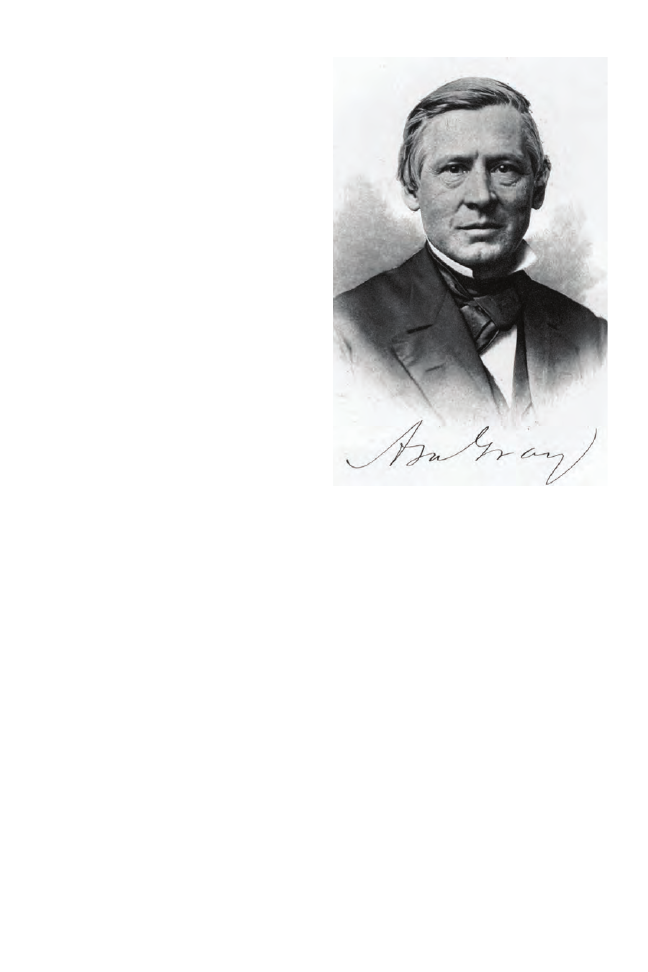
109
Plant Science Bulletin 58(3) 2012
medical books, and while there, he left some plant
specimens for John Torrey. Gray received his M.D.
degree later in 1830 and began practicing medicine
to earn money to support his botanizing habits,
which included periodic teaching appointments at
local academies and lyceums.
Two years later, Gray and Torrey finally met on a
collecting trip to the New Jersey Pine Barrens and
thus began a life-long friendship and collaboration.
This was a period of both social and botanical
unrest in American history. Andrew Jackson was
recently elected President of the United States,
and the founding political parties were in retreat.
The nation was in an egalitarian mood. Eaton
was convinced that although the natural system
rising in Europe was “…the grand climacteric in
botanical science” (Eaton, 1836, p. iv), the Linnaean
approach was preferable for introducing botany to
the masses. He also thought it was better suited to
his educational approach of field and laboratory
inquiry at the introductory level. Thus, he retained
Linnaeus’ classification in all the revisions of his
manual. Gray, influenced by Torrey, was convinced
not only of the botanical superiority of the natural
the beginning were two pages of instructions for
teachers. Perhaps more significant than the text
itself, Wood, like Eaton, saw the need to prepare
teachers to teach effectively. The last edition of this
text, published posthumously in 1895, was subtitled
An Illustrated Flora for Teachers’ Reading Circles.
Four years later, Ganong (1899) would publish the
first full textbook dedicated to how to teach botany.
The reaction of professional botanists to Wood
and his books was summed up by Moses Curtis
(1857) who asked, “How is it, that the most
profitable Text Books are prepared by sciolists?...
[he] will make a four months’ tour through the
South,—in winter too—take a rapid survey of a
locality or two in each State…pump every collector
who will submit to the operation…[giving the
book] an appearance of singular authenticity.” The
Botanical Gazette summed it up in Wood’s obituary
notice: “As a scientific botanist his work can never
rank very high, but as an educator his name will
always be remembered” (Obituary notice, 1881).
Asa Gray and the
Professionalism of American
Botany
Botanical training.
In 1964, Ford suggested that “…what was
published in America in the way of botanical texts,
prior to Gray’s ascendancy was inconsequential”
(p. 62). Asa Gray was the preeminent American
botanist of his day, but he was only an ordinary
teacher (Figure 4). Nevertheless, his impact on
botanical education was enormous thanks to the
series of textbooks he produced. Gray was born
in 1810 in Sauquoit, on the upstate New York
frontier. He began to attend the district school early
and became an avid reader. At 13 years old, Gray
enrolled in the nearby Hamilton College, where he
studied the traditional classics for 2 years. In 1825 he
transferred to Fairfield Academy. We do not know
what classes he took, but the third-year curriculum
approved for the Academy in 1808 included botany
and materia medica as required courses (Dupree,
1959, p. 9). After only a year, Gray again transferred,
this time to the College of Physicians and Surgeons
of the Western District of New York, where he took
classes in chemistry, mineralogy, and botany from
Dr. James Hadley. In 1828 Gray bought a copy of
Eaton’s (1822) Manual and began collecting plants
in earnest. The summer before graduation, his
internship supervisor sent Asa to New York to buy
Figure 4. Asa Gray in 1857. (Image in public domain.)

110
Plant Science Bulletin 58(3) 2012
system but also of its place in the curriculum.
Already in 1833, he wrote to Torrey complaining
that in his current teaching position “…the principal
wishes to retain too much of the Eatonian plan to
suit me” (Gray, 1833). It is not clear whether he was
referring to Eaton’s use of the Linnaean System,
Eaton’s student-active approach to teaching, or
both. Later that year he expressed his attitude
toward teaching: “I have just finished at Hamilton
College a long tedious course” (Dupree, 1968, pp.
40-41). The animosity of Gray toward Eaton would
continue until the latter’s death in 1842.
The
Elements of Botany.
As early as 1835, Gray was convinced that he
had to write an American botanical textbook with
content equivalent to that found in European
texts but smaller, less intensely illustrated, and
more affordable than was available from abroad
(Gray, 1836, p. x). Phelps’ and Eaton’s books were
completely unacceptable because of their use of
the Linnaean system; at least Phelps included basic
botany at the beginning of her text, but it was too
elementary. Torrey warned Gray that it would take
more than a few months to write such a textbook.
This was a prescient observation. Elements of
Botany, like others of Gray’s books, would turn out
to be a much more time-intensive writing task than
he anticipated. It is interesting that Gray was driven
by an ulterior motive—supplemental income.
Medicine was always a possible fallback, but at this
stage of his career, he was functionally an assistant
to Torrey and/or a part-time instructor of botany.
The following year, Elements of Botany (1836)
was published. Not unlike Phelps, Gray felt that the
“whole science of Botany rests on the foundation
of vegetable organography and physiology” (p.
296), so it was important for students to have a
solid foundation in structure and function before
applying these skills to natural classification.
The first four chapters covered morphology and
physiology, the fifth treated the flowerless plants,
and the final chapter treated the flowering plants.
This book was 438 pages long compared with 340 in
Phelps; both were well illustrated. It did not include
a flora, nor was it written at an introductory level,
and both these factors were detractions compared
with his competition’s textbook (Table 1).
In 1837 Gray was offered a faculty position at
Louisiana College in Jackson, Louisiana, but with
new income from his textbook and his part-time
work, he declined the offer of $1500 per year. He
wrote his father simply, “I do not like the Southern
States” (Gray, 1837). The next summer, however,
he accepted a position as botanist at the University
of Michigan. This was the first time in America
that a professor was hired specifically as a botanist
(Dupree, 1959). His first responsibility was to travel
to Europe to purchase books and equipment for
the new university. Most of his time was spent in
England, where he worked and lived for a time
with William and Joseph Hooker, becoming an
especially good friend of the younger Joseph. In
London he met and worked with Robert Brown,
who introduced him to George Bentham, Charles
Lyell, Richard Owen, and Charles Darwin. He was
not impressed with the English universities: “I
can’t express … the profound contempt I feel for
the English University system of education.” There
was simply not enough science. Even so, with the
exception of de Candolle in Switzerland, he was
less impressed with what he saw while visiting the
botanists on the continent.
First American professional
botanist.
While Gray was in Europe, America was
experiencing the worst economic downturn in its
short history, the Panic of 1837. On his return to
Michigan in 1840, with the books and equipment
purchased in Europe, he was asked to forgo his
salary for a year until the financial situation
improved. With time on his hands, and a renewed
need for income, he began a new textbook. Elements
of Botany was out of print, and its publisher was out
of business. In 1842 The Botanical Textbook was
published, and Gray was offered a $1000 salary as
Fisher professor of natural history at Harvard but
with his responsibilities restricted “…to instruction
and lecturing in Botany and to the superintendence
of the Botanic Garden….” (Dupree, p. 110). Gray
and his Harvard colleague, the historian Jared
Sparks, were the first college faculty members
to have limited classroom obligations so as to do
their own research (Rudolph, 1977). His new book,
The Botanical Textbook, was basically a revision
of Elements of Botany; the major difference was
a formal division of the content into two major
parts: part I, an introduction to structural and
physiological botany, and part II, the principles
of systematic botany. Embracing Goethe’s
philosophical doctrine of morphogenesis, the total
number of pages, 413, was actually slightly reduced
from The Elements of Botany, but its reading level

111
Plant Science Bulletin 58(3) 2012
perfectly and thus make a squirt” (DuPree, 1959, p.
123). According to Bessey, even in 1872, “The more
nearly that the student’s answer corresponded word
for word with the text, the better was his recitation
considered to be” (E. Bessey, 1934-1935, p. 228.).
Gray’s difficulties presenting botany were not
restricted to the classroom but were also evident
in public lectures. “Dr. Gray is a poor speaker, but
his facts are very interesting, & his illustrations by
paintings are beautiful” (DuPree, 1959, p. 130).
Unlike Eaton or John Torrey, Gray did not enjoy
presenting botany to the general public, and he
stopped doing so after 1844.
While he was confined by the system to a dull
recitation format for his freshman students, Gray
had more latitude in his elective upper-level course.
Here he made extensive use of large illustrations
(originally prepared for public lectures) and
provided a general outline with only major
headings and significant ideas written down. But to
elaborate on ideas, he would write them out in full.
In 1847 and 1849, Gray offered a special month-
long advanced training of “particular instruction
in botany, with microscopical illustrations” at the
botanic garden. These were the first steps toward
both upper-level botanical laboratory training and
graduate training in the U.S.
But innovations in classroom teaching were not
his forte. Instead, he focused on his textbooks.
was not reduced (Table 2, Figure 2). According to a
reviewer, “With this Text Book in their hands, the
teachers of botany in our seminaries may speedily
elevate the study [of botany] to its legitimate rank
among the natural sciences” (Darlington, 1842).
Finally, in the spring of 1843, Gray, a hesitant
speaker, stood in front of a classroom as a full-time
teacher for the first time in nearly 10 years. At that
time Harvard was following the “scale of merit”
system whereby an instructor had to grade each
student during each class meeting. This approach
encouraged drilling and rote memorization. Gray
organized his course by dividing the class into four
sections, with each one meeting in one recitation
per week. Gray’s self-assessment was that he was
“pretty good at questioning” and would “give them
plenty of illustration, explanation, and ideas not
in the book” (Gray, 1843). At least one student,
however, had a quite different opinion, writing
that “the matter was very good…the manner was
positively shocking. I never saw a person more
awkward in delivery” (DuPree, 1959, p. 123). Four
years of experience did not seem to improve Gray’s
delivery. In 1848 another student referred to the
predictable manner of Gray’s recitations, admitting
that he “did not study much on my Botany.… The
way that I and in fact by far the greatest part of the
class do is to read their lesson over once and get
it in the recitation room…as we can tell about on
what part we shall be taken up, we can get that part
Numbers of Authors
Quarter of the
Century
Total
Number of
Textbooks
Percentage
of Authors:
American
American
English
French
German
First
Quarter
(1800-1824)
32
31
10
22
0
0
Second
Quarter
(1825-1849)
87
79
69
16
2
0
Third
Quarter
(1850-1874)
104
94
98
2
4
0
Fourth
Quarter
(1875-1899)
167
90
150
11
0
6
Totals
390
94
327
51
6
6
Reproduced, from Stuckey and Burk, 2000, p. 73, with permission from the Botanical Research Institute of
Texas.
Table 3. Numbers of botany textbooks in the United States (1800-1899), based on 390 unique printings, by
Rudolph.

112
Plant Science Bulletin 58(3) 2012
Because of his research, he was now recognized as
the greatest professional botanist in America, and
this authority would spread his influence, even
if it did not at first help sell books (Table 1). As
mentioned above, Alphonso Wood was a follower
of Gray’s promotion of the natural system, and he
actually encouraged Gray to write an introductory
text using that system. However, Wood found
The Botanical Textbook to be unacceptable for his
purposes. He saw no need for the basic botany,
certainly not half the book, and there was not
enough detail in the systematics section. Publication
of Wood’s Class-book of Botany in 1845 was a
warning shot to Gray and Gray’s ambition to raise
the standard of American botanical instruction.
Gray’s revision of The Botanical Textbook came out
the same year, but it quickly became evident that
Wood’s was more popular. Gray’s solution was not
to expand the Textbook but to write an entirely new
book meant to directly out-compete Wood. The
first Manual of Botany (1848) came out 3 years later.
In 1857 Gray moved into the high school
market with First Lessons in Botany and Vegetable
Physiology. The focus was structure and function,
much as was the first part of The Botanical Textbook.
The terminology and content were reduced to be
more appropriate for a lower level. Gray noted
that it was intended for common schools and
high schools, although it could be used as an
introduction to botany in colleges, where it would
provide the foundation for using the Manual. He
noted that those wishing additional information
about general botany should consult The Botanical
Textbook. Elementary students got their textbook
the following year—How Plants Grow (Gray,
1858a). According to Keeney, choice of textbook
for schools in the 1860s and 1870s was a regional
preference. Wood remained popular in New York
and the East, while Gray became the standard in
the Midwest. Such regional differences also were
starting to percolate up to the college level as
discussed below (Table 3).
Gray must have been a bit embarrassed for
spending valuable research time writing elementary
textbooks. In 1858 he wrote George Bentham, “My
last book in elementary botany is now just off my
hands, and will be out in a fortnight. I hope it will
be of use. Forgive me for writing horn-books, and
I am now done with that sort of work. There were
several convincing reasons for doing it.” (Gray,
1858b). Dupree suggested that a factor influencing
all Gray’s textbook writing was supplemental
income, $500-$600 per year on a flat-fee basis, and
this, apparently, was common for college faculty
(Kohlstedt, 1990). For whatever reason, Gray
persisted in his textbook writing. He published
an even smaller companion volume to How Plants
Grow in 1872 titled How Plants Behave.
A graduate program.
The year 1857 is when Darwin revealed to Gray
that he was writing his “big book” on species,
but it also was another milestone for Gray and
for botanical education: his last year without a
graduate student. For the first 15 years of his tenure
at Harvard, not a single student earned a graduate
degree in botany. The following year, 1858, Gray
accepted his first graduate student. Ironically, it
was a student who already had a well-developed
appreciation of plants. His name was Daniel Cady
Eaton, the grandson of Gray’s nemesis, Amos
Eaton. Daniel had learned systematic botany while
completing his bachelor’s degree at Yale. According
to Dupree (p. 200), “Eaton’s Cambridge training
shows clearly Gray’s lack of any concept of what a
graduate school might be. The professor made no
effort to push his student into the higher and more
technical aspects of science or give him an overall
view of the field of botany. The degree requirements
were for undergraduates and not well adapted for
graduate work….” Eaton, after earning his degree
with Gray, returned to Yale to become the second
full-time professor of botany in America.
Higher education in the United States changed
dramatically in 1862 with the Morrill Act
establishing land-grant universities in every state.
The Morrill Act was particularly important in the
Midwest, but it also had an effect at Harvard, where
it offered the potential for developing the graduate
program. The new Harvard president requested that
a plan be devised to reorganize the curriculum of
the Lawrence Scientific School, Harvard’s graduate
school of science. Gray was so disappointed with
the results that he encouraged his friend and
collector, George Engelmann, to send his son to
Yale, not Harvard. “We have really—thanks to
Agassiz and Peirce thwarting all good plans—no
Scientific School at Cambridge. They have one
at Yale, but here are separate schools: in one they
teach Chemistry thoroughly, in one Engineering—
in another [the Lawrence Scientific School] there
are lectures on Zoology and Geology—of no use to
a young beginner, and very little to an older hand”
(Dupree, pp. 315-316). In spite of this, botany
students began to come to work with Gray. One of

113
Plant Science Bulletin 58(3) 2012
the first was William James Beal, who came from
the University of Michigan in 1862 and earned his
botany graduate degree in 1865. Against Gray’s
advice, Beal took a position at the new Michigan
Agricultural College. New and capable students,
however, did not change Gray’s classroom attitude.
He wrote to an acquaintance, “…I am so driven, so
distracted. Bless your stars you are not a professor
…this year is far worse than ever. Besides the
bother of my classes, unusually bothering on the
new arrangement…” (Gray, 1866).
Laboratory instruction.
In 1871 a private donor contributed monies to
build a new classroom and student laboratory
building adjacent to the botanical garden building
to handle the growing number of students
interested in botany. Although Gray was averse
to the kind of laboratory instruction Eaton
promoted at Rensselaer, laboratory space would be
convenient for students to spread out specimens. It
is also possible that some space envy was involved.
“An 1858 Junior elective in chemistry with required
laboratory work was probably the first Harvard
course where students worked in a laboratory
rather than observe a scientific demonstration in a
lecture hall” (Rudolph, 1977, p. 145).
That summer Gray offered a special class for
school teachers in the new building to meet the
growing demand for new science teachers following
the Civil War. This was the first summer workshop
in botany for high school teachers offered—at least
in the United States. The new building was an
attraction for the plant physiologist George Lincoln
Goodale, who left Bowdoin College to join Gray’s
botany program. Gray could now concentrate on
morphology and taxonomy while Goodale brought
physiology up to date. In the laboratory, students of
morphology and taxonomy were mostly confined
to filling in checklists of characters, and physiology
students were introduced to some experimental
work. The potential for laboratory work must have
been appealing to students; in 1874 botany became
the second science at Harvard, a year after physics,
to require an entrance examination for acceptance
to the program (Leighton, 1880). Gray and Goodale
collaborated on The Botanical Textbook beginning
with the 1879 edition. This was also the year that
Goodale offered a winter course for teachers on
how to teach botany (Goodale, 1879; Bessey,
1880a). The goal of the course was to teach teachers
how to induce students to learn for themselves and
do their own thinking. This was accomplished in
the laboratory by using interesting and attractive
living plants, asking leading questions to guide
the student’s inquiry, and directly answering
only student questions that a student could not
answer for himself with direct observation. This
is a good model for inquiry-based learning today.
Goodale credited Henslow in England, not Bessey
(see below) and certainly not Amos Eaton, for
developing this inquiry approach (Henslow, 1858).
The European influence.
For the rest of his career, Gray continued to
revise his collection of books, bringing the botany
up to date in the textbooks and expanding the range
of species covered in the manuals. He continued
his close ties to the British botanists, particularly
Joseph Hooker and Charles Darwin, but even
though he was aware of the stirrings in Germany,
they did not have an effect on his teaching or
writing nor on that of any of the other American
botanists until the 1870s. This was in part because
most Americans did not read German (Ford, 1964).
But English translations of some German botany
texts appeared quickly, so the language barrier
suggested by Ford was not a compelling argument.
It was also because the primary American focus,
like England’s, was on taxonomy. During the
middle years of the 19th century, Gray and Hooker
were leading the professionalization of botany
in the United States and England, respectively.
Both were working against the popular stereotype
that botany was a subject of natural history best
suited to women (Adams, 1887). Both developed
centers of plant collection and focused their
work primarily on systematics. Both recognized
that an understanding of plant structure was
essential to be able to recognize natural systematic
relationships, but morphology and anatomy were
the handmaidens of taxonomy.
Quite a different approach was developing on the
continent and particularly in Germany. As early as
1849, the second edition of Schleiden’s botanical
textbook, which strongly emphasized cellular and
anatomical studies, was translated into English.
In the early 1860s, the great Hofmeister published
his 4-volume work Handbuch der Physiologiche
Botanik. Some considered this to be one of “two
epoch-making works” influencing botanical
science; the other was Darwin’s On the Origin of
Species (Green, 1967, p. 8). Volume 4 of that work
(1865), was written by the brilliant Julius von Sachs,
who 9 years later published his own Lehrbuches
der Botanik (1874, Figure 2). Gray was certainly

114
Plant Science Bulletin 58(3) 2012
aware of the Lehrbuches because his colleague,
Goodale, wrote reviews of both the 3rd German
edition (Goodale, 1873) and its English translation
(Goodale, 1875) in The American Journal of Science
for which Gray was an editor. Of the latter Goodale
said, “This conscientious translation is a valuable
and timely gift to botanical students.” However, of
the first section on general morphology he says,
“Most of this chapter is a literal translation of the
least satisfactory portion of the third edition.” Of the
third chapter, in his own area of expertise, Goodale
says, “The excellence of this digest is apparent on a
hasty perusal. It becomes more obvious when the
book is used with advanced students as a handbook
in daily work.… When it is supplemented by the
Experimental Physiology of the same author, the
laboratory is well equipped…. It is a great pleasure
to commend this volume, most heartily, as a good
translation of the German hand-book to advanced
botanical students.” More important than the
books, however, was that the Germans developed
a new style of graduate studies that focused on
laboratory work under the direction of the major
professor.
Hofmeister may have had some influence on the
overall construction of Gray’s Botanical Textbook.
With the 6th edition (1879), Gray’s intent was to
produce a four-volume compendium of botanical
science, much as Hofmeister had done nearly
20 years earlier. He would author the first book,
on structural botany (Gray, 1879). Goodale was
responsible for the second book on physiology,
which was finally produced in 1885. William
Farlow never published the proposed volume
3, Introduction to Cryptogamic Botany, both
Structural and Systematic, and Gray himself never
completed volume 4, Sketch of the Natural Orders
of Phaenogamous Plants: their Special Morphology,
Useful Products, &c. Sachs, however, did not have
much of an effect on Gray. Whereas Sachs’ first
chapter was a detailed description of the plant
cell, Gray made no mention of cells. Following
Hofmeister’s (1865) lead, Sachs recognized that
all plants shared alternation of generations and
treated cryptogams and phanerogams equally. In
Gray’s view, “As respects the organs of vegetation,
the higher classes of cryptogamous plants exhibit
this same type [as flowering plants]; it is only in the
most general or in a recondite sense that this can
be said of their organs of reproduction, and of the
less differentiated structure of the lowest classes.
Wherefore cryptogamous plants are left out of the
present view, to be treated apart” (Gray, 1879, p. 5).
Most conspicuously absent in Gray was reference
to evolution and plants through time; Sachs’ last
chapter was 25 pages on the origin of species.
Gray’s last textbook, a final revision of Gray’s
Lessons in Botany, was curiously re-titled The
Elements of Botany (1887), the title of his first text.
By this time, dozens of credible botany programs
existed at American universities around the
country, but a rift was developing between the old
East and the new West. Gray still dominated botany
in the former, but a “new botany” was rising in the
midwestern land-grant universities, influenced by
the German model and Sachs’ textbook.
Charles E. Bessey and the New
Botany
Botanical training.
Charles Bessey was born in Ohio in 1845 and
entered Michigan Agricultural College in 1866,
the first of the midwestern land-grant institutions
(Figure 5). The Morrill Act had specified that each
state could establish “one college where the leading
object shall be, without excluding other scientific
and classical studies, and including military
tactics, to teach such branches of learning as are
related to agriculture and the mechanic arts, in
such manner as the legislatures of the States may
respectively prescribe, in order to promote the
liberal and practical education of the industrial
classes in the several pursuits and professions in
life (Morrill, 1862). This sounded like a perfect
fit for Bessey. Unlike in the eastern universities, a
significant amount of the curriculum was science
and required a full year of botany in the sophomore
year (Beal, 1908, p. 89). Bessey later recalled that
“with the possible exception of Harvard, this
college [Michigan Agricultural] then gave the
most extended and thorough course in botany in
this country” (Bessey, 1908, p. 87). For his degree,
he completed semester-long courses in systematic
botany, structural botany, vegetable physiology,
and horticulture and was employed in the college
greenhouse. Unfortunately, his classes, even in
botany, were mostly the traditional textbook reading
and recitation with some simple dissection to help
identify plants. His most memorable moment,
however, was when he was given the cabinet key
for the Ross compound microscope. “It was never
taken out for use in class, but always stood there as
a challenge to us. I do not know what anyone else
did, but at last I could stand it no longer, and getting
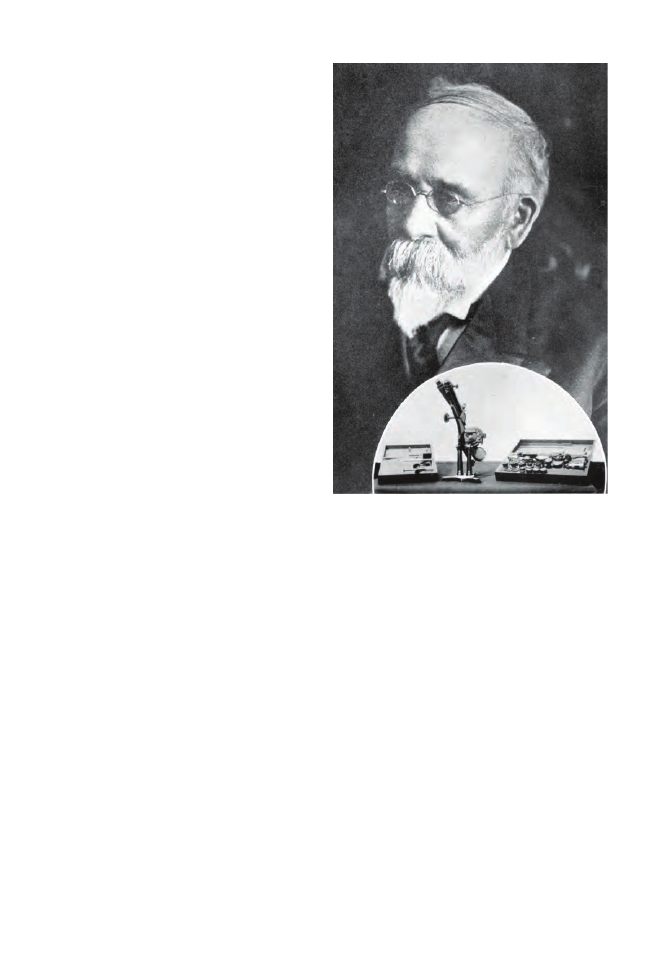
115
Plant Science Bulletin 58(3) 2012
permission from professor Prentiss, who gave me
the key to the case, I locked myself in the classroom,
and taking out the ponderous instrument, looked
it over, studied its complex machinery, and made
myself familiar with its structure and use” (Bessey,
1908, p. 86). He completed his B.S. degree in
November 1869 and began his first position at Iowa
Agricultural College the next month. He started
doing simple experiments in the lab, collecting
information from local farmers, and developing
exchanges with other botanists. The curriculum
was nearly as extensive as what he experienced in
Michigan. In the sophomore year, students began
with structural botany, using Gray’s text, while they
learned dissection and analysis in the laboratory.
Systematic botany was taken up “as soon as the
student is far enough advanced to do so” and
continued throughout the year. The first term of the
junior year was split between vegetable physiology,
economic botany, and cryptogamic botany—
all making use of the herbarium and college
microscopes (Pool, 1934-1935, p. 236). In 1872 the
AAAS met in Dubuque, Iowa, where Bessey, a new
member, first met Asa Gray, who was the current
President. Bessey arranged to spend his 3-month
winter break at Harvard, where he also worked with
George Goodale and studied fungi and systematics
(6 years before Goodale’s winter laboratory course).
The following year, back in Ames, he moved one
table, one microscope, and a few reagent jars into a
small room at the end of a corridor with a sign over
the door—“Botanical Laboratory.” Bessey claimed
that this was the “First botanical laboratory outside
of Harvard.” It was certainly the first botanical
laboratory for undergraduates in America.
Laboratory instruction.
By 1874 the botanical laboratory was an integral
part of Bessey’s teaching. The laboratory, and
particularly microscopy, became the centerpiece
of laboratory instruction at Ames. Within 2 years
there were seven compound microscopes and
graduate courses in physiological botany and
systematic botany. Four years later, in 1880, there
were 11 compound scopes in a new building with
a large botanical laboratory on the first floor. Three
years later, the lab had 21 student compound
microscopes and a “first class microscope, with
accessory apparatus, and high power objectives”
(Pool, 1934, p. 237). The microscope was necessary
for making careful observations, not only of the
anatomy of flowering plants but of a variety of
cryptogams. Detailed and accurate sketches would
not be sufficient. Later Bessey would write, “In our
botanical laboratories the student should be not
only taught to make measurements of everything
he studies, but the making of such measurements
should be a part of the study of the object” (Bessey,
1889a, p. 52). Bessey later took pride in recalling
that the administration and his faculty colleagues
believed “that the professor of botany was slightly
‘queered’ or out of his head when the subject of
microscopes was under discussion.” In 1882, when
a storm destroyed part of the science building,
Bessey’s only concern was for the state of his
research microscope, which he found undamaged
(Anonymous, 1934). The university president
“never really fully understood my insatiable thirst
for buying more microscopes” (Overfield, 1993, p.
25).
At Harvard, Bessey was also influenced by
Louis Agassiz, whose philosophy was similar to
Amos Eaton’s—to really learn biology, the student
Figure 5. Charles E. Bessey in about 1912. Inset,
Bessey’s $1200.00 Beck microscope from Iowa State
University. (Used with permission of Special Collec-
tions Department, Iowa State University Library.)
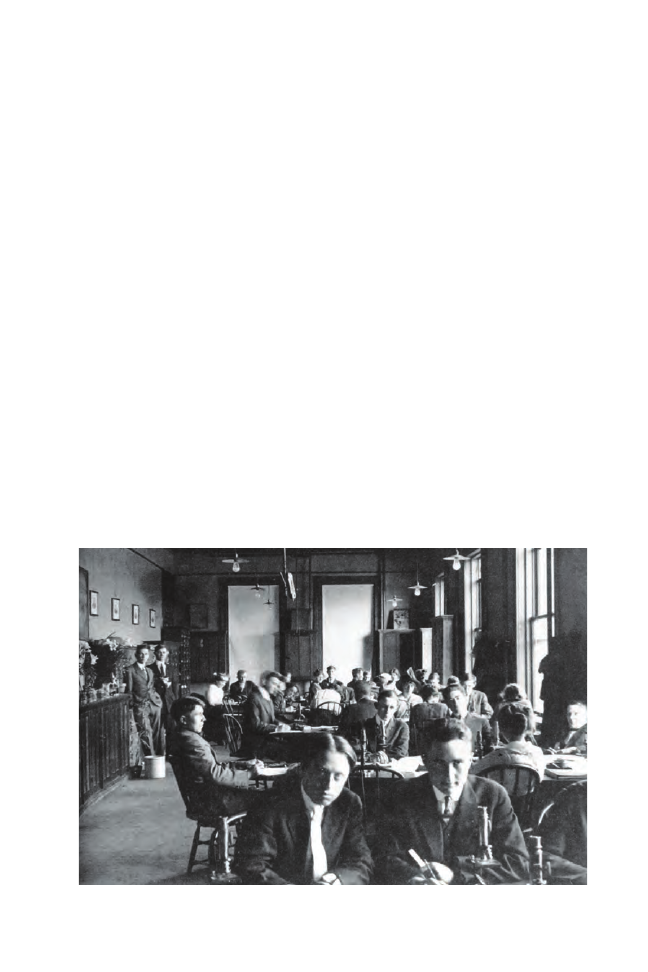
116
Plant Science Bulletin 58(3) 2012
must study nature, not books. Bessey made every
effort to bring into the laboratory living plants as
opposed to dried or pickled herbarium or museum
specimens. The student had to be able to touch and
work with the organisms to really investigate them.
Laboratory instruction became Bessey’s trademark
(Figure 6). While at the University of California in
1874-1875, he introduced botany students there to
the laboratory method and did the same during
a visit to Minnesota in 1881, where he offered a
summer school botany course for teachers (Bessey,
1881). By 1885, a dozen colleges had botanical
laboratories equipped with microscopes for student
use (Arthur, 1885). All the while, Bessey remained
active in his own research and was developing
a national reputation. In 1880 he was elected a
fellow of AAAS and also began a 17-year span of
providing the botanical editorial notes for each
issue of American Naturalist. From 1897 through
1915, he did the same for Science.
There is no doubt that Bessey was the driving
force behind introducing modern laboratory
instruction into the botany curriculum in this
country, but he was not working in a vacuum;
similar changes were occurring in England. Sir W.
T. Thiselton-Dyer later wrote, “The 1873 [botany]
course commenced on June 24 and lasted for six
weeks. The lectures presented no difficulty, as the
ground had already been gone over in Dublin. The
plan was that adopted by Huxley: a lecture at 10
o’clock and then an adjournment to the laboratory,
where each student was provided with a place,
microscope, and necessary instrumental appliances.
The work continued from 11 to 1 P.M. and from 2
till 4. It was expected that, with the assistance of
the lecturer and his assistants, the students would
then have succeeded in verifying every material
statement made in the lecture” (Thiselton-Dyer,
1925, p. 711). It is not clear whether either man
knew of the other’s work at that time, but it is clear
that similar trends were brewing, and others in
this country were aware of them (Rothrock, 1881).
In both England and America, it was beginning
to be recognized that “German science is the
professional investigation of detail, slowly attaining
generalizations. English science is the opposite
of this,—amateurish rather than professional”
(Anonymous, 1883, p. 456). It was time to follow,
and improve on, the German model.
Bessey’s botanical textbook.
In the early 1870s, Henry Holt and Company
planned a series of textbooks in the sciences and
approached Goodale at Harvard to write their
botany textbook. The resulting manuscript was
apparently not “sufficiently general,” and rather
than modify the text, Goodale suggested that
Bessey might be a more appropriate author for
Figure 6. Bessey’s botany laboratory in 1914. (Used with permission of the Archives and Special
Collections, University of Nebraska – Lincoln Libraries.)

117
Plant Science Bulletin 58(3) 2012
the project, given the successful series of lectures
he presented in California in 1875. The book had
to be suitable for a general introductory-level
audience, have an American orientation, contain
original illustrations, and include evolution. Before
accepting the project, Bessey contacted Gray to
get his opinion. Gray responded, “I wish you
success but [I] must not do more for your Holt and
Company book because it is intended to be one of
my rivals in that field, which is why Goodale could
not touch it” (Overfield, 1993, p. 26). One wonders
if Gray recalled his response to Wood’s request
decades earlier.
Botany for High Schools and Colleges (1880) was
published 2 years later. The approach of the book
was to help the student “to become himself an
observer and investigator, and thus to obtain at first
hand his knowledge of the anatomy and physiology
of plants…” (Bessey, 1880b, p. iii). The content
and organization was based on Sachs’ Lehrbuch
der Botanik (1868), and Bessey acknowledged
his reliance on Hofmeister, de Bary, Nageli,
Strassburger, Schwendener, and others. Here was
an American version of current botanical research
coming out of the best labs in Europe. Bessey noted
that he provided only a few major innovations
beyond Sachs. In Part One, General Anatomy and
Physiology, he recognized seven distinct tissue types:
parenchyma, collenchyma, sclerenchyma, fibrous
tissue, laticiferous tissue, sieve tissue, and tracheary
tissue, which was more similar to the treatment of
DeBary (1877). In Part Two, his major innovation
concerned his treatment of algae and fungi. Rather
than two divisions, one for Charophytes and one
for all the rest of the thallophytes, Bessey raised the
slime molds, bacteria, and blue-greens to a division
of their own: Protophyta. The diatoms, desmids,
water molds, and some green algae he included in
the division Zygosporae. The majority of the green
algae, some water molds, and the brown algae
were grouped into division Oosporeae, and the red
algae, ascomycetes, basidiomycetes, and Characeae
formed the Carposporeae. He also followed the
British, rather than the German, classification of
flowering plants. Ford’s comment that “Sachs’s and
Bessey’s work combined and viewed as essentially
the same document…” is a gross oversimplification
(Ford, 1964, p. 65).
Bessey’s last chapter contained a brief section on
“The Distribution of Plants in Time.” He realized
that Darwin’s theory of modification of species
was already having an impact on classification, but
even more importantly, Darwin’s growing body of
work was providing new insights in a wide field
of botanical study. “For the botanist of to-day,
plants are living, moving, feeling beings, whose
habits and movements, and the secrets of whose
lives are deemed worthy of the closest scrutiny
and observation. In this work, the proper work of
modern botany, Mr. Darwin led, and where he did
not enter himself, he pointed out the way. The titles
of his books alone, almost outline the whole work
of the student of plant life” (Bessey, 1882a, p. 507).
While Bessey never used the word “evolution,” he
understood that natural selection would gradually
lead to classification systems showing gradual
modification and differentiation of organisms,
generally from more simple to more complex.
Bessey was clearly inspired by Sachs, but his text
was certainly not as encyclopedic, nor written at the
same level, as its German model (Table 2, Figure
2). Nevertheless, it was accessible, it was modern,
and it was American. John Coulter’s (1880) review
in the Botanical Gazette expressed some of the most
positive opinions.
Of necessity the work could not be entirely or even
mostly original, but rather in Part I a following of that
done in the German laboratories and based chiefly
upon Sachs’ great “Lehrbuch.” In Part II the higher
plants of course conform to the system of Bentham
and Hooker. The classification and treatment of the
lower plants seem to be the author’s own work and
is probably the part of the book that is most original.
The book also contains constant suggestions with
regard to laboratory work, such as the best plant
from which to get certain tissues, etc., and the best
method of treatment. This enables the student to
go into the laboratory alone, or rather with the aid
of the experience of Prof. Bessey, one of the most
successful of teachers, and perform satisfactorily all
the elementary work in the histological structure of
plants. We would most cordially commend the work
to the use of all professors and students of botany not
only as the best American book upon the subject, but
the only one.—J.M.C.
On the other hand, many criticized the book,
saying it was too difficult, and the laboratory
approach was not an effective way to teach
students. According to Professor Eugene Hilgard
at California, the book may be “valuable for the
advanced student who wants to know more than
names and morphology, yet I find few of this type
of student.” He “tried to keep classes interested in
the details of vegetable anatomy and of microscopic

118
Plant Science Bulletin 58(3) 2012
1889b, p. 54-55). The Essentials of Botany was not
one of these. The general organization was the
same as in his larger book, but he suggested that he
considerably modified the language. He noted that
many technical terms were anglicized, particularly
in classification. For instance, Zygophyta became
zygophytes. (Perhaps students with Latin training
would have appreciated this?) “Distribution of
Plants in Geological Time” was moved forward to
the introductory chapter on classification. Despite
his attempts to simplify the reading, the Flesch-
Kincaid reading level of this elementary book was
also about 10th grade, no different from that of
his larger text (Table 2). However, in the preface,
Bessey does exhort teachers to use the text only as
a guide for students, not as facts to be memorized:
“Every effort should be made to have the pupil see
things for himself” (Bessey, 1884, p. iv).
The New Botany.
Bessey’s textbook was one of the first salvos of
“the new botany” in America, a term coined by Beal
(1880), at Michigan Agricultural College, but soon
taken up by other, mostly younger, midwestern
botanists including Bessey, Bessey’s undergraduate
and Master’s student, J. C. Arthur, and their mutual
friend John M. Coulter. In 1875 Coulter founded
the Botanical Gazette, which was to become the
mouthpiece of the younger generation of botanists.
In addition to traditional taxonomic reports, it
published anatomy, physiology, and a mix of news,
teaching, and advocacy for modern botany. In 1880
J. C. Arthur published the first teaching paper in
an American botanical journal, which suggested
that pumpkin is a most useful example of a dicot
stem to use in the laboratory (Arthur, 1880). Two
years later, Bessey suggested that Asparagus stem is
an optimal monocot for teaching (Bessey, 1882b).
The new botany involved both a change in the
emphasis of botanical study and also a change in
the methods of botanical instruction. Microscopy
was essential, and cells and tissues of a variety of
plants, particularly algae, fungi, and nonflowering
plants, were included in the curriculum. In the
early 1880s Beal outlined his pedagogical approach
in the Botanical Gazette. In the first class, students
were challenged to make careful observations and
comparisons of specimens specifically chosen to
highlight subtle characters to emphasize their self-
reliance and capabilities. The second day, students
would be required to make written descriptions of
their observations, and credit would be given for
this as well as for their recitations. Many of these
life but found year after year dropping more to
the view of Gray that it is first necessary to create
proper interest of what the student can see”
(Overfield, 1993, p. 34). Gray’s (1880) review in the
American Journal of Science was complimentary in
a backhanded way. “It speaks well for the progress
of science in the United States, when a professor in
a college in so new a State as Iowa, situated mid-
way between the Mississippi and the Missouri,
can produce so creditable a book as this. The work
concerns itself throughout with what the Germans
call ‘Scientific Botany,’—largely with vegetable
anatomy and development, and with particular
attention to the lower Cryptogamia…. It will indeed
form a substitute for it [Sachs’ Lehrbuch]; and the
systematic part, so far as it goes, is an improvement
upon the model…. Prof. Bessey’s volume is a
timely gift to American students of a good manual
of vegetable anatomy and of the structure and
classification of the lower cryptogamis, which was
very much needed. Here at least is a commendable
beginning.” An anonymous reviewer in 1881 wrote,
“It seems to us, nevertheless, that he is a little
infected with German dryness as is not unnatural
in a first edition of a book on a technical subject,
in which the Germans are masters. The book was
intended as a companion for the laboratory, and as
such, perhaps, we should not complain of it, but it
was also intended for the general reader, and in his
interest we recommend a little greater solution of
the solid contents. For it must be borne in mind
that many will want to learn from this book who
have not the advantage of witnessing Professor
Bessey’s skill in working” (Anonymous, 1881).
Given the reading level of Bessey’s book, compared
with the alternatives (Table 2), one wonders if this
reviewer had ulterior motives.
Holt wanted a second edition within 4 months
and also contracted with Bessey to produce a more
elementary text. The Essentials of Botany came out
in 1884. As noted above for the previous authors,
issuing new editions of textbooks was of common
occurrence in the United States, but the last quarter
of the 19th century set new standards for competing
textbooks (Table 3). Most of these were reviewed
by Bessey and/or the Botanical Gazette. By the late
1880s, we begin to see the review title “Another
School Botany,” which usually signaled a mundane
text—or worse. “Verily in botany ‘of making many
books there is no end,’ … Without question the book
cost the author a great deal of hard work, and it is a
pity that it has been such a waste of energy” (Bessey,

119
Plant Science Bulletin 58(3) 2012
Except in the case of Harvard, where a laboratory
was part of the original design of the building,
most of the early laboratories made use of re-fitted
existing rooms. By 1885, however, most of the
universities with laboratories had their own new
buildings, constructed with the laboratory in mind.
In most cases, these laboratories were dedicated
specifically to botany, but occasionally a lower-
division room was shared with zoology. Harvard,
Cornell, and Penn were conspicuous in being the
only older Eastern schools, and Penn was unique
in requiring an introductory biology course, with
laboratory, as an introduction to both advanced
botany and zoology courses. Wabash, the home base
of Coulter, was the only small liberal arts college
represented. The majority of schools supporting the
new botany were midwestern, and most were land-
grant colleges. Twelve years later, the universities
of California, Chicago, Columbia, Johns Hopkins,
Stanford, Minnesota, and Smith College could be
added to the list (Anonymous, 1897a). Except for
Columbia and Smith, these again were new colleges.
This dichotomy between the (old botany) East and
the (new botany) Midwest and West was likely an
expression of the attitude of professors: “In many
of our universities, and we are not now speaking
of agricultural colleges, which must be classed with
technical schools rather than with universities…”
(Farlow, 1876, p. 288). Proponents of the new botany
were not just interested in educating their students
and advancing knowledge in the discipline, they
were concerned with applying knowledge to solve
problems for the general good and welfare of the
people of their state or region (Anonymous, 1887a,
1894).
Yet, the two schools of thought recognized
some similarities. First, of all the natural sciences,
botany was most easily, and cheaply, applied to the
classroom. Second, the first requirement for a good
teacher was that he be thoroughly grounded in the
subject. And finally, school teachers must be taught
how to teach as well as what they should teach.
They also agreed that the task of a college professor
was made difficult by the diversity and motivation
of their students. Students could be divided into
three groups: those few with a passion and natural
aptitude for botany; generally good students taking
the course to fulfill some requirement; and those “…
whose principal aim in coming to college seems to
be to get as little good out of it as possible” (Farlow,
1876, p. 289; Bessey, 1886 a, b, c, d, 1887a, b, c).
During the 1880s and 1890s, the new botany
essays would be accompanied by drawings to help
explain certain points. All this was based on living
plants before the students were given assignments
in their textbook (Beal, 1881, 1885).
However, another new kind of textbook was
published in 1886 to guide students in their
laboratory investigations. The outline for the
Handbook of Plant Dissection (Arthur et al., 1886)
was drawn from Bessey’s botanical portion of
the 1881 Minnesota Summer Science School.
It provided a guide to studying the macro- and
microscopic structure of 12 plants beginning
with two blue-greens, Spirogyra, an oomycete and
an ascomycete, a liverwort and a moss, a fern,
a pine, oats, Trillium, and shepherd’s purse (the
host of the oomycete). The format of instruction
was based on Huxley and Martin’s (1875) biology
manual published a decade earlier in England.
The introductory chapter provided a brief listing
of the materials and equipment needed and a
description of how to use the microscope and
razor. (If you author your own lab manual, you
should read the descriptions of “Section Cutting,”
“Mounting,” “Applying Reagents,” and “Drawing”
before you do your next revision!) Each chapter
began with a general introduction to the organism’s
ecology and life history followed by the laboratory
instructions. Students were directed to begin with
gross anatomical observations and then move to
minute anatomy, utilizing whole mounts, peels, and
hand sections. The text provided simple directions
as to the type of preparation to make and then told
the student what to “notice.” Annotations at the
end of the chapter summarized what the student
should have seen and put this into the context of the
biology of the organism. Although it covered only
plant structure, this book was a model for a plethora
of laboratory manuals published in the next decade
in the same way that Bessey’s textbooks provided a
model for an explosion of new botany texts. It was
soon clear that the problem in promoting the new
botany was not one of available materials to support
instruction, nor in the students’ difficulty in
learning about such material, but rather it was the
average instructor’s deficiencies in understanding
physiology, internal structure, and nonvascular
plants (Overfield, 1993, p. 92).
The impact of the new botany can be seen by
the rapid development of teaching laboratories in
colleges around the country. By 1885, 12 universities
had adopted laboratory instruction in their botany
program (Table 4; Arthur, 1885; Bessey, 1886a).

120
Plant Science Bulletin 58(3) 2012
School
First Laboratory
Number of Labs
Number of
Microscopes
Hours Available
to Students
Harvard
University
1872
1 General
3 Specialized
21 Compound
9-5, MWF
Cornell
University
1872
2 Upper Division
3 Specialized
11 Dissection
12 Compound
8-5, M-Sat
Iowa
Agricultural
College
1873
General
Laboratory
21 Compound
2-5, M-Th
University of
Michigan
1874
Microscopy lab
General lab
43 Compound
6 Compound
8-12:30, M-F
University of
Illinois
1876
General
Laboratory
21 Compound
8-12, 1-5, M-F
Michigan
Agricultural
College
1880
General
Laboratory
27 Compound
n.a.
Purdue
University
1881
General
Laboratory
25 Dissection
25 Compound
9-4, M-F
9-12 Sat
University of
Wisconsin
1881
General Lab
Advanced Lab
11 Dissection
25 Compound
n.a.
University of
Pennsylvania
1884
Junior Lab
Senior Lab
24 Dissection
24 Compound
9-5, M-F
Wabash College
1884
General Lab
Advanced Lab
magnifiers
20 Compound
9-4, M-F
University of
Nebraska
1885
General
Laboratory
25 Dissection
22 Compound
1 Research-grade
9-4, M-F
Shaw School of
Botany
1885
General
Laboratory
16 Dissection
1 Compound
n.a.
Table 4. Botanical laboratories in U.S. colleges and universities by 1885.
Data derived from Arthur (1885) and Bessey (1886). n.a., hours available not reported.

121
Plant Science Bulletin 58(3) 2012
made dramatic inroads into college and university
curricula. Bessey and Coulter, from their editorial
positions in The American Naturalist and Botanical
Gazette, respectively, were cheerleaders for
the change and provided a sounding board for
others. “Botany in America was never in a more
flourishing condition than at the present time”
(Anonymous, 1886, p. 2). Plant anatomy, plant
physiology, and plant ecology were becoming
established disciplines, both in terms of research
publication and in their incorporation into the
botanical curriculum. Bessey, Beal, and others
were pushing to include practical botany, especially
agricultural botany, not only as research areas but
as educational fields on a par with more traditional
“basic” botany (Bailey, 1885, 1892; Bessey, 1886b, c;
Campbell, 1887; Anonymous, 1894; Arthur, 1895;
Beal, 1895). Bessey was also adamant that it was the
duty of botany teachers to encourage their students
to become proficient in German, French, and Latin
as part of their botanical training. “The literature
of Vegetable Anatomy and Physiology can only be
known to him in the meager translations of men
fortunately better trained than himself, while the
mass of the literature of systematic botany must
forever remain sealed to him…”(Bessey, 1887a, p.
767).
Bessey was particularly concerned that these
changes were not having enough impact on the
introductory-level courses and in the high schools.
He thought this was particularly important because
the introductory course was the only exposure most
students would be given to the subject. At the same
time, it had to provide an adequate foundation for
subsequent courses for those going on in botany.
On the basis of his experience, he felt that a general
view of the entire plant kingdom was critical. To
do this, a few typical examples of the major groups
should be collected by the students to be examined
for their general appearance, structure, and life
cycle. A few examples of these then should be
selected for closer analysis of anatomy, physiology,
and development using appropriate equipment
(Bessey, 1886b). Of course, this approach would be
more time consuming than a traditional approach,
but “…botany is a science of observation, and that
botanical study on the part of the pupil must consist
largely of training and practice in the observation
of plants” (Bessey, 1887b, p. 768).
Although the new botany gradually permeated
botanical instruction through the end of the century,
controversy continued to exist, not only with those
clinging to tradition but also over the best practices
for implementation. From the beginning, Bessey
valued collections and taxonomy, as he and many
of his students published on the flora of Nebraska.
His main concern was that collections go beyond
the flowering plants (Bessey, 1886d, 1887c). Yet his
advocacy for anatomical and physiological work,
his interests in fungi and cryptogams, and his
concern for practical applications in agriculture
gave the impression to many that there was no
room for “old-fashioned” taxonomy. The first
soundings of a problem echoed across the Atlantic
in 1884 in an exchange between George Henslow
(1884) and W. T. Thiselton-Dyer (1884) in Nature,
which was picked up and reported by Bessey (1885;
Anonymous, 1885). The controversy, and the way
toward resolution, were summarized thusly:
THE TWO EXTREMES of botanical teaching are
frequently referred to. They may be called the ancient
and the modern, and neither alone is productive of
the best results.… The ancient method gives a wide
range of acquaintance with external forms, a general
knowledge of the plant kingdom and its affinities,
a living interest in the surrounding flora; but it
disregards the underlying morphology of minute
structures and chemical processes, the great principles
which bring plant life into one organic whole. The
modern method, on the contrary, takes a few types,
carefully examines their minutest structures and
life work, and grounds well in general biological
principles; but it loses the relation of things, as well
as any knowledge of the display of the plant kingdom
in its endless diversity, and worse than all for the
naturalist, cultivates no love for a flora at hand and
inviting attention. The former is the method of the
field, the latter of the laboratory. The wise teacher
will adopt both methods and thus avoid the greatest
disadvantage of either. (Anonymous, 1887b, p. 87)
Differences of opinion also existed as to the most
effective sequencing of diversity. Bessey, in his text
and writings, encouraged teachers to begin with
the simplest organisms, bacteria, and end with the
flowering plants. Others argued that students are
most familiar with flowering plants, so you should
begin with what they know, and move gradually
to the less familiar. The point, simple to complex,
and counter-point, familiar to less familiar, were
argued succinctly in two articles titled “A mistake
in teaching botany” (Fink, 1893; Claypole, 1893).
While most of these discussions concerned
teaching botany at the college level, high school
teachers also entered the lists on the side of their
college champions (Hudson, 1894).

122
Plant Science Bulletin 58(3) 2012
vegetable life, he will lay a broad and at the same
time solid foundation of biological knowledge…
(Huxley, 1876). Although his audience for this
address was a special case where many graduates
of the new school were expected to go on for
professional medical training, it is clear that
Huxley’s new biology was meant to replace both
botany and zoology in the curriculum (Huxley and
Martin, 1875; Huxley, 1876, 1897; Jensen, 1993).
The botany/biology controversy came to a head
in the last decade of the century. Here there was no
argument about the importance of the laboratory
and the roles of anatomy and physiology in a
modern curriculum. There was also no argument
that the traditional fields of botany and zoology had
broadened and that specialization, and specialists,
were needed in the modern areas. The difference
was whether botany and zoology should coexist
independently or be joined in a broader biology.
C. O. Whitman (a founder of the American Society
of Zoologists) fired an opening shot with an article
on biological instruction in universities (1887).
Through most of the article, the only thing Bessey
and the new botanists might have taken exception
to was the admonition that colleges were becoming
too concerned with general education and practical
application and were not concerned enough about
the higher aims of generating new knowledge
through research.
Controversy erupted 4 years later with the
publication of Biological Teaching in the Colleges
of the United States (Campbell, 1891). This report,
commissioned by the Bureau of Education, U.S.
Department of the Interior, charged its author
to survey the dramatic changes in biological
education that had occurred in the previous 20
years. An interesting side note is that, even then,
Campbell acknowledged that changes in chemistry
and physics were ahead of those in Biology—
something that holds true in science pedagogy
today (Campbell, 1891, p. 9).
The botanical response to the monograph was
immediate. An editorial in the Botanical Gazette
noted the inequities in distribution of teaching,
with most universities having “two usually able
men teaching zoology, and practically no botanical
instruction” (Anonymous, 1890a, p. 180). If there
was botany instruction, it was usually limited to
the flowering plants, and in general, the older
institutions were the slowest to adopt laboratory
instruction. Two issues later, a contribution from
Botany vs. biology.
The example of the University of Pennsylvania,
noted above for its early implementation of
laboratories but with general biology as a
prerequisite to both botany and zoology, illustrates
the rapid inroad of a competing philosophy
developing at about the same time the new botany
was rising in the Midwest and in England. Biology
was transplanted from England and found root in
the East, particularly in the medical schools. As
early as 1854, Thomas Henry Huxley stated that
“…the educational bearings of Biology, in general,
does precede that of Special Zoology and Botany…”
(Huxley, 1897, p. 39). Huxley, sometimes referred
to as “Darwin’s bulldog,” was also an educational
reformer who was a strong advocate for teaching
science at all educational levels, beginning in
elementary school. In 1875, Huxley, along with his
protégé Henry N. Martin, published A Course of
Practical Instruction in Elementary Biology, which
was basically a laboratory manual for a course he
designed in 1872 for elementary school teachers. In
1875, Daniel Gilman, the newly appointed president
of the yet-to-be-opened Johns Hopkins University,
met with Huxley and was duly impressed. Not only
did he offer a position to Martin, but he invited
Huxley to be the inaugural speaker the following
year at the opening of the university.
Johns Hopkins was founded as a new kind
of research university, based on the German
model, and it was tied to its medical school. In his
address, Huxley elaborated on his philosophy of
education, much of which resonated with the new
botany. Science instruction should begin at the
elementary level and continue through the college
years. He stressed learning from observation
and experimentation and promoted laboratory
instruction as an effective pedagogy. Student
research was an essential component of instruction,
and when any lecturing was done, it should be
extemporaneous from notes, not read from a book
or manuscript. Students should be taught how
to learn, not how to memorize what others had
written. He also advocated having examinations at
the end of each course, rather than a comprehensive
examination at the end of a curriculum. In fact, the
only conflict he had with the proponents of the new
botany, was botany itself. “He [the student] will
study not botany and zoology, which I have said
take him too far away from his ultimate goal, but
by duly arranged instruction, combined with study,
in the laboratory, of the leading types of animal and

123
Plant Science Bulletin 58(3) 2012
“a prominent botanist” editorialized that “The one-
sided method of teaching biology pursued in one of
our great universities and emphasized in more than
one text-book is distinctly deplorable. One even
notes in certain circles a tendency to read botany
out of the scientific party altogether” (Anonymous,
1890b, p. 236).
The following month, “a prominent zoologist”
retorted that not long ago, when there was
no biology but only natural history, “Life and
biology—a discourse on life—lelbowed [sic] its
way into the curriculum. It was not until the
living Amoeba (the animal is not a myth) thrust
out its pseudopodia right in the very face of the
student, not until the action of the frog’s heart
was studied by every pupil, that biology came in.
Zoology brought the impetus and the idea and in
many a college where the botanist still goes his
weary round of finding out whether the ovule is
orthotropous or anatropous and of looking at the
placentation of the ovule, all study of life is still left
to the zoologist” (Anonymous, 1890c, p. 276.). The
zoology editors of The American Naturalist entered
the fray the following month, noting that at most
universities, biology is devoted almost entirely to
animals, but it is not their fault. “Fully half of the
teachers of botany are utterly unable to give any of
the living side of their subject. Analysis is all that
they know, and so when the zoologist goes as far as
he can, and teaches all that there is taught of life, is
he to be blamed for claiming the name?” (Cope and
Kingsley, 1890, p. 1050).
In reply to the zoological assertions that the
major concepts of biology can be taught solely
with zoological examples, Humphrey provided the
opposite tack with some examples in which plants
are better exemplars. But he also quoted one of his
zoological colleagues who “…could not understand
why botanists remain silent while chairs of biology
are repeatedly filled with zoölogists [sic] … ‘If I were
a botanist, I should be heard from’” (Humphrey,
1890, p. 341). Biologists continued (and continue)
to have the loudest voice; this was best summarized
by W. G. Farlow in his retrospective on the change
from the old botany to the new botany in the United
States. “I refer to what may be called the biological
epidemic which broke out soon after I returned to
America [in 1873 from studying in Germany] and
threatened for a time to drive botany from the field”
(Farlow, 1913).
In November of 1884, Bessey left Iowa State
University and assumed the duties of Professor of
Botany and Horticulture and Dean of the Industrial
College at the University of Nebraska in January 1885.
He vowed that the program at Nebraska would not
“still regard botany as a pleasant pastime consisting
mainly of flower hunting…” or where “the scientific
botanist was one who collected, dried, and pressed
into dead flatness the plants of his neighborhood,
only to attach to them afterword [sic] certain Latin
names….” He distinguished between two classes
of research, both of which would be important
in the department. One type was more practical,
with the goal of achieving immediate results; the
second was more fundamental, “in which the aim
is to discover some profound principle, or establish
beyond dispute some fact in nature … the two great
wants are a better knowledge of principles and
greater intelligence to apply them” (Bessey, 1885).
Throughout his career, Bessey complained that
botanists were not doing the kind of physiological
and pathological work that was needed and that
they generally tended to neglect cultivated plants.
Nebraska and Sem Bot.
The following year, his second at Nebraska,
seven of Bessey’s undergraduates informally
banded together to form a “club” of field botanists
calling themselves “Sem Bot” (the botanical
seminar). Originally a “secret society” organized
as an alternative to the “Greek” societies in
the humanities and languages, Bessey saw the
opportunity to harness this energy in the form
of a German-style seminar devoted to research.
Membership was opened to all botany students,
becoming a type of honorary academic society
who gathered for research seminars where key
and controversial botanical ideas were discussed,
and Bessey could reinforce his ideal of “eating and
breathing of botany.” Bessey’s advice was to “Let
your brain always contain much meristem, and
little permanent tissue and have a bias in favor of
new ideas” (Overfield, 1993, p. 158). He encouraged
students to work on their own projects and offered
free access to his own laboratory, the herbarium, and
library 6 days a week and occasional evenings. One
outcome was that the official “Flora of Nebraska”
for the botanical survey was the independently
organized ongoing product of Sem Bot members.
As the number of student members grew, with each
working on his own independent project, another
function of Sem Bot was to provide an annual
forum for student presentations, the model of
undergraduate and graduate student research days
on many campuses today. Notices of these final

124
Plant Science Bulletin 58(3) 2012
Sem Bot seminars were included among the reports
of regional scientific meetings announced in the
Botanical Gazette (Anonymous, 1897b).
Botany and AAAS.
As part of the professionalization of botany,
Bessey and his botanical peers were active in AAAS.
In 1883, during the AAAS meeting in Minneapolis,
they organized the Botanical Club, which met
during the meeting and provided a forum for
brief papers and reports that would not fit in the
regular section F, Biology. In 1890, 28 of the 48
papers presented in section F were by botanists,
and an additional 17 briefer papers, including one
on physiology laboratory apparatus by J. C. Arthur,
were presented (AAAS, 1890a, b). Arthur’s paper
appears to be the first presentation of a botanical
paper with an education focus at a national
meeting. Bessey suggested that the following year,
others should bring sketches and/or instruments
to share. Among the demonstrations presented in
1891 was a student reagent case brought by Dr. Beal
(AAAS, 1891). In 1892 Bessey was elected chair of
the new AAAS Botany Section, which would meet
for the first time in Madison the following year. At
Madison, 34 papers, one fifth of the papers presented
at the entire meeting, were in the new section G,
Botany. Most were related to the new botany, and
several of them addressed pedagogy. Conway
MacMillan, one of Bessey’s former students who
was then at Minnesota, presented “A preliminary
statement concerning botanical laboratories and
instruments in American universities and colleges.”
MacMillan noted that on the basis of survey
results, three different approaches were being used
in universities: “(1) those which do such work as
that offered by Gray’s “Lessons” and the “analysis”
of a few flowers; (2) those which simply study
types, after the Huxley and Martin method, and
have little or no botanical tendency; (3) those with
well-developed courses in all the various phases
of botanical activity.” As a result of the discussion
that followed MacMillan’s paper, a resolution was
passed requesting the commissioner of education to
publish a monograph on the subject of laboratories,
to be prepared by Professor MacMillan.
Botany and The Committee of Ten.
In addition to the laboratories motion, a second
motion was passed to appoint John M. Coulter, D. H.
Campbell, and Nathaniel L. Britton to a committee
with the charge of reporting at the next annual
meeting of the section concerning some feasible
way by which the section might use its influence in
securing better botanical instruction in secondary
schools. This charge was preempted by the National
Council of Education, which appointed The
Committee of Ten earlier that year. This committee
was charged to make national recommendations
for secondary school curricula, the best methods
of instruction, and the requirements for entry
into colleges. The chairman was Charles Eliot,
president of Harvard and a former student of
Asa Gray. The committee quickly organized nine
“conferences,” major discipline areas, among which
was natural history. Ten members were selected for
each conference, representing both colleges and
secondary schools. Both Coulter and Campbell
were chosen to represent botany. Rather than
Britton, however, the Committee chose Bessey
to be a third college botanist on the committee
(Committee of Ten, 1894).
Among the recommendations of the committee
was that botany and zoology should be taught
for at least an hour a week, preferably in smaller
blocks, from grades 1-8. This instruction should be
primarily experiential and not use a textbook. At
least a year of high school natural history should
be three fifths laboratory based. The latter should
be a minimum requirement for entrance to college.
The primary objectives at the elementary level
were to interest students in nature; to train them
in observing, comparing, and communicating (“to
develop in them a taste for original investigation”);
and to acquire specific knowledge “gained by
actual experience” (Committee, 1894, p. 142). A
detailed plan of study was suggested so that by the
end of 2 years, students would have a general idea
of the plant as a whole, living being. By the end
of 4 years, students should be asking “how” and
“why” and know something about plant growth
and reproduction as well as general uses and gross
structure of organs. After 6 years, students should
be self-reliant and independent with a general
knowledge of the life history of the whole plant,
and the last 2 years should introduce students to
fungi, algae, and nonvascular plants. High school
work should begin with at least a full year of
biology consisting of 3 days of lab, 1 day of lecture,
and 1 day for quizzing per week. A year and a half
was preferable and this should include at least a
semester of botany. Again, there should not be a
textbook, per se, but only a laboratory manual and
reference books. The course work should focus
on a survey from blue-greens through flowering
plants—basically the contents of Arthur et al.
(1886) with additional algal examples.

125
Plant Science Bulletin 58(3) 2012
the approach of beginning with the algae and
fungi and moving to the flowering plants (Trafton,
1902). It is interesting that at least one aspect of The
Committee of Ten’s recommendations continues to
have a significant impact on kindergarten through
12th-grade education today (Vázquez, 2006).
Biology continues to precede chemistry and physics
in most high school and college curricula.
Despite the appearance of consensus, however,
there continued to be dissension in the ranks. The
biology movement, referred to above, continued
to gain support, particularly from administrators,
at both the school and college levels. In addition,
the nature study movement began to usurp botany
in the schools (Jackman, 1894; Kohlstedt, 2005).
Although Coulter at the University of Chicago
and Bailey at Cornell University were among the
founders and strongest supporters of the nature
study movement, inadequate teacher preparation
and a plethora of publications weakened the
effort. “Many of these have been little more
than compilations of fantastic stories about
natural objects, made by persons with excellent
imaginations and a little inaccurate information
upon several scientific subjects. As a result nature
study is looked upon, in some localities, as a rather
frivolous pastime, which is not of any very great
importance in the real business of education”
(Caldwell, 1899, pp. 143-144). Finally, although
the new botany emphasized the importance of
both applied and fundamental botanical studies,
they would soon drift apart, in part because of the
attitude quoted above by Farlow 2 decades earlier
(Farlow, 1876, p. 288).
Acknowledgments
I want thank my wife, Sara, a colonial historian
who constantly encouraged me to look for the
bigger picture. Although many of the resources
cited are now available online, the collections of the
Anchutz and Spencer Libraries at the University
of Kansas, the Hale Library at Kansas State
University, and the William Allen White Library at
Emporia State University were essential resources.
Highlights of Charles E. Bessey’s role in botanical
education were presented at the Future of Botany
Teaching Symposium during the Botany 2008
meeting in Vancouver, British Columbia; this paper
was summarized in a presentation to the Historical
Section of the Botanical Society during the Botany
2011 meeting in St. Louis, Missouri.
The Botanical Society of
America.
The most significant activity of the 1893 AAAS
meeting for botany and botanical instruction was
the circuitous formation of the Botanical Society
of America, as described by Tippo (1958) and
Smokovitis (2006). In short, despite a committee
recommendation not to establish an independent
American botanical society separate from either
the botany section of AAAS or the associated
Botanical Club, Dr. Charles Barnes convinced those
present that the Botanical Club should approve “the
formation of an American botanical society whose
membership shall be restricted to those who have
published worthy work and are actively engaged
in botanical investigation. 2. That to this end the
Botanical Club proceeded to elect ten men who
beyond all question should belong to a society so
restricted. 3. That these ten be directed to select
fifteen additional members who in their judgment
fall well within the limits suggested.” Among the
original ten were Bessey and Coulter (Coulter,
1893a, b).
Botany had reached that stage of scientific
maturity that it could now sustain a national
society, and its membership included some of the
most influential scientists in the country. At the
same time, its leaders recognized the importance
of strengthening botanical education from the
elementary and secondary schools through
university and graduate work. Many of these
leading scientists were also leaders in the botanical
education movement, and they were committed to
an integration of basic science and applied science
with a place for both at the same table. This will be
the focus of the next paper in this series.
Conclusion
By the turn of the 20th century, Charles Bessey
and the other new botanists appeared to have
established a de facto consensus about the role
of botany as a professional discipline of natural
history and that botanical instruction should
begin in the elementary schools and be continued
through high school and into college. Furthermore,
a survey of a dozen botany textbooks of the time
demonstrated near congruence of emphasis on
ecology, physiology, gross morphology (structure
and modifications of seed plants), general
morphology (survey of the plant kingdom),
and special morphology (related to angiosperm
taxonomy), with the first three forming the
backbone of a course. Most of these books adopted

126
Plant Science Bulletin 58(3) 2012
The Department of Botany, Iowa State College,
cooperating with the Corn Research Institute of
the Iowa Agricultural Experiment Station.
ARNOLD, LOIS BARBER. 1984. Four lives in
science: women’s education in the nineteenth
century. New York: Schocken Books.
ARTHUR, J. C. 1880. Stem of pumpkin for teaching.
Botanical Gazette 5: 33-35.
ARTHUR, J. C. 1885. Some botanical laboratories
of the United States. Botanical Gazette 10: 395-
406.
ARTHUR, J. C. 1895. Development of vegetable
physiology. Botanical Gazette 20: 381-402.
ARTHUR, J. C., CHARLES R. BARNES, and
JOHN M. COULTER. 1886. Handbook of plant
dissection. New York: Henry Holt and Company.
BAILEY, L. H. Jr. 1885. Talks afield about plants and
the science of plants. Boston: Houghton Mifflin
and Company.
BAILEY, L. H. Jr. 1892. A plea for a broader botany.
Science 20: 48.
BEAL, W.J. 1879. The New Botany: A lecture on the
best method of teaching the science. In: Bessey,
Ernst A. 1925. William James Beal. Botanical
Gazette 79: 103-106.
BEAL, W. J. 1881. Beginning botany. Botanical
Gazette 6: 302-303.
BEAL, W. J. 1885. Beginning botany. American
Naturalist 19: 172.
BEAL, W. J. 1895. Teaching botany one topic at a
time, illustrated by suitable materials at any
season of the year. Science 1: 355.
BEAL, W. J. 1908. The College in 1870. In: T. C.
Blandell [ed.], Semi-centennial celebration
of Michigan State Agricultural College: May
twenty-sixth, twenty-ninth, thirtieth and thirty-
first, nineteen hundred seven. East Lansing: The
College.
BESSEY, CHARLES E. 1880a. A Sketch of the
Progress of Botany in the United States in the
Year 1879. American Naturalist 14: 862-870.
BESSEY, CHARLES E. 1880b. Botany for high
schools and colleges. New York: Henry Holt and
Company.
BESSEY, CHARLES E. 1881. Botany in Minnesota.
The American Naturalist 15: 732.
Literature Cited
AAAS [American Association for the Advancement
of Science]. 1890a. Papers at the Indianapolis
meeting of the AAAS. Botanical Gazette 15:
227-231.
AAAS [American Association for the Advancement
of Science]. 1890b. Meeting of the Botanical
Club at Indianapolis. Botanical Gazette 15: 231-
234.
AAAS [American Association for the Advancement
of Science]. 1891. Botanical Club of the A.A.A.S.
Botanical Gazette 16: 261-264.
ADAMS, J. F. A. 1887. Is botany a suitable study for
young men? Science 9: 116-117.
ANONYMOUS. 1881. Botany for high schools
and colleges, by Chas. E. Bessey. Bulletin of the
Torrey Botanical Club 8: 118-119.
ANONYMOUS. 1883. National traits in science.
Science 2: 455-457.
ANONYMOUS. 1885. Editorial notes. Botanical
Gazette 10: 216-217.
ANONYMOUS. 1886. Editorial. Botanical Gazette
11: 65-67.
ANONYMOUS. 1887a. Editorial. Botanical Gazette
12: 68.
ANONYMOUS. 1887b. Editorial. Botanical Gazette
12: 87-88.
ANONYMOUS. 1890a. Editorial. Botanical Gazette
15: 180.
ANONYMOUS. 1890b. Editorial. Botanical Gazette
15: 236-237.
ANONYMOUS. 1890c. Editorial. Botanical Gazette
15: 276.
ANONYMOUS. 1894. Editorial. Botanical Gazette
19: 160-161.
ANONYMOUS. 1897a. Opportunities for research
in botany offered by American institutions.
Botanical Gazette 23: 73-94.
ANONYMOUS. 1897b. At the last meeting of
the Botanical Seminar of the University of
Nebraska. Botanical Gazette 23: 229.
ANONYMOUS. 1934. Charles Edwin Bessey
and his microscope. Part 2. In: Symposia
commemorating six decades of the modern era
in botanical science, Vol. 1, 1-3. Ames (IA),

127
Plant Science Bulletin 58(3) 2012
BESSEY, CHARLES E. 1882a. Modern botany and
Mr. Darwin. The American Naturalist 16: 507-508.
BESSEY, CHARLES E. 1882b. The Asparagus stem
for laboratory study. The American Naturalist
16: 43.
BESSEY, CHARLES E. 1884. The essentials of
botany. New York: Henry Holt and Company.
BESSEY, CHARLES E. 1885. The younger school
of botanists. The American Naturalist 19: 73-74.
BESSEY, CHARLES E. 1886a. Botanical laboratories
in the United States. The American Naturalist
20: 281.
BESSEY, CHARLES E. 1886b. A broader elementary
botany. The American Naturalist 20: 728-729.
BESSEY, CHARLES E. 1886c. How shall botany be
taught in agricultural colleges? The American
Naturalist 20: 970-972.
BESSEY, CHARLES E. 1886d. Aids to botanizing.
The American Naturalist 20: 727-728.
BESSEY, CHARLES E. 1887a. Duty of botanists.
The American Naturalist 21: 767-768.
BESSEY, CHARLES E. 1887b. The element of time
in botanical study. The American Naturalist 21:
768-769.
BESSEY, CHARLES E. 1887c. Students as collectors.
The American Naturalist 21: 475-480.
BESSEY, CHARLES E. 1889a. The need of making
measurements in microscopical work. The
American Naturalist 23: 52-53.
BESSEY, CHARLES E. 1889b. Another school
botany. The American Naturalist 23: 54-55.
BESSEY, CHARLES E. 1908. How they taught
in the early days. In: T. C. Blandell [ed.],
Semi-centennial celebration of Michigan State
Agricultural College: May twenty-sixth, twenty-
ninth, thirtieth and thirty-first, nineteen hundred
seven. East Lansing: The College.
BESSEY, ERNST A. 1934-1935. The teaching of
botany sixty-five years ago. Iowa State College
Journal of Science II: 227-233.
BOLZAU, EMMA LYDIA. 1936. Almira Hart
Lincoln Phelps: her life and work. Philadelphia:
University of Pennsylvania.
CALDWELL, OTIS W. 1899. Nature study.
Botanical Gazette 27: 143-144.
CAMPBELL, DOUGLAS H. 1887. Anatomical
botany. Botanical Gazette 12: 68.
CAMPBELL, JOHN P. 1891. Biological teaching
in the colleges of the United States. Washington
(DC): Government Printing Office.
CLAYPOLE, E. W. 1893. A mistake in teaching
botany. Science 22: 317-318.
COMMITTEE OF TEN. 1894. Report of the
Committee of Ten on secondary school studies
with the reports of the conferences arranged by
the committee. New York: The American Book
Company.
COPE, E. D., and J. S. KINGSLEY. 1890. Editorial.
The American Naturalist 24: 1047-1050.
COULTER, JOHN. 1880. Review of botany for high
schools and colleges. Botanical Gazette 5: 96-98.
COULTER, JOHN M. 1893a. Proceedings of
section G, A.A.A.S., Madison meeting.
Botanical Gazette 18: 333-341.
COULTER, JOHN M. 1893b. Proceedings of the
Botanical Club, A.A.A.S., Madison meeting.
Botanical Gazette 18: 342-349.
CURTIS, MOSES. 1857. Letter to Asa Gray, 26
March. In: H. A. Dupree, Asa Gray: 1810-1888,
p. 454. Cambridge (MA): Harvard University Press.
“D.” 1842. Amos Eaton obituary. American Journal
of Science and Arts 43: 215-216.
DARLINGTON, WILLIAM. 1842. Review of Asa
Gray, 1842, The botanical text book, for colleges,
schools, and private students. American Journal
of Science and Arts 43: 388-389.
DE JUSSIEU, ANTONII LAURENTII. 1789.
Genera plantarum secundum ordinaes naturalis
disposita, juxta methoda in Horto regio
parisiensi exaratam anno M. DCC. LXXIV.
Paris: Theophilum Barrois.
DEBARY, A. 1877. Vergleichende Anatomie der
Vegetationsorgane der Phanerogamen und
Farne. Leipzig: Wilhelm Engelmann.
DUPREE, A. HUNTER. 1959 (1968 reprint). Asa
Gray: 1810-1888. New York: Atheneum.
EATON, AMOS. 1822. Manual of botany for
the northern and middle states of America:
containing generic and specific descriptions of the
indigenous plants and common cultivated exotics
growing north of Virginia. 3rd ed. Albany (NY):
Websters and Skinners.
EATON, AMOS. 1836. Manual of botany for
North America: containing generic and specific
descriptions of the indigenous plants and

128
Plant Science Bulletin 58(3) 2012
common cultivated exotics growing north of the
Gulf of Mexico. 7th ed. Albany (NY): Oliver
Steele.
EWAN, JOSEPH [ed.]. 1969. A short history of
botany in the United States. New York: Hafner
Publishing Company.
FARLOW, W. G. 1876. University instruction in
botany. The American Naturalist 10: 287-295.
FARLOW, W. G. 1913. The change from the old to
the new botany in the United States. Science 37:
79-86.
FINK, B. 1893. A mistake in teaching botany.
Science 22: 217-218.
FORD, CHARLES E. 1964. Botany texts: a survey
of their development in American higher
education, 1643-1906. History of Education
Quarterly 4: 59-71.
GANONG, WILLIAM F. 1899. The teaching
botanist: a manual of information upon botanical
instruction together with outlines and directions
for development of a comprehensive course. New
York: The Macmillan Company.
GOODALE, GEORGE LINCOLN. 1873. Review:
Sachs’ Lehrbuch, 3rd ed. Lehrbuch der Botanik
nach dem genenwärtigen-stand der Wissenschaft
bearbeitet von Dr. Julius Sachs. American Journal
of Science 5: 397.
GOODALE, GEORGE LINCOLN. 1875. Review:
Text-book of botany: morphological and
physiological by Julius Sachs, translated by A. W.
Bennett, M. A., and W. J. Thistleton Dyer, M. A.
American Journal of Science 10: 64-65.
GOODALE, GEORGE LINCOLN. 1879. Boston
Society for Natural History. Guides for science
teaching. II. Concerning a few common plants.
Boston. The Society.
GOODALE, GEORGE LINCOLN. 1885. Gray’s
botanical text-book. Vol. II. Physiological botany.
6th ed. New York: American Book Company.
GÖTHE, JOHAN WOLFGANG. 1790. Versuch de
Metamorphose der Planzen zu erklären. Gotha:
Ettingershe Buchhandlung.
GRAY, ASA. 1833. Letter to John Torrey, November
15. In: J. L. Gray [ed.], The Letters of Asa Gray,
Vol. 1, p. 38. Boston: Houghton Mifflin &
Company.
GRAY, ASA. 1836. Elements of Botany. New York:
G. & C. Carvill & Co.
GRAY, ASA. 1837. Letter to Moses Gray, October
8. In: J. L. Gray [ed.], The Letters of Asa Gray,
Vol. 1, p. 61-62. Boston: Houghton Mifflin &
Company.
GRAY, ASA. 1842. The botanical text-book:
comprising part I, an introduction to structural
and physiological botany; part II, the principle of
systematic botany. New York: Putnam.
GRAY, ASA. 1843. Letter to Mrs. John Torrey, 18
March. In: J. L. Gray [ed.], The Letters of Asa
Gray, Vol. 1, p. 302. Boston: Houghton Mifflin
& Company.
GRAY, ASA. 1844. Letter to John Torrey, Fall 1844.
Library of the New York Botanical Garden. In:
A. H. Dupree, 1959 (1968 reprint), Asa Gray:
1810-1888, p. 169. New York: Atheneum.
GRAY, ASA. 1845. Letter to John Torrey, November
15. In: J. L. Gray [ed.], The Letters of Asa Gray,
Vol. 1, p. 334. Boston: Houghton Mifflin &
Company.
GRAY, ASA. 1848. A manual of the botany of the
northern United States from New England to
Wisconsin and south to Ohio and Pennsylvania
inclusive, arranged according to the natural
system. Cambridge (MA): Metcalf and
Company.
GRAY, ASA. 1857. First lessons in botany and
vegetable physiology to which is added a copious
glossary or dictionary of botanical terms. New
York: Ivison, Phinney, Blakeman and Company.
GRAY, ASA. 1858a. How plants grow: a simple
introduction to structural botany with a popular
flora or a description and arrangement of
common plants both wild and cultivated. New
York: American Book Company.
GRAY, ASA. 1858b. Letter to George Bentham,
26 April. In: J. L. Gray [ed.], The Letters of Asa
Gray, Vol. 2, p. 438. Boston: Houghton Mifflin
& Company.
GRAY, ASA. 1866. Letter to Charles Wright, 19
May. In: J. L. Gray [ed.], The Letters of Asa Gray,
Vol. 2, p. 546. Boston: Houghton Mifflin &
Company.
GRAY, ASA. 1872. How plants behave: how they
move, climb, employ insects to work for them, &c.
New York: American Book Company.
GRAY, ASA. 1879. The botanical text-book. Part I.
Structural botany or organography on the basis
of morphology. To which is added the principles

129
Plant Science Bulletin 58(3) 2012
of taxonomy and phytography, and glossary
of botanical terms. 6th ed. New York: Ivison,
Blakeman, Taylor, and Company.
GRAY, ASA. 1880. Review: Botany for high schools
and colleges by Charles E. Bessey. American
Journal of Science 20: 337.
GRAY, ASA. 1887. The elements of botany, for
beginners and for scholars. New York: Ivison,
Blakeman & Co.
GREEN, J. REYNOLDS. 1967 (reissue of 1909). A
history of botany 1860-1900: being a continuation
of Sachs “History of botany, 1530-1860.” New
York: Russell & Russell.
HENSLOW, GEORGE. 1884. Biology v. botany.
Nature 30: 537.
HENSLOW, REVERAND PROFESSOR. 1858.
Illustrations to be employed in practical lessons
on botany. Adapted to beginners of all classes.
Prepared for the South Kensington Museum.
London: Chapman and Hall.
HOFMEISTER, WILHELM. 1865. Handbuch der
Physiologischen Botanik in verbindung mit A.
deBary, Th. Irmisch, N. Pringsheim, und J. Sachs
herausgegeben von Wilm. Hofmeister. Vierter
Band. Handbuch der Experimental-Physiologie
der Pflanzen von Prof. Julius Sachs. Leipzig:
Wilhelm Engelmann.
HUDSON, GEORGE H. 1894. An impeachment of
“school botany.” Science 23: 103-105.
HUMPHREY, JAMES ELLIS. 1890. “Biology”
again. Botanical Gazette 12: 340-341.
HUXLEY, THOMAS HENRY. 1876. Address on
university education. In: T. H. Huxley. 1897.
Science and education essays. New York: D.
Appleton and Company.
HUXLEY, THOMAS HENRY. 1897. Science and
education essays. New York: D. Appleton and
Company.
HUXLEY, THOMAS HENRY and HENRY
NEWELL MARTIN. 1875. A course of practical
instruction in elementary biology. London:
MacMillan and Co.
JACKMAN, WILBUR S. 1894. Nature study for the
common schools. 2nd ed. New York: Henry Holt
and Company.
JENSEN, J. VERNON. 1993. Thomas Henry
Huxley’s address at the opening of the Johns
Hopkins University in September, 1876. Notes
Received, Royal Society of London 47: 257-269.
KEENEY, ELIZABETH B. 1992. The botanizers:
amateur scientists in nineteenth century
America. Chapel Hill (NC): The University of
North Carolina Press.
KOHLSTEDT, SALLY GREGORY. 1990. Parlors,
primers, and public schooling: education for
science in nineteenth-century America. Isis 81:
424-445.
KOHLSTEDT, SALLY GREGORY. 2005. Nature,
not books: scientists and the origin of the
nature-study movement in the 1890s. Isis 96:
324-352.
KUSLAN, LOUIS I. 1966. Rensselaer and
Bridgewater: a footnote in the history of
American scientific education. Science
Education 50: 64-68.
LEIGHTON, R. F. 1880. Harvard examination
papers, collected and arranged. Boston: Ginn
and Heath.
LINCOLN, ALMIRA HART. 1829. Familiar lectures
on botany, including practical and elementary
botany with generic and specific descriptions of
the most common native and foreign plants and
a vocabulary of botanical terms for the use of
higher schools and academies. Hartford (CT): H.
and F. J. Huntington.
LINCOLN, MRS ALMIRA H. 1831. Familiar
lectures on botany, including practical and
elementary botany with generic and specific
descriptions of the most common native and
foreign plants and a vocabulary of botanical
terms for the use of higher schools and academies,
3
rd
ed. Hartford (CT): H. and F. J. Huntington.
LINCOLN, MRS. 1833. Botany for beginners: an
introduction to Mrs. Lincoln’s lectures on botany
for the use of common schools and the younger
pupils of higher schools and academies. Hartford
(CT): F. J. Huntington.
LINCOLN, MRS. ALMIRA H. 1836. Familiar
lectures on botany, practical elementary and
physiological; with an appendix containing
descriptions of the plants of the United States and
exotics &c. for the use of seminaries and private
students. 5th ed., revised and enlarged. Hartford
(CT): F. J. Huntington.
LINCOLN, MRS. ALMIRA H. (NOW MRS.
LINCOLN PHELPS). 1853. Familiar lectures
on botany explaining the structure, classification,
and uses of plants, illustrated upon the Linnaean
and natural methods with a flora for practical

130
Plant Science Bulletin 58(3) 2012
ROUSSEAU, J. J. 1787. Letters on the elements of
botany addressed to a lady. 2nd ed. Translated
by Thomas Martyn. London: B. White and Son.
RUDOLPH, EMANUEL D. 1984. Almira Hart
Lincoln Phelps (1793-1884) and the spread
of botany in nineteenth century America.
American Journal of Botany 71: 1161-1167.
RUDOLPH, FREDERICK. 1977. Curriculum: a
history of the American undergraduate course of
study since 1636. San Francisco: Jossey-Bass.
SACHS, JULIUS. 1868. Lehrbuch der Botanik
nach dem gegewärtigen stand der wissenschaft.
Leipzig: Wilhelm Engelmann.
SCHLEIDEN, J. M. 1849. Principles of scientific
botany or botany as an inductive science. 2nd
ed., translated by Edwin Lankester. London:
Spottiswoodes and Shaw.
SECORD, ANNE. 1994. Corresponding interests:
artisans and gentlemen in nineteenth-century
natural history. The British Journal for the
History of Science. 27: 383-408.
SHTEIR, ANN B. 1996. Cultivating women,
cultivating science: flora’s daughters and botany
in England, 1760-1860. Baltimore: Johns
Hopkins University Press.
SMOCOVITIS, V. B. 2006. One hundred years
of American botany: a short history of the
Botanical Society of America. American Journal
of Botany 93: 942-952.
STUCKEY, RONALD L. and WILLIAM R. BURK
[eds.]. 2000. Emanuel D. Rudolph’s studies in
the history of North American botany. Ft. Worth
(TX): Botanical Research Institute of Texas.
SUNDBERG, MARSHALL D. 2011. Botanical
education in the United States: part 1, the
impact of Linneaus and the foundations of
modern pedagogy. Plant Science Bulletin 57:
134-158.
THISELTON-DYER, W. T. 1884. The younger
school of botanists. Nature 30: 559.
THISELTON-DYER, W. T. 1925. Plant biology in
the ‘seventies [sic]. Nature. Supplement to May
9, 1925. pp. 709-712.
TIPPO, OSWALD. 1958. The early history of the
Botanical Society of America. In: W. C. Steere
[ed.], Fifty years of botany, pp. 1-13. New York:
McGraw-Hill.
botanists. For the use of colleges, schools, and
private students. New ed., revised and enlarged.
New York: F. J. Huntington and Company.
LINDLEY, JOHN. 1829. An introductory lecture
delivered in the University of London, on
Thursday, April 30. London: John Taylor.
LINDLEY, JOHN. 1831. An introduction to the
natural system of botany: or a systematic view
of the organization, natural affinities, and
geographical distribution of the whole vegetable
kingdom; together with the uses of the most
important species in medicine, the arts, and rural
or domestic economy. 1st American ed., with an
appendix by John Torrey. New York: G. & C. &
H. Carvill.
LINNAEUS, CARL. 1751. Philosophia botanica.
Translated by Stephen Freer, 2003. Oxford:
Oxford University Press.
LYON, CHARLES J. 1945. Centennial of Wood’s
class-book of botany. Science 101: 484-486.
MIRBEL, C. F. BOISSEAU. 1815. Elemens de
Physiologie Végétale et de Botanique, 2 Vols.
Paris: Magimel.
MORRILL ACT. 1862. Public Law 37-108, 12
STAT 503.–AN ACT Donating Public Lands
to the several States and Territories which may
provide Colleges for the Benefit of Agriculture
and Mechanic Arts. http://research.archives.
gov/description/299817
MORTON, A. G. 1981. History of botanical science:
an account of the development of botany from
ancient times to the present day. London:
Academic Press.
Obituary Notice, Alphonzo Wood. 1881. Botanical
Gazette 6: 168.
OVERFIELD, RICHARD A. 1993. Science with
practice: Charles E. Bessey and the maturing
of American botany. Ames (IA): Iowa State
University Press.
PAULY, PHILIP J. 2000. Biologists and the promise
of American life. Princeton (NJ): Princeton
University Press.
POOL, R. J. 1934-1935. The evolution and
differentiation of laboratory teaching in the
botanical sciences. Iowa State College Journal of
Science IX: 235-242.
ROTHROCK, J. T. 1881. Home and foreign modes
of teaching botany, III. Botanical Gazette 6: 233-235.

131
Plant Science Bulletin 58(3) 2012
TRAFTON, GILBERT H. 1902. A comparison
of recent authorities on methods of teaching
botany. The School Review 10: 138-145.
TREVIRANUS, L. C. 1806. Vom inwendigen Bau
der Gewächse und von der Saftbewegung in
demselben. Göttingen: Heinrich Dietrich.
VÁZQUEZ, JOSÉ. 2006. High school biology today:
what the Committee of Ten did not anticipate.
CBE-Life Sciences Education 5: 29-33.
WARNER, DEBORAH JEAN. 1978. Science
education for women in antebellum America.
Isis 69: 58-67.
WHITMAN, C. O. 1887. Biological instruction in
universities. The American Naturalist 21: 507-519.
WOOD, ALPHONSO. 1845. A class-book of botany
designed for colleges, academies, and other
seminaries where science is taught. Boston:
Crocker and Brewster.
WOOD, ALPHONSO. 1851. First lessons in botany:
designed for common schools in the United States.
Boston: Crocker and Brewster.
WOOD, ALPHONSO. 1853. First lessons in
botany: designed for colleges, academies, and
other seminaries. 29th ed. Claremont (NH):
Claremont Manufacturing Company.
WOOD, ALPHONSO. 1870. The new American
botanist and florist including lessons in the
structure, life, and growth of plants together with
a simple analytical flora descriptive of the native
and cultivated plants growing in the Atlantic
division of the American union. New York:
American Book Company.
WOOD, ALPHONSO. 1877. Wood’s illustrated
plant record and guide to analysis. New York:
A.S. Barnes & Company.
WOOD, ALPHONSO. 1879a. Fourteen weeks in
botany. New York: A. S. Barnes & Company.
WOOD, ALPHONSO. 1879b. How to study plants
being an illustrated flora. New York: A. S. Barnes
& Company.

132
has declined in traditional growing areas. As much
as 30% of yield can be lost to pests and disease.
In the Gulf countries and Egypt, the red palm
weevil has recently become a major date palm
pest, while Bayoud disease caused by a parasitic
fungus is a common threat to date palms in North
Africa. Technical and socio-economic factors
have contributed to decline in date palm quality.
Limitations in date processing and marketing have
affected economic revenue. Rehabilitation of date
palm trees in the Middle East is crucial, and needs
collaborative efforts and a dedicated budget. For all
these reasons, the recent release from CRC Press’s
innovative series, Medicinal and Aromatic Plants–
Industrial Crops, of its fiftieth volume, with the
publication of Dates: Production, Processing, Food,
and Medicinal Values, is especially timely. Featuring
the sweet fruit and fiber crop’s botany, chemistry,
production, processing, food, and medicinal
usage, it represents a comprehensive survey of
fundamental facts about date cultivation.
Divided into four sections, the book begins by
examining cultural practices and their inferences
for date quality. The contributors discuss tissue culture
studies, farm water management, mechanization,
approaches in pollination and harvesting operations,
and marketing aspects. The second section focuses
on postharvest operations such as drying and
explores alternatives for methyl bromide fumigation
and value-added products. It also reviews biofuel
manufacture from byproducts and discusses the
issue of waste generated from industry.
Section 3 highlights the physical, chemical,
Economic Botany
Dates: Production, Processing,
Food, and Medicinal Values
A. Manickavasagan, M. Mohamed Essa, and
E. Sukumar
2012. ISBN-13: 978-1-439-84945-3
Cloth, US$149.95. 442 pp.
CRC Press, Taylor and Francis Group, Boca
Raton, Florida, USA
The date palm (Phoenix dactylifera L.) is
cultivated and eaten worldwide in varying
amounts: in the United States, consumption might
be quantifiable in units of fruit, whereas in some
regions, intake typically may be measurable in
pounds per person. Date is a major agricultural
fruit crop in most countries in the West Asia and
North Africa (WANA) region. Since antiquity, dates
emerged linked with the histories of Mesopotamia,
Egypt, and North Africa. However, according to the
Food and Agriculture Organization of the United
Nations, the future of date palms is uncertain.
Serious problems hamper their cultivation: low
yields, damaging insects, and a lack of research.
During the past half century, date palm groves
have been subject to degradation due to increased
human activity. El-Juhany (2010) states that over
the past decade, productivity of date palm trees
Book Reviews
Books Reviewed
Economic Botany
Dates: Production, Processing, Food, and Medicinal Values ........................................132
Out of Nature: Why Drugs from Plants Matter to the Future of Humanity ...................134
Sesame: The Genus Sesamum .......................................................................................135
Education
Joseph Hooker: Botanical Trailblazer ............................................................................136
Systematics
Aquatic Plants of Pennsylvania: A Complete Reference Guide .....................................137
The Cape Orchids ...........................................................................................................138
The Jepson Manual: Vascular Plants of California, 2nd ed. ...........................................139
Peonies of the World: Polymorphism and Diversity ......................................................142

133
Plant Science Bulletin 58(3) 2012
or Babylonian era; two Roman-era coins picturing
date palms are also featured. The book’s attractive,
colorful cover displays the fruiting panicles of three
date varieties.
This reviewer observes a few grammatical errors
missed by the volume’s editors and the publisher’s
copy editor, and regrets the absence of much
splendid ethnobotanical data, detail in which the
subject of dates is so rich. One small example is
the famous Hadhrami Yemeni asid, a highly valued
aphrodisiac for which sesame oil is an essential
ingredient (Bedigian, 2004: 345).
Included among date foods is Chapter 21,
“Fermentative Products Using Dates as a Substrate,”
by Sivakumar, who mentions alcohol briefly (on
two pages), but omits any mention of aragi, a
powerful crude distilled alcoholic beverage made
of fermented dates, widely available openly, in this
writer’s experience, in bygone days (e.g., 40 years
ago) in Sudan. It is prepared secretly nowadays
by thousands of women in the squalid camps and
impoverished neighborhoods of those internally
displaced persons who fled years of war across
southern, western, and eastern Sudan. The recipe
is simple: put dates and baking powder in water;
cover with a plastic bag to protect against the
perpetual dust; bury underground for two to five
days, depending on the season; heat over a fire
and drip the piping hot liquid through a sieve;
dilute with water. To the people of Sudan residing
in neighboring Egypt, however, aragi is more
than a simple beverage; it is “a cultural artifact
whose value lies in its material and empirical
embeddedness in social practice” (Curley, 2009).
Curley investigated the symbolic role that aragi
plays in the establishment of identity among
displaced Sudanese living in Cairo: “For Sudanese
migrants in Egypt, aragi acts as a signifier, both
linguistic and cultural, of their identity.” Migrants
establish selfhood through various practices
involving aragi, within social, spatial, and material
spheres. “In Egypt, Sudanese identity and aragi (as
a cultural object) are ethnographically observed to
be contextually and semiotically bound through
their mutual signification in the word ‘aragi’.”
It’s unfortunate that this detailed work about
dates neglected substantial cultural aspects and
skipped considerable regional expertise.
–Dorothea Bedigian, Research Associate, Missouri
Botanical Garden, St. Louis, Missouri, USA
and structural characteristics of dates. It reviews
fermentative products that use dates as substrate,
discusses the fruits as a substitute for added
sugar in food, and explores date palm feeding to
livestock. The final section discusses nutritional use
and reviews the potential of dates in traditional and
alternative medicine.
Authors affiliated with institutions from the
following countries contributed to this volume:
Australia, Egypt, Iran, India, Japan, Nigeria,
Oman, Pakistan, Qatar, Saudi Arabia, United Arab
Emirates, and the United States. Surprisingly,
this book includes no authors working in many
WANA date-growing countries, e.g., none at all
from North Africa, not even from Tunisia, despite
the fact that there are six experts listed in the
Date Palm database active in date palm research
involving biotechnology with a laboratory devoted
to date tissue culture, nor from Morocco, with three
experts listed in the Date Palm database active in
date palm research, nor Algeria.
Sadly, despite the fact that the earliest known
evidence of date palm cultivation was recorded
from 4000 BC in Ur, lower Mesopotamia (now
Iraq), and two Iraqi experts are listed as active in
date palm research in the Date Palm database, this
volume contains not a single study from Iraq. It
would seem reasonable to assume that in Iraq—the
crop’s birthplace—war and neglect have taken their
toll. Iraq’s date industry, which once peaked at 30
million cultivated trees in the 1960s, has dwindled
to 13 million. No author from Sudan appears in this
book nor is indicated as active in date palm research
in the Date Palm database, despite Sudan’s diverse
date cultivars (Elshibli and Korpelainen, 2008, 2009)
and dedicated research centers at Wad Medani and
Shambat, reflecting perhaps how extensively civil
unrest and misdirected governmental priorities
have taken a toll on agricultural researchers who
must out-migrate from their countries of origin
to work elsewhere. No author represents Yemen
either, despite its substantial date cultivation in
Wadi Hadhramaut.
It is commendable that CRC Press allowed eight
pages of color illustrations, which enrich any volume
of this kind. Economic botanists will particularly
welcome Chapter 24, “Dates: A Fruit from Heaven”
by Qasim and Naqvi, since the authors provided
graceful ethnobotanical images illustrating Adam
and Eve with a date palm between them, and
another of the sacred date palm from the Sumerian

134
Plant Science Bulletin 58(3) 2012
Literature Cited
BEDIGIAN, D. 2004. History and lore of sesame in
Southwest Asia. Economic Botany 58: 329–353.
CURLEY, B. 2009. Siting Sudaneseness: Territory,
practice, and identity in aragi. Refuge 26: 183–
190.
DATE PALM EXPERTS DATABASE. Website
http://www.datepalm.org/palm_experts/index.
php [accessed 2 August 2012].
EL-JUHANY, L. I. 2010. Degradation of date palm
trees and date production in Arab countries:
Causes and potential rehabilitation. Australian
Journal of Basic and Applied Sciences 4: 3998–
4010.
ELSHIBLI, S., and H. KORPELAINEN. 2008.
Microsatellite markers reveal high genetic
diversity in date palm (Phoenix dactylifera L.)
germplasm from Sudan. Genetica 134:251–260.
ELSHIBLI, S., and H. KORPELAINEN. 2009.
Biodiversity of date palms (Phoenix dactylifera
L.) in Sudan: Chemical, morphological and
DNA polymorphisms of selected cultivars.
Plant Genetic Resources: Characterization and
Utilization 7: 194–203.
Out of Nature: Why Drugs from
Plants Matter to the Future of
Humanity
Kara Rogers
2012. ISBN-13: 978-0-8165-2969-8
Paperback, US$19.95. x + 204 pp.
University of Arizona Press, Tucson, Arizona,
USA
The author is the senior editor of biomedical
sciences at Encyclopaedia Brittannica, Inc., with
a BS in Biology and a PhD in pharmacology and
toxicology. However, this is not an academic treatise,
with literature citations after every other sentence.
There is, though, an extensive bibliography, not tied
to the text, which is sort of a “suggested reading”
segment—if your interests run to things like
“Induction of pilocarpine formation in jaborandi
leaves by salicylic acid and methyljasmonate.”
There are nine pages of these citations, arranged
alphabetically by author, not organized by chapter.
The running narrative is, of course, plant
chemistry, although not a single chemical formula
adorns its pages (or, some would say, mars its
pages). I judge that the work’s intended audience
is the college-educated public but not academic
specialists, and it deserves to be read by that public
because it is throughout an impassioned plea for
conservation and preservation. The author makes
the case that only 1% of the world’s plant species
have been tested for possible pharmacologic uses,
while species are being driven to extinction, some
famously, some silently.
In discussing plants, the author allows herself
some linguistic shortcuts. For example, she
speaks of collecting fruits of Taxus brevifolia, a
gymnosperm, for studies on taxol. (The taxol story
is given in great detail.) There are numerous other
simplifications that come perilously close to saying,
for example, “Plants have spines in order to ward off
herbivores.” She has no difficulty in stating that in
dioecious plant species, there are male and female
[sporophytes], just as in human beings. There
is even a discussion as to whether or not plants
have souls—in the context of certain religions.
It is asserted that the leaves of plants are covered
with stomata, despite the fact that the stomata in
gymnosperms are typically in bands, including
the Pacific yew noted above. It is also asserted that
there are 380,000 described species of plants, and
they all share the ability to photosynthesize, even
where mention of non-photosynthetic flowering
plants like Conopholis, Epifagus, and Monotropa
would strengthen the argument for the amazing
diversity of plants.
The winding, agonizingly slow, and hugely
expensive path from a plant in the wild to a
therapeutic drug at the pharmacy is given special
attention. The roles of academic scientists and
their counterparts in the pharmaceutical industry
are also treated in detail. These tales are the main
strength of the book. The point is made repeatedly
that it all depends ultimately on maintaining
biodiversity and intact ecosystems. But the dangers
to these systems are very largely due to burgeoning
human populations, which are in turn greatly
aided by pharmaceuticals that treat and prevent
“premature” deaths. This built-in contradiction
is not even hinted at. Indeed, the most effective
contraceptive drugs, whose origins were originally
from plants, are not mentioned in this work. It is
a conundrum: a paradoxical, insoluble, or difficult
problem; a dilemma. If there is a solution, it lies
not in the chemistry laboratory but in changing
attitudes in the human animal. One suspects the
author wisely decided that would have to be the
subject of a whole other book.
–Neil A. Harriman, Biology Department, University
of Wisconsin-Oshkosh, Oshkosh, Wisconsin, USA.
harriman@uwosh.edu

135
Plant Science Bulletin 58(3) 2012
The crop has been cultivated from some 5000
years. Accordingly, there is an extensive body of
folklore, which is touched on in many places in the
book. The phrase “Open, sesame,” is said to refer
to dehiscence of the capsule of this “magical” plant.
As one would expect, sesame oil is widely employed
in folk medicine to treat toothaches, headaches,
insomnia, anxiety, and burns. There are health food
claims for its effects in lowering bad cholesterol, not
to mention protecting against colon cancer, high
blood pressure, and an array of other ills.
This volume includes a full chapter on “Sesame Seed
Food Allergy,” written by Suzanne Teuber, M.D., a
professor of rheumatology, allergy, and clinical
immunology at the University of California–Davis.
The chapter is a primer on food allergies in general,
and will be read with interest by those afflicted;
she points out that people allergic to peanuts and
various tree nuts may also be allergic to sesame
seeds. It appears that sesame seeds are ubiquitous
in the food supply—McDonald’s hamburger buns
are mentioned several times.
Chapter 25, “Current Market Trends,” by Professor
Bedigian, may be the chapter of greatest interest
to some readers, because she has amassed an
extraordinary array of information on the subject,
including insights and anecdotes that are surely
unavailable anywhere else. Both food and skin care
uses are surveyed extensively, but also included
is the tidbit that sesame is planted as a food plant
for quail, doves, and pheasant in the southeastern
United States. The plant is a minor component of
the weed flora in some parts of the United States.
This work will long stand as the standard reference
on the subject, and one can only wish Professor
Bedigian every success in seeing to completion her
taxonomic revision of the genus.
–Neil A. Harriman, Biology Department, University
of Wisconsin-Oshkosh, Oshkosh, Wisconsin 54901.
USA. harriman@uwosh.edu
Sesame: The Genus Sesamum
Dorothea Bedigian, ed.
2010. ISBN-13: 978-0-8493-3538-9
Hardcover, US$135.95. xxiii + 532 pp.
CRC Press, Taylor and Francis Group, Boca
Raton, Florida, USA
The editor of this volume is a long-time student of
the genus. She is the author of six chapters of this
work, with the other 20 chapters authored by an
array of experts on various facets of these plants, in
particular chemistry and various contributions on
its local culture in places such as Turkey, China, and
Ethiopia. The cultivated crop is Sesamum indicum
L., Pedaliaceae. She makes clear that the name is a
nomen conservandum, but she does not stress that
Sesamum orientale L., its competing heterotypic
synonym, is a nomen rejiciendum; the rejected
name was once fairly widespread in the literature,
and continues to be used to a minor extent.
There is some doubt as to how many species there
are in the genus, perhaps 25 or more. Apparently,
no one has ever monographed the genus, although
Professor Bedigian makes repeated reference to a
“forthcoming taxonomic revision,” from her hand.
There are no keys. As a result, her discussion of the
four sections of the genus, and of some of the species
within each section, is difficult to follow. There are
statements about which binomials ought to be
reduced to synonymy, but these are not supported
by any reference to type specimens, competing
dates of publication, or other formal taxonomic
apparatus. The beautiful cover illustration in color,
unidentified after the title page by the publisher, is
Fig. 2.1 (p. 34) in the text.
The primary use of the plant is sesame oil, which
is extracted from the seeds. It is widely used in
cooking, and is said to be notable for its stability
at room temperature (but two experienced cooks
whom I consulted said that it so quickly becomes
rancid that they stopped using it). It is pricey,
because the seeds are collected by hand. The fruits
do not mature all at once and dehisce readily. As a
result, farmers cut off or uproot the plants and stack
them vertically, to wait for the majority of the fruits
to mature. At present, 99% of the world’s sesame
seed is harvested by hand. Races with indehiscent
fruits have been discovered, but apparently these
have not made their way into modern agriculture.

136
Plant Science Bulletin 58(3) 2012
EDUCATION
Joseph Hooker: Botanical Trailblazer
Pat Griggs
2012. ISBN-13: 978-1-84246-469-4
Paperback, US$17.00. 64 pp.
Kew Publishing, Royal Botanic Gardens,
Kew. Distributed by University of Chicago
Press, Chicago, Illinois, USA
This slim, exquisitely illustrated volume seems
to satisfy a noble goal, to popularize botany.
Appealing to a wide audience—readers interested
in biography, botanical illustration, botanical and
herbarium history, or adventurous colonial-era
travel and exploration—this would seem to be an
elegant souvenir of a visit to the world-renowned
Royal Botanic Gardens, Kew.
The subject, Joseph Hooker (1817–1911), is
substantial. He turned his humble employment,
requiring world travels (i.e., achieved without a
wealthy sponsor), into plant collecting expeditions,
first to Antarctica and later to India and the
Himalayas. A pioneering practicing botanist—
even before the term “scientist” was coined, as the
book’s Introduction by Jim Endersby points out—
his “early travels left him with a lifelong fascination
with the geographical distribution of plants” [p.
10]. Hooker identified, described, or introduced
over 12,000 plant species. His publications assured
his reputation among his peers and as a 40-year-
long confidante of Charles Darwin, ensured his
pedigree.
Joseph Hooker became Assistant Director of the
Royal Botanic Gardens, Kew, in 1855; in 1865,
Hooker followed his father Sir William Hooker as
the director of Kew. He completed an expedition
to the western United States with America’s
foremost botanist, Asa Gray, in 1877, bringing
back 1000 new specimens. Botanists involved
with writing regional floras or genus revisions will
celebrate Hooker’s persistent goal: increasing Kew’s
collections is pervasive, throughout this book.
Some of Hooker’s other travels included journeys to
Morocco, Palestine, and Syria. Sir William Hooker
established Kew’s Economic Botany collection,
comprising 85,000 items; his son Joseph collected
many during those collecting trips.
Author Pat Griggs, Kew’s science writer, prepared
the book in conjunction with an exhibition about
Joseph Hooker at the Shirley Sherwood Gallery at
the Royal Botanic Gardens, Kew. She writes that
young Joseph Hooker used to sit in on his father’s
lectures and tag along on field trips. All he wanted
to do with his life was to study plants. However,
recognizing that professionals in the other sciences
did not think much of botany, Joseph became a
doctor and used this title (and his father’s contacts)
to secure a place on an expedition to the Antarctic.
Hooker requested an appointment as the ship’s
botanist, and the expedition commander granted
Hooker this “meaningless title.”
This book lavishly illustrates the critical role
that drawing has played in our understanding of
plants and nature. Griggs does readers a service,
presenting Hooker’s pencil sketches alongside his
watercolor paintings and the paintings by Hooker’s
talented collaborator, Walter Hood Fitch. Fitch,
a botanical artist and lithographer, was also the
illustrator for Curtis’s Botanical Magazine. The
paintings and lithographs Fitch created for Hooker
were based on Hooker’s field drawings. Excerpts
from Joseph Hooker’s field journal and personal
letters are also included in the book, and they
offer a limited glimpse at the extensive notes and
copious illustrations he must have created during
his lifetime.
Hooker’s own plant studies, in pencil sketches and
watercolors, are dynamic, with dissected plant parts
that lead one to contemplate how each species is
constructed. A list of references includes links to
websites where readers can view digitized copies of
Hooker’s books and field notes dating from 1849–
1878. Along with the historical text and botanical
images in the book, Griggs provides an informative
timeline of significant events in Joseph Hooker’s
life. Prediction: peruse this tribute to Joseph
Hooker, and you’ll get “hooked” on plants!
–Dorothea Bedigian, Research Associate, Missouri
Botanical Garden, St. Louis, Missouri, USA

137
Plant Science Bulletin 58(3) 2012
Systematics
Aquatic Plants of Pennsylvania:
A Complete Reference Guide
Timothy A. Block and Ann Fowler Rhoads
2011. ISBN-13: 978-0-8122-4306-2
Hardcover, US$59.95. 320 pp.
University of Pennsylvania Press, Philadel-
phia, Pennsylvania, USA
Aquatic Plants of Pennsylvania: A Complete
Reference Guide lives up to the status and caliber
of the other botanical reference books for
Pennsylvania written by the same authors, The
Plants of Pennsylvania: An Illustrated Manual and
The Trees of Pennsylvania: A Complete Reference
Guide. In a similar format as these two previous
reference materials, Aquatic Plants of Pennsylvania:
A Complete Reference Guide provides the most
accurate, up-to-date botanical information on
aquatic plants in a reader-friendly, easy-to-use
layout.
The book starts with a brief, informative
introduction to aquatic plants and aquatic habitats
in Pennsylvania, a region that includes such diverse
components as glacial lakes, extensive wetlands,
rivers, and the Delaware River estuary. A simple
drawing of the phylogenetic relationships of aquatic
plants is included, in which mosses, horsetails, and
ferns are not pictured despite their isolated and
relatively old branches on the green tree of life.
The dichotomous keys used to identify aquatic
plants are organized by growth habit and are easy
enough for an amateur to use. The rest of the book
is composed of detailed botanical descriptions
that are both scientifically correct and easy to
understand. We used this book to successfully key
out aquatic plants in a Rutgers University college
course last fall without any major problems.
We found one mistake in the key, though, since
Cabomba is keyed out under “leaves limp when
lifted out of the water” and “leaves not crowded
towards branch apices.” The species descriptions are
detailed and adapted to a general public interested
in nature more than expert botanists. Species are
listed as either “native” or “introduced”; however,
this refers to Pennsylvania only, since U.S. native
species such as Cabomba caroliniana are listed as
“introduced.”
Color photographs, line drawings, and
distribution maps of every species make this
guide useful for both experts and amateurs alike.
Unfortunately, the weakest part of the book is the
illustrations—pen-and-ink drawings by Anna
Anisko. There is often space for much larger
illustrations with magnified details (flowers,
fruits, leaf margins, etc.), but instead there are
large empty white spaces with a smaller-than-
necessary simple drawing on it. For example, the
drawings of charophyte algae could have been
enlarged substantially. Important characters are
not highlighted with precise illustrations and the
quality of the drawings varies considerably, with
some species having excellent, high-resolution
drawings, and others much less so.
Each species is accompanied by a distribution
map showing major rivers, county borders, and the
southern edge of the latest Wisconsin glaciation.
Georeferenced specimen data are mapped onto
these base maps and provide excellent spatial data.
The color photos are mostly of excellent quality, but
some common species are missing photos, such as
watercress (which instead has half a white page, did
the photo get lost?).
Although distribution maps and illustrations are
useful for identification, the book is not as compact
as it could be due to these inclusions (194 species
are covered in 308 pages). In fact, the book could
have been made more as a field guide with less
“white space,” a more compact formatting, and
better illustration layouts. However, the book is still
functional and condensed enough to be used in the
field and contains excellent information. Whether
you are new to botany or an expert in the field, an
amateur naturalist or a professional biologist, a
horticulturist or a natural resources manager, this
book is an essential and useful addition for anyone
dealing with aquatic plants in the mid-Atlantic
region of North America.
– Lauren D. Spitz and Lena Struwe, Rutgers Univer-
sity, New Brunswick, New Jersey, USA

138
Plant Science Bulletin 58(3) 2012
The Cape Orchids
William R. Liltved and Steven D. Johnson
2012. ISBN-13: 978-0-9870197-0-7 (Stan-
dard edition); ISBN-13: 978-0-9870197-3-8
(Collectors’ edition)
Standard edition: US$380.00 (€305.00,
₤
240.00). Inquiries to capeorchids@gmail.
com
Hardcover, 2 vols., xix + 1022 pp.
Sandstone Editions, Cape Town, South Africa
The Cape Floristic Region (CFR) comprises
90,000 km
2
and includes about 9100 plant species,
70–80% of which are endemic, making it just about
the hottest of biodiversity hotspots. Orchidaceae
comprise the 10th largest plant family in the CFR
with 24 genera and 241 species, two thirds of which
are endemic. All have been treated in previous
modern floras (e.g., Stewart et al., 1982; Linder and
Kurzweil, 1999) from the angle of systematics with
artificial keys to the taxa. The Cape Orchids focuses
instead on natural history—what the authors call
a holistic approach—to understand that unique
orchid flora. Bound in two volumes with a full-
color slipcase, this title represents over 20 years
of fieldwork and photography, supplemented by
invited essays from 23 contributors. It includes more
than 2000 color photographs and reproductions of
both historical and modern paintings of the species
printed on 128 gsm (about 80 lb.) matte art paper.
As a result, the set is heavy, weighing 6 kg, hardly
a convenient field guide that can be tossed into a
stuffed backpack at the last minute.
However, neither is it meant to be consigned to
the coffee table. This is a masterwork that provides
such an overwhelming amount of data that it can
only be considered encyclopedic. The Introduction
thoroughly covers the biomes and vegetation of
the CFR as well as its geology, fossil plants and
past climates, ethnobotany, habitat loss, and
conservation status of South African orchids. That
fascinating commentary is followed by authoritative
chapters on the history of botanical exploration in
the CFR from 1652 to the present with emphasis
on the life and work of Harry Bolus (1834–1911),
orchid morphology, fire ecology, pollination and
natural hybridization, and cultivation and artificial
hybridization.
Most of the two-volume set is devoted to
species accounts, first the terrestrials and then the
relatively few epiphytes. The systematic account
of tribe Diseae in The Cape Orchids is in general
accord with that of Kurzweil and Linder (2001)
in volume 2 of Genera Orchidacearum, although
some updating has been necessary in light of more
recent molecular studies by Bellstedt et al. (2001),
Van der Niet et al. (2005), Bytebier et al. (2008),
and Waterman et al. (2009). For each species, the
authors include derivation of the specific epithet,
common names, description, flowering period,
history and relationships, distribution, field notes
and biology, and references. Illustrating the habitats
and key characters are high-definition photographs
(principally by the authors and Austrian orchid
photographer Herbert Stärker); historical
watercolors from Edwards’s Botanical Register,
Curtis’s Botanical Magazine, and Bolus’s Orchids
of South Africa (among others); and modern
watercolors by Fay Anderson, which are often
juxtaposed with photographs to reveal features not
otherwise shown. A fire in Ms. Anderson’s home
in 1996 destroyed many of her paintings, but some
could be salvaged and repainted for publication
here.
Many species accounts are supplemented with
well-written, short essays on the collector or
eponym of the species. One of the most interesting
in this respect is Holothrix burchellii (Lindl.) Rchb.f.,
commemorating William John Burchell, who
was trained as an apprentice at the Royal Botanic
Gardens, Kew, and became a Fellow of the Linnean
Society at the age of 21. He traveled throughout the
Cape from November 1810 to October 1812 and
described and illustrated his fieldwork in Travels
in the Interior of Southern Africa. Burchell returned
to England with over 40,000 plant specimens and
120 skins of 95 quadrupeds and 265 bird taxa. He
described the white rhinoceros (Ceratotherium
simum Burchell) and discovered Burchell’s zebra
(Equus burchellii Gray) as well as the orchid
genus Pachites. Disabled and depressed, Burchell
committed suicide at the age of 81. Essays on other
well-known eponyms include Swedish botanists
Carl Peter Thunberg and Olaf Peter Swartz, British
astronomer Sir John Herschel, and British botanists
John Lindley and Francis Masson. Masson’s
specimen of the cycad Encephalartos altensteinii
Lehm. (collected as E. longifolius (Jacq.) Lehm. in
the Eastern Cape in the 1770s) is still thriving in
the Palm House at the Royal Botanic Gardens, Kew,
making it one of the oldest pot-plants in the world.

139
Plant Science Bulletin 58(3) 2012
STEWART, J., H. P. LINDER, E. A. SCHELPE, and
A.V. HALL. 1982. Wild Orchids of Southern
Africa. Macmillan South Africa, Johannesburg,
South Africa.
VAN DER NIET, T., H. P. LINDER, B. BYTEBIER,
and D. U. BELLSTEDT. 2005. Molecular
markers reject monophyly of the subgenera of
Satyrium. Systematic Botany 30: 263–274.
WATERMAN, R. J., A. PAUW, T. G. BARRACLOUGH,
and V. SAVOLAINEN. 2009. Pollinators
underestimated: A molecular phylogeny reveals
widespread floral convergence in oil-secreting
orchids (sub-tribe [sic] Coryciinae) of the Cape
of South Africa. Molecular Phylogenetics and
Evolution 51: 100–110.
–Alec Pridgeon, Sainsbury Orchid Fellow, Royal
Botanic Gardens, Kew, Richmond, Surrey, United
Kingdom
Volume 2 begins with a 350-page account of the
180 species of Disa, arranged in 18 sections (17
occurring in the CFR), and ends with coverage
of the five genera of epiphytes found there—
Polystachya, Angraecum, Cyrtorchis, Mystacidium,
and Tridactyle. The work closes with recent Cape
orchid photographs, references to Cape orchids
in Bolus’s published works, a glossary of botanical
terms, vignettes of the authors and contributors,
glossary, and index.
A trivial criticism is that a given species account
is difficult to find without consulting the index,
and so the reader is forced to juggle the volumes
for those taxa treated in volume 1. A quick locator
list of the taxa by page number on the endpapers
of each volume with corresponding page numbers
would have been useful. In the Table of Contents,
those few genera outside of tribe Diseae are listed
without any systematic context; inclusion of at
least their subfamily name in parentheses could
have added significant systematic information
(complementing Table 1 on page 15) with little loss
of space.
The wealth of data and treasury of superb
illustrations make this one of the best regional
monographs (regardless of plant family) in recent
memory. I recommend The Cape Orchids to
botanists in all disciplines and to institutional
libraries, as it is a valuable work that will not soon
become obsolete—barring extinctions, of course.
LITERATURE CITED
BELLSTEDT, D. U., H. P. LINDER, and E. H.
HARLEY. 2001. Phylogenetic relationships
in Disa based on non-coding trnL-trnF
chloroplast sequences: Evidence of numerous
repeat regions. American Journal of Botany 88:
2088–2100.
BYTEBIER, B., D. U. BELLSTEDT, and H. P.
LINDER. 2008. A new phylogeny-based
sectional classification for the large African
orchid genus Disa. Taxon 57: 1233–1251.
KURZWEIL, H., and H. P. LINDER. 2001. Tribe
Diseae. In A. M. Pridgeon, P. J. Cribb. M. W.
Chase, and F. N. Rasmussen (eds.), Genera
Orchidacearum, Volume 2. Orchidoideae (Part
One) 11–58. Oxford University Press, Oxford,
United Kingdom.
LINDER, H. P., and H. KURZWEIL. 1999. Orchids
of Southern Africa. A. A. Balkema, Rotterdam,
Netherlands.
The Jepson Manual: Vascular
Plants of California, 2nd ed.
Bruce G. Baldwin, Douglas H. Goldman,
David J. Keil, Robert Patterson, Thomas J.
Rosatti, and Dieter H. Wilken (eds.)
2012. ISBN-13: 978-0-520-25312-4
Hardcover, US$125.00. 1568 pp.
University of California Press, Berkeley,
California, USA
The first Manual of the Flowering Plants of
California (including ferns) was published by Willis
Linn Jepson, professor at University of California,
Berkeley, in 1925. This was an extremely important,
but also somewhat overdue accomplishment
because seven editions of Asa Gray’s Manual of
Botany (covering the central and northeastern
United States) and two editions of Britton and
Brown’s An Illustrated Flora of the Northern United
States and Canada had been already published at
that time (Moore et al., 2010). After 1925, the first
edition of Philip A. Munz’s A California Flora was
published in 1959, and A California Flora and
Supplement was published in 1968. Later, in 1993,
the Jepson Herbarium at UC Berkeley, under the
leadership of James C. Hickman, produced The
Jepson Manual: Higher Plants of California (TJM1),
effectively starting a tradition similar to Gray’s
Manual of Botany. This year we got the second
edition of
The Jepson Manual (TJM2), resulting
from revisions and new treatments accomplished

140
Plant Science Bulletin 58(3) 2012
by 332 authors and/or editors, produced again by
the Jepson Herbarium, but this time under the
leadership of Bruce Baldwin.
First, it is interesting to compare numbers of
families, genera, and species (total, native, endemic,
and alien) included in the three “Jepson Manuals”
(1925, 1993, 2012) and in the summary based on
Munz’s “Floras” (Raven, 1977) (Table 1).
Obviously, the total numbers of families, genera,
and species have been increasing almost linearly
over the past 90 years. This is partly because of
discoveries of native species new to California or
even to science, partly because of naturalization of
non-native species, and to some extent also because
of changes in taxonomy, namely splitting of families
and genera into monophyletic units (see below).
However, the number of endemic species has been
jumping up and down substantially depending on
taxonomic delineation of species and improving
knowledge of their distribution.
To define the exact number of naturalized
(permanently established) species is always difficult
(Rejmánek, 2007). The authors of TJM2 tried to be
more conservative and wanted to include only alien
species conclusively naturalized in California. That
explains a small drop in the number of alien species
compared with TJM1. I can suggest only a few
possible corrections: a few species called “waifs”
(this is a rather endemic term; “casual” is the term
more commonly used, see Pyšek et al., 2004) are
included (Agrostema githago, Cucurbita pepo,
Emex australis, Geranium solanderi, Lasiospermum
bipinnatum, Triticum vulgare), while some
naturalized species (Cuscuta japonica, Danthonia
decumbens, Fraxinus uhdei, Geranium yeoi,
Melianthus major, Pinus pinea [Santa Cruz Island],
Rhamnus alaternus, Rhus lancea, Rytidosperma
caespitosum, Solanum mauritianum, Veronica
hederifolia) are not mentioned at all or just in keys
or en passant in the text. Some species classified as
native (Latin names in bold italic) are most likely
alien (Galium tricornutum, Landoltia punctata,
Phalaris arundinacea, Typha angustifolia). Still, the
resulting numbers may indicate recent reduction
of the rate of alien plants naturalization in
California—a trend anticipated by Rejmánek and
Randall (1994, Fig. 1).
In TJM2, the chapter on geologic, climatic, and
vegetation history of California was completely
rewritten by Constance Millar. The geographic
subdivision section was revised and more accurate
color maps were provided. There are 272 full plates
(compared with 242 in the 1993 edition) illustrating
about 80% of native and naturalized species.
Genera are somewhat unevenly illustrated (8 of 8
Polystichum species, 18 of 18 Pinus, but only 3 of 12
of Botrychium, 3 of 13 of Eryngium, and 11 of 38 of
Lomatium). However, in large and difficult genera
(Astragalus, Carex, Eriogonum, Juncus, Lupinus,
Mimulus [now in Phrymaceae], Salix), almost all
species are illustrated!
As with the TJM1, the index is not all-inclusive
because the book is arranged alphabetically by
family and species within each of the eight major
clades. In addition, in order to make the volume as
short as possible, only synonyms in use since TJM1
are included and can be found in the index and
the text; thus species that were moved to different
genera in TJM2 can be found by looking in the
index. However, if you have only TJM2, you will not
be able to figure out what happened to one of the
first species collected in California—Zauschneria
californica C. Presl, which was moved to the genus
Epilobium in TJM1. In this situation, you have to
go to the online Index to California Plant Names;
the website URL is provided inside the front cover.
Despite all the editors’ attempts at space-saving,
TJM2 is 168 pages longer than TJM1. Well, still
portable.
1925
1977
1993
2012
Families
140
—
173
185
Genera
927
—
1222
1314
Species
4019
5711
5862
5967
Native species
3727
5057
4844
4976
Endemic species
1416
1525
1169
1315
Alien species
292
654
1023
991
Table 1. Comparison of numbers of families, genera, and species published in the Jepson Manuals and
in Munz’s Floras.

141
Plant Science Bulletin 58(3) 2012
but the relationships between many genera are still
not completely resolved. Obviously, the authors
tried their best, and the result is another milestone
in Californian botanical literature. Editors and
authors should be congratulated on this demanding
publication.
LITERATURE CITED
ANGIOSPERM PHYLOGENY GROUP. 2003.
An update of the Angiosperm Phylogeny
Group classification for the orders and
families of flowering plants: APG II.
Botanical Journal of the Linnean Society
141: 399–436.
HAMASHA, H. R., K. B. VON HAGEN, and M.
RÖSER. 2012. Stipa (Poaceae) and allies in the
Old World: Molecular phylogenetics realigns
genus circumscription and gives evidence on
the origin of American and Australian lineages.
Plant Systematics and Evolution 298: 351–367.
INDA, L. A., J. G. SEGARRA-MORAGUES, J.
MÜLLER, P. M. PETERSON, and P. CATALÁN.
2008. Dated historical biogeography of the
temperate Loliinae (Poaceae, Pooideae) grasses
in the northern and southern hemispheres.
Molecular Phylogenetics and Evolution 46: 932–
957.
MOORE, G., J. MACKLIN, and L. DECESARE.
2010. A brief history of Asa Gray’s Manual of
Botany. Harvard Papers in Botany 15: 277–286.
PYŠEK, P., D. M. RICHARDSON, M. REJMÁNEK,
G. WEBSTER, M. WILLIAMSON, and J.
KIRSCHNER. 2004. Alien plants in checklists
and floras: Towards better communication
between taxonomists and ecologists. Taxon 53:
131–143.
RAVEN, P. H. 1977. The California flora. In M.
G. Barbour and J. Major (eds.), Terrestrial
Vegetation of California, 109–137. John Wiley &
Sons, New York, New York, USA.
REJMÁNEK, M. 2007. Book review on Weeds of
California and Other Western States by J. M.
DiTomaso and E. A. Healy. Madroño 54: 361–
363.
REJMÁNEK, M., and J. M. RANDALL. 1994.
Invasive alien plants in California: 1993
summary and comparison with other areas in
North America. Madroño 41: 161–177.
Many taxonomic changes were made in
TJM2. The authors followed mostly the APG II
(Angiosperm Phylogeny Group, 2003) classification
of vascular plant families, which emphasizes
monophyletic taxonomy. Goodbye Aceraceae,
Asclepiadaceae, Hydrophyllaceae, Lemnaceae;
nevertheless, Chenopodiaceae are still kept separate
from Amaranthaceae. The relationships of all
families, as currently understood, are shown on the
back endpaper, along with the page numbers where
they are treated. For convenience, within each
of the eight major clades, families are presented
alphabetically. Genera within families are also
organized in alphabetic order. It seems that the
prevailing tendency was to split many genera and
even some families (for example, the Liliaceae of
TJM1 has been split into 12 families, Caprifoliaceae
into three, Aster has been broken up into seven
genera, Camissonia into nine, Cupressus into three,
Gilia into five, Gnaphalium into four, Hemizonia
into three, Madia into six, Mitella into three,
Polygonum into five, Potentilla into four). This,
however, does not seem to be true for the grasses,
where rather drastic lumping was the rule. Some of
these mergers may be justified (Lolium and Vulpia
are merged into Festuca; Inda et al., 2008), but others
are clearly erroneous (Piptatherum miliaceum is
treated as Stipa miliacea!). The classification of
some groups of grasses is also not in agreement with
recently published volumes of the Flora of North
America. Moreover, it is not even in agreement
with most recent molecular studies of phylogeny in
these groups (Romanchenko et al., 2010; Hamasha
et al., 2012). Yes, our understanding of phylogeny
in some groups of grasses is still not complete.
However, putting many obviously different species
into giant genera was premature. All local floras,
databases, and herbaria in California will now
follow this provisional taxonomy. In the future,
all of that will have to be changed again. A more
conservative approach would be less problematic.
Many resources currently available in California
made the completion of this manual easier. Just
look at the Jepson Flora Project (http:/ucjeps.
berkeley.edu/jepsonflora) or at the Consortium
of California Herbaria (http:/ucjeps.berkeley.edu/
consortium) websites to gain an appreciation of
this fact. However, we have to realize that this was
a difficult time for the taxonomic reorganization of
a manual covering so many species. Many major
changes in phylogenetically-based taxonomy at
the family level have been accepted since 1993,

142
Plant Science Bulletin 58(3) 2012
voucher specimens for every photograph, including
full label data and herbaria of deposit.
The treatments all include place of publication
of accepted names, but not for names cited in
synonymy—one assumes these are given in the first
volume of the series. Likewise, no type specimens
are cited, though they doubtless were earlier. The
work concludes with a thorough taxonomic index.
There is no Literature Cited, because the only
citations are those accompanying the accepted
names.
Professor Hong was a co-author of the treatment
for Flora of China (volume 6, 2001). In an
introductory remark in that volume, it was observed
that “Paeonia is a very complex genus and many of
the species are not yet well defined. A consistent
taxonomic treatment will require further studies
throughout the world distribution of the genus in
order to resolve questions about the limits of, and
relationships between, the species.” It appears that
Professor Hong has done precisely that.
–Neil A. Harriman, Biology Department, University
of Wisconsin-Oshkosh, Oshkosh, Wisconsin, USA.
harriman@uwosh.edu
ROMANCHENKO, K., P. M. PETERSON, R.
J. SORENG, M. GARCIA-JACAS, and A.
SUSANNA. 2010. Phylogenetics of Stipeae
(Poaceae: Pooideae) based on plastid and nuclear
DNA sequences. In O. Seberg, G. Petersen, A. S.
Barfod, and J. Davis (eds.), Diversity, Phylogeny,
and Evolution in Monocotyledons, 511–537.
Aarhus University Press, Aarhus, Denmark.
–Marcel Rejmánek, University of California, Davis,
California, USA
Peonies of the World: Polymor-
phism and Diversity
Hong De-Yuan
2011. ISBN-13: 978-1-84246-458-8
Hardback, US$113.40 (£70.00). xvi + 94 pp.
Kew Publishing, Royal Botanic Gardens,
Kew, Richmond, Surrey, United Kingdom
This the second of a projected three-volume
series titled Peonies of the World. Its predecessor
volume is subtitled Taxonomy and Phytogeography
(2010, $145.80 at http://www.kewbooks.org, but up
to $300 elsewhere); its final volume will be subtitled
Phylogeny and Evolution. It may be noted in passing
that the parts that have appeared thus far are not
furnished with volume numbers, although some
booksellers have added them, for clarity.
The work begins with a very detailed “Key to
Species,” which is at the same time a key to all the
recognized subgeneric categories as well. There are
in all 33 species of the genus Paeonia, the sole genus
of the Paeoniaceae, all north-temperate woody and
herbaceous perennials. The names at the ends of
the legs of the key are not accompanied by page
numbers, which would have been helpful; the
arrangement is of course not alphabetical. The keys
appear to be very usable. The vast array of garden
hybrids and horticultural races are necessarily not
included in the keys, nor in the descriptive text.
There are no nomenclatural innovations published
here.
The work is lavishly illustrated with color
photographs of the species in the wild, following a
detailed description and range statement. There are
10 or more photographs for each species, showing
habitat, habit, flowers (both front and back), fruits,
and below-ground parts. The labels are quite ample.
A welcome feature is that the author has preserved

143
Air Plants: Epiphytes and Aerial Gardens. David H. Benzing. 2012.
ISBN-13: 978-0-8014-5043-3 (Cloth US$39.95) 248 pp. Comstock Pub-
lishing Associates, Cornell University Press, Ithaca, New York, USA.
Baja California Plant Field Guide, 3rd Edition.
Jon P. Rebman
and
Norman C. Roberts. 2012. ISBN-13: 978-0-9162-5118-5 (Flex US$34.95)
448 pp. San Diego Natural History Museum with Sunbelt Publications, El
Cajon, California, USA.
Beta maritima: The Origin of Beets. Enrico Biancardi, Leonard W. Pan-
ella, and Robert T. Lewellen. 2012. ISBN-13: 978-1-4614-0841-3 (Cloth
€149.95) 293 pp. Springer Verlag, Heidelberg, Germany.
Caribbean Forest Tapestry: The Multidimensional Nature of dis-
turbance and Response. Nicholas Brokaw, Todd A. Crowl, Ariel E.
Lugo, William H. McDowell, Frederick N. Scatena, Robert B. Waide,
and Michael R. Willig (eds.). 2012. ISBN-13: 978-0-19-533469-2 (Cloth
US$74.99) 460 pp. Oxford University Press, New York, New York, USA.
The Evolutionary Relevance of Vegetative Long-shoot/Short-shoot
Differentiation in Gymnospermous Tree Species. Martin Dörken. 2012.
ISBN-13: 978-3-510-48032-6 (Paper €94.00) 93 pp. Schweizerbart Sci-
ence Publishers, Stuttgart, Germany.
Huanduj: Brugmansia. Alistair Hay, Monika Gottschalk, and Adolfo
Holguin. 2012. ISBN-13: 978-1-84246-477-9 (Cloth US$110.00) 424 pp.
Royal Botanic Gardens, Kew, distributed by University of Chicago Press,
Chicago, Illinois, USA.
Images of the Morphology and Anatomy of Seedless Vascular Plants
and Gymnosperms. R. Larry Peterson, Dean P. Whittier, and Lewis H.
Melville. 2011. ISBN-13: 978-0-9877172-0-7. (DVD) Canadian Science
Publishing, Ottawa, Ontario, Canada.
Natural Products Isolation, 3rd Edition. Satyajit D. Sarker, Lutfun Na-
har (eds.). 2012. ISBN-13: 978-1-61779-623-4 (Cloth US$159.00) 552 pp.
Humana Press, Springer Science + Business Media, New York, New York,
USA.
Books Received

144
Plant Science Bulletin 58(3) 2012
Plant DNA Fingerprinting and Barcoding: Methods and Protocols.
Nikolaus J. Sucher, James R. Hennell & Maria C. Carles (eds.). 2012.
ISBN-13: 978-1-61779-608-1 (Cloth US$119.00) 202 pp. Humana Press,
Springer Science + Business Media, New York, New York, USA.
Plant Signalling Networks: Methods and Protocols. Zhi-Yong Wang
and Zhenbiao Yang (eds.). 2012. ISBN-13: 978-1-61779-808-5 (Cloth
US$119.00) 230 pp. Humana Press, Springer Science + Business Media,
New York, New York, USA.
Plants of the Chesapeake Bay: A Guide to Wildflowers, Grasses,
Aquatic Vegetation, Trees, Shrubs, and Other Flora. Lytton John Mus-
selman and David A. Knepper. 2012. ISBN-13: 978-1-4214-0498-1 (Paper
US$24.95) 216 pp. The Johns Hopkins University Press, Baltimore, Mary-
land, USA.
Systematics, Biodiversity and Ecology of Lichens. Ingvar Kärnefelt,
Mark R. D. Seaward, and Arne Thell. 2012. ISBN-13: 978-3-443-58087-2
(Paper €87.00) 290 pp. J. Cramer, Begrüder Borntraeger Verlagsbuchhand-
lung, Stuttgart, Germany.
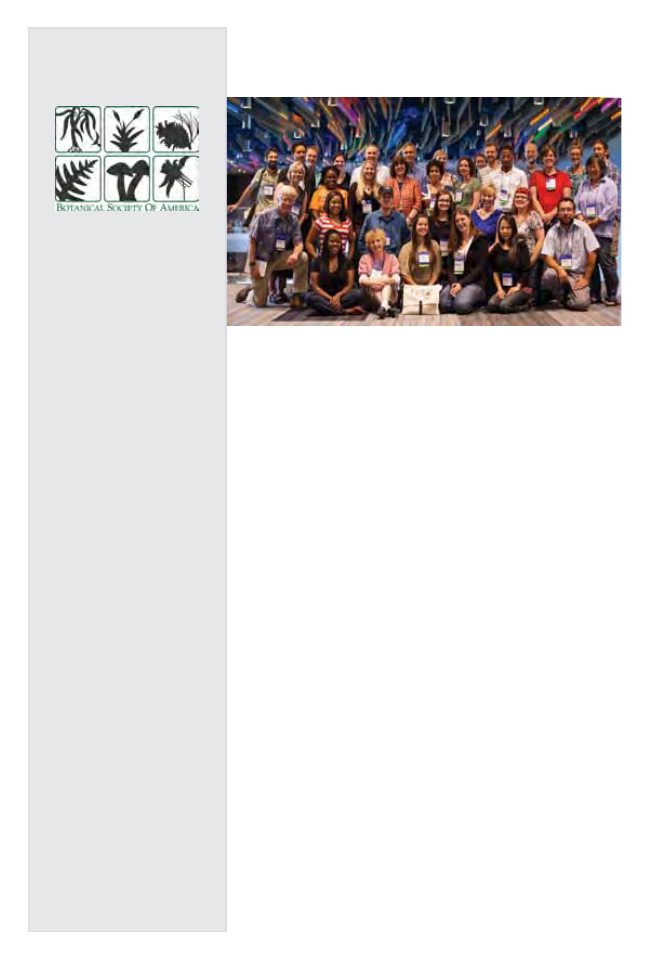
Plant Science Bulletin
Featured Image
Fall 2012 Volume 58 Number 3
Plant Science
Bulletin
ISSN 0032-0919
Published quarterly by
Botanical Society of America, Inc.
4475 Castleman Avenue
St. Louis, MO 63166-0299
Periodicals postage is paid at St.
Louis, MO & additional mailing
offices.
POSTMASTER:
Send address changes to:
Botanical Society of America
Business Office
P.O. Box 299
St. Louis, MO 63166-0299
bsa-manager@botany.org
The yearly subscription rate of $15 is
included in the membership
Address Editorial Matters (only) to:
Marshall D. Sundberg
Editor
Department of Biological Sciences
Emporia State University
1200 Commercial St.
Emporia, KS 66801-5057
Phone 620-341-5605
psb@botany.org
The Botanical Society of
America is a membership
society whose mission is to:
promote botany, the field of
basic science dealing with the
study & inquiry into the form,
function, development, diversity,
reproduction, evolution, & uses
of plants & their interactions
within the biosphere.|
The PLANTS Grant Recipients
The PLANTS program (Preparing Leaders and Nurturing
Tomorrow’s Scientists: Increasing the diversity of plant scientists)
recognizes outstanding undergraduates from throughout the US
who attend the BOTANY meeting, receive mentoring from graduate
students, postdocs and faculty, and participate in networking events
including the Diversity Luncheon and career-oriented activities. The
program covers the normal costs of travel, registration, and food and
accommodation at the meetings. This grant is funded by the Botanical
Society of America and the National Science Foundation. We will be
accepting applicants for the 2013 PLANTS program early in the new
year.
The 2012 PLANTS grant recipients are:
Dominique Alvis, University of Maryland-Baltimore - Advisor, Dr.
Mauricio Bustos
Haydee Borrero, Florida International University - Advisor, Dr. Suzanne Koptur
Maria Friedman, Humboldt State University - Advisor, Dr. Erik Jules
Erin Fujimoto, University of Hawaii at Manoa - Advisor, Dr. Tom Ranker
Victoria Hanna, University of California-Irvine - Advisor, Dr. Kailen Mooney
Sean Gershaneck, University of Hawai’i at Manoa - Advisor, Dr. Pattie Dunn
Lauren Gonzalez, University of New Orleans - Advisor, Dr. Charles Bell
Alexandria Igwe, Howard University - Advisor, Dr. Mary McKenna
Caprice Lee, University of California-Davis, Dr. Sharman O’Neill
Jamie Minnaert-Grote, George Mason University - Advisor, Dr. Andrea Weeks
Rylan Sprague, Black Hills State University - Advisor, Dr. Benjamin van Ee
Brittany Stallworth, Howard University - Advisor, Dr. Mary McKenna
Dori Thompson, Texas State University—San Marcos - Advisor, Dr. Garland
Upchurch
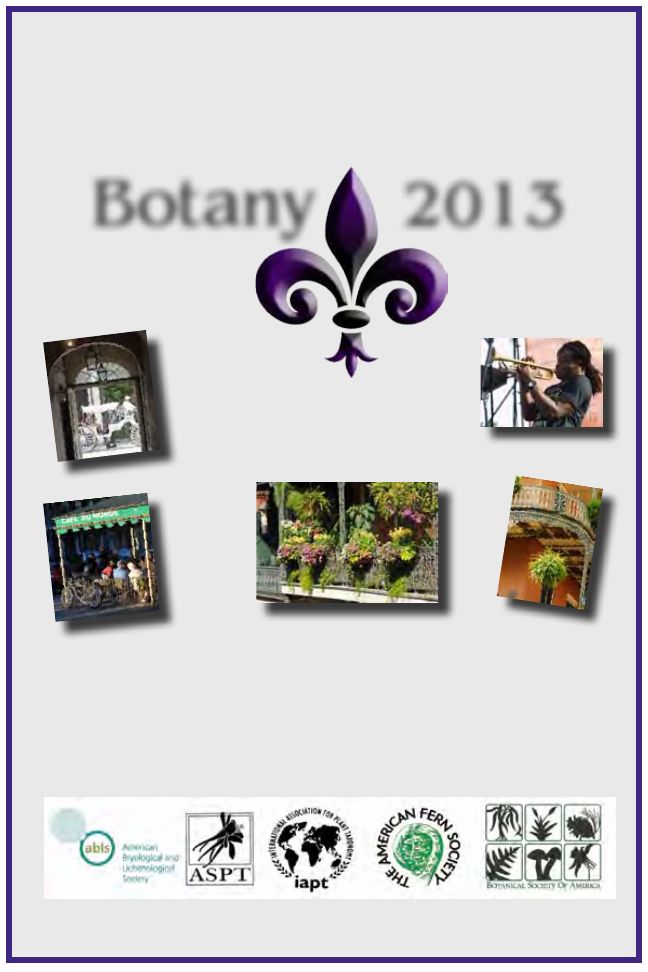
July 26-31, 2013
Hilton, Riverside
Botany
2013
Celebrating Diversity
See you in New Orleans......
Laissez les bons temps rouler!
Join these scientific societies for Botany 2013
Symposia Submission site opens September 1st
www.botanyconference.org